PART ONE. Thracians and Greeks
III. Odessos 49
3 THE THRACIAN INTERIOR BEFORE THE MACEDONIAN CONQUEST
II. Douvanli 58
(The Moushovitsa tumulus; The Koukouva tumulus; The Lozarska tumulus; The Golyama tumulus; The Arabadjiska tumulus; The Bashova tumulus)
III. Mezek 69
(Mal-tepe (Imanyarska tumulus); Other Mezek tumuli)
IV. Vratsa 76
4 MACEDONIAN AND HELLENISTIC INFLUENCES
II. The Panagyurishte treasure 85
V. Tumuli of Seuthopolis and the Kazanluk region 97
VI. Kabyle 103
VII. Beroe and its vicinity 104
VIII. Chertigrad 105
1 The Land and the People
The land of Bulgaria, less than half the size of Great Britain, emerges into history as the core of a much bigger area of south-east Europe inhabited by the Thracian people. To east and west - the shores of the Black Sea and the mountainous backbone of the Balkan peninsula - the boundaries of modern Bulgaria coincide with those of ancient Thrace. To the south and south-east, a large area of Thrace bordering the Aegean, the south-east shore of the Black Sea, and the Sea of Marmara falls within modern Greece and Turkey. To the north, except for a short land frontier across the Dobroudja, Bulgaria’s frontier with Romania is the Danube (Pl. 1). In early Antiquity the Danube, then known as the Istros or Ister, served as a unifying link between the Thracians living to the south and those whose territories reached into the Carpathians and the north-west hinterland of the Black Sea.
Within Bulgarian Thrace the dominating feature is the west-east mountain range known to the Greeks as the Haimos, today sometimes as the Balkan, but in Bulgaria usually called the Stara Planina, 'the Old Mountain’. Penetrated by only one river, the Iskur, the ancient Oescus, in the west, most of its passes, except in the extreme east, must have been closed during the harsher winters that then prevailed. Rising steeply from the south and descending gradually towards the Danube, tributaries of which cut steep gorges through its extensive karstic foothills, this range and not the Danube was the original dividing-line between north and south Thrace (Pl. 2).
South of the Stara Planina and protected by it from the northern winds lies the fertile Thracian plain, sometimes now called ‘the market garden of Europe’. At the end of the eleventh century, according to the Gesta Francorum, Bohemond and his crusaders found here ‘an exceeding abundance of corn and wine and nourishment for the body’. In prehistory this was one of Europe’s cradles of civilisation. The Thracian plain is watered by the river Maritsa, the ancient Hebros, which empties into the Aegean. Its numerous tributaries include the Tundja, the Greek Tonzos, the upper course of which drains the Valley of Roses lying between the Stara Planina and a lower, shorter range, the Sredna Gora.
The Thracian plain is bounded on the south by another west-east belt of mountains, penetrated by the Struma, the Greek Strymon, in the extreme west, partly by the neighbouring valley of the Mesta, the Greek Nestos, and decisively in the east by the Maritsa and Tundja. Between the Struma and the Maritsa stand the deep and intricately folded massif of dense forests, high fertile valleys, plateaux, and peaks formed by the Rila, Pirin, and Rhodope ranges. In the east the Rhodopes are lower, as are the Sakar and Strandja hills which extend to the shores of the Black Sea, but they were wide and high enough to hinder communication except where the rivers opened gaps.
The central region of west Bulgaria, in effect an abutment of the spinal massif of the Balkan peninsula, comprises a series of relatively high, fertile, and wellwatered mountain-ringed plains which can be termed collectively the Western uplands. The largest contains the modern capital of Bulgaria, Sofia, and has
24
![]()
![]()
25
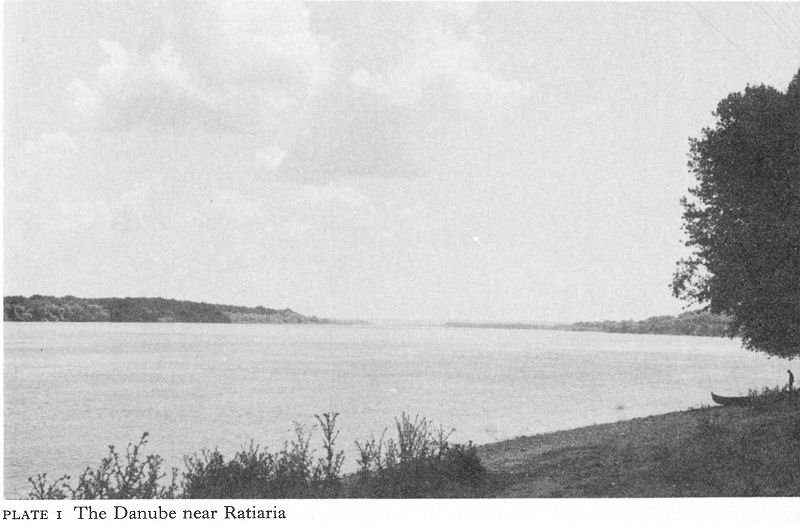
Plate 1 The Danube near Ratiaria
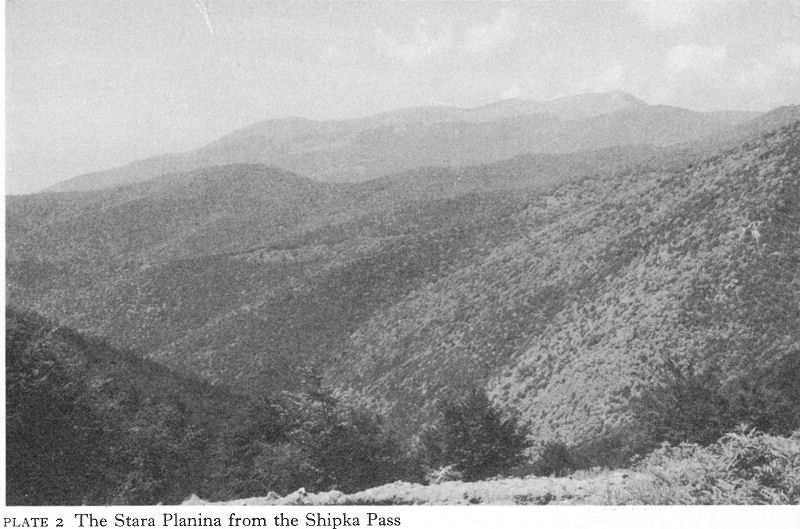
Plate 2 The Stara Planina from the Shipka Pass
![]()
26
always been an important centre of communications. The Struma valley, in places no more than a narrow gorge (Pl. 3), provides a route to the Aegean and others off it lead to northern Macedonia and to the Adriatic. To the north the Iskur links the Sofia upland with the Danube valley.
The Sofia upland is also crossed by the great highway which passes from Central Europe via Belgrade and Niš and on through the Thracian plain and the Maritsa gap to the Bosphorus and Asia. Often referred to as the ‘Diagonal’, it has had at least seven thousand years use.
The Thracians are identified as speaking a common Indo-European language with certain regional variations of dialect. They can also be distinguished from their neighbours by customs reflected in archaeological finds made in excavation of their settlements and burials. Such knowledge of the Thracian language as exists is mostly based on place and personal names and rare, brief inscriptions using Greek characters, for there was no written Thracian language (Pl. 4). Hence the historical sources are Greek or Roman, written with varying degrees of prejudice and accuracy from Greek or Roman viewpoints and consequently needing to be treated with appropriate reserve.
A difference can be observed between the Greek attitude towards the Thracians and their eastern neighbours, the Scythians. The Greeks preferred the latter. They lived far enough away for neither party to appear a danger to the other, and the agricultural riches of the Ukraine infinitely surpassed the resources of the much smaller Thracian plain. The profits of the Scythian trade are not only shown in the size and prosperity of the neighbouring Greek colonies, but also by the immense scale, in terms of wealth and ritual slaughter, of the Scythian royal graves.
The Thracians were not only a much less attractive commercial proposition; they were unruly, unreliable, and pugnacious, and Thraco-Greek antagonism dated at least as far back as the Mycenaean period: in the Iliad they appear as firm allies of the Trojans against the Greeks.
Excavations in Bulgaria have invariably shown a Thracian substratum beneath the Greek coastal cities. According to Strabo, the Black Sea colony of Mesambria (Nesebur) was the ‘bria’ - a Thracian word for town - of a chief named Mena. It is unlikely, certainly in the case of the earlier settlements, that the Thracians yielded their homes to the Greeks without bitter fighting. Homer’s description of an incident in the Trojan war could easily have been a piece of sixth- or fifth-century b.c. reporting. A Thracian captain Peiros, having first smashed the ankle of Greek Diores with a jagged stone, had despatched him with his spear. Whereupon
Aetolian Thoas hit him in the chest with a spear, below the nipple, and the bronze point sank into the lung. Thoas came up to him, pulled the heavy weapon from his breast, and, drawing his sharp sword, struck him full in the belly. He took Peiros’ life but did not get his armour. For Peiros’ men, the Thracians with the topknots on their heads (Pl. 5), surrounded him. They held their long spears steady in their hands and fended Thoas off, big, strong and formidable though he was. Thoas was shaken and withdrew. [1]
While prepared to view barbarians with disdain but equanimity from a distance,
![]()
27
the Greeks usually regarded the Thracians in the light of undesirable neighbours, as indeed they often were.
Herodotos, describing the Thracians as the most numerous of peoples after the Indians, comments on the chronic disunity which effectively prevented them from becoming the most powerful of nations. Indications of the main tribal groupings by Greek historians and geographers are understandably more vague about the lesser-known interior than the Aegean coast. Tribal territories, while based in general on geographical features, were probably subject to considerable variation. Smaller tribes or clans tended to attach themselves to larger groups, according to the prevailing situation.
South of the Stara Planina, based on the Tundja and lower Maritsa and extending over much of the Thracian plain and eastern Rhodopes were the Odrysai. Occupying the western end of the Thracian plain but chiefly based on the western and central Rhodopes were the fiercely independent Bessi. The Maidi controlled the middle Struma and the Dentheletai its sources;
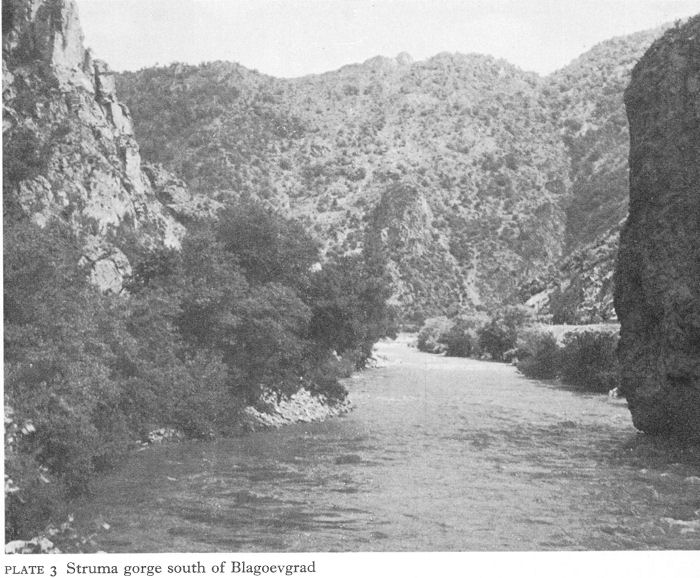
Plate 3 Struma gorge south of Blagoevgrad
![]()
28
the Serdi of the Sofia upland may have been a branch of the latter, but parts of the Western uplands were also inhabited by the Celtic Skordiski. North of the Stara Planina, the Triballi lived west of the Iskur-Vit (ancient Utus) divide, to the east of which were the Getai, the name given to a large group occupying both sides of the Danube. Herodotos calls them the most valiant and just of the Thracians, possibly a reflection of the better relations between the north-west Black Sea colonies and the local tribes than those enjoyed by most southern Greek settlements ; but the context suggests that the tribute may have been due to the Getai having been the first Thracians to oppose Darius during his preparations for the invasion of Greece.
Xenophon gives a characteristically vivid impression of the Thracian settlements he encountered during his service with Seuthes in what is now Turkish Thrace, [2] but archaeology is only now beginning to fill in the details of the picture and show if what he saw was typical. To take one example, a preliminary survey of Getic villages in north-east Bulgaria [3] suggests a general pattern of closely grouped small rectangular huts, half dug into the ground, constructed of clay on a wooden framework and roofed with thatch. Each hut had a yard with pits for rubbish and grain storage, enclosed by a wall or fence. Clearly marked postholes for the last match Xenophon’s description of Thyni villages in southeastern Thrace, where the houses were enclosed with high fences to protect the livestock.
Nothing which could be called a city (polis) has been identified in the interior before the Macedonian conquest of Philip II, although some larger settlements may have had an urban character in that they were markets or craft centres. Dry-stone-walled fortresses, making full use of natural advantages, were situated on low hills in commanding positions in or on the edges of the Thracian plain to serve as a refuge for neighbouring villages. In the more remote and less peaceful mountain areas, villages were often fortified. Most of the former have undergone an extent of destruction and rebuilding which has largely obliterated surface evidence of Thracian occupation. The inaccessibility of the latter, particularly in the Stara Planina and the Rhodopes, has afforded more protection, not least from the developer and those seeking an easy source of building material. Understandably, excavation has had a lower priority here than urgent salvage digs. Although some work has been carried out, for example at Chertigrad in the Stara Planina (p. 106) and at Boba on the Shoumen plateau, [4] and many other sites have been identified by surface finds in all mountainous areas, little is yet known about Thracian settlements in the sixth to fourth centuries.
More information comes from the tumuli or burial mounds dotted throughout the countryside - in 1942 estimated to number about fifteen thousand, although many had disappeared under the plough or through erosion - still eloquent witnesses of the funerary rituals associated with Thracian belief in life after death (Pl. 6). The earliest tumulus burials belong to the Bronze Age and there was a degree of continuity during the period known as ‘Early Iron’ or ‘Hallstatt’. New wealth acquired by the Thracian chiefs from the Greek trade gave a fresh impetus to this form of burial, as it did to an even greater degree among the Scythians. The conspicuous nature of the tumuli has made them obvious targets for robbers and although the problem of pin-pointing a burial in a mound perhaps 50 metres in diameter and 15 metres or more high has sometimes
![]()
29
defeated such attempts, the fact that wealthy Thracians were buried with rich items from the treasure they owned when alive - rather than with inferior substitutes as was often the custom in Greek graves - has been a constant spur to the fortune-hunter. But happily some have escaped.
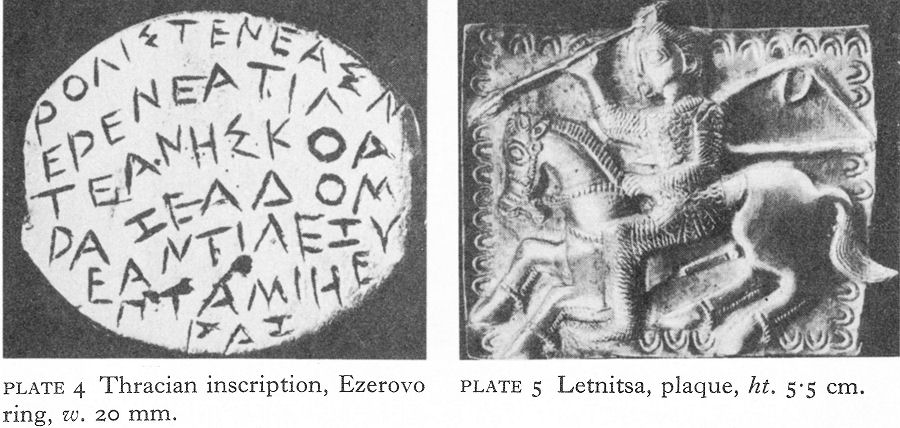
Plate 4 Thracian inscription, Ezerovo ring, w. 20 mm.
Plate 5 Letnitsa, plaque, ht. 5.5 cm.
Tumulus burial was common to all the Thracian tribes, but the construction of the tomb and of the mound varied considerably, as did the funerary ritual. Tumuli were built singly or in groups and closely or widely spaced. A large necropolis could cover a huge area. Dimensions varied; the present height may be no guide to the original and, although less subject to change, the diameter at the base varied enormously. Some tumuli were enclosed by a low retaining wall. The mound might consist of earth, sometimes mixed with rubble or pebbles, or a dry-stone cairn might enclose the tomb and the rest of the mound be of earth.
A large tumulus might contain several burials, sometimes occurring within a fairly short time of one another. The grave itself might be a pit, perhaps roofed or lined with branches or beams, or a stone construction of varying complexity, consisting of one or more compartments. In more elaborate stone tombs a tendency towards a north-south orientation has been observed, the entrance being to the south; houses were probably built in the same way. Cremation and inhumation were practised in the same necropolis and even in the same tomb: if grave goods rightly interpret the sex of the deceased, this was not a factor in the choice. The act of cremation was carried out either at the grave or outside the mound. Herodotos gives what may be an eyewitness report of a burial on the outskirts of a Greek colony:
The funerals of the wealthy among them are celebrated in this manner. They expose the corpse during three days; and having slain all kinds of victims, they feast, having first made lamentation. Then they bury them, having first burnt them, or at all events placing them underground; then having thrown up a mound, they celebrate all kinds of games, in which the greatest rewards are adjudged to single combat, according to the estimation in which they are held. Such are the funeral rites of the Thracians. [5]
![]()
30
Referring to the ritual of Thracian tribes in the west, Herodotos writes:
Those above the Crestonaeans do as follows: each man has several wives; when therefore any of them dies, a great contest arises among the wives, and violent disputes among their friends, on this point, which of them was most loved by the husband. She who is adjudged to have been so, and is so honoured, having been extolled both by men and women, is slain on the tomb by her own nearest relative, and when slain is buried with her husband; the others deem this a great misfortune, for this is the utmost disgrace to them. [6]
The picture presented by the Greeks of Thracian religion is confused. Herodotos describes the Getai as worshipping a single god and as believing in their own immortality. The Getic god was known by several names, one being Zalmoxis, and Herodotos recounts a Getic custom:
Every fifth year they despatch one of themselves, taken by lot, to Zalmoxis with orders to let him know on each occasion what they want. Their mode of sending him is this. Some of them who are appointed hold three javelins; whilst others, having taken up the man who is to be sent to Zalmoxis by the hands and feet, swing him round, and throw him into the air, upon the points. If he should die, being transfixed, they think the god is propitious to them; if he should not die, they blame the messenger himself, saying, that he is a bad man; and having blamed him, they despatch another, and they give him his instructions while he is yet alive. [7]
On the other hand, Herodotos refers to Thracian gods of tribes south of the Stara Planina by the names of members of the Olympic pantheon.
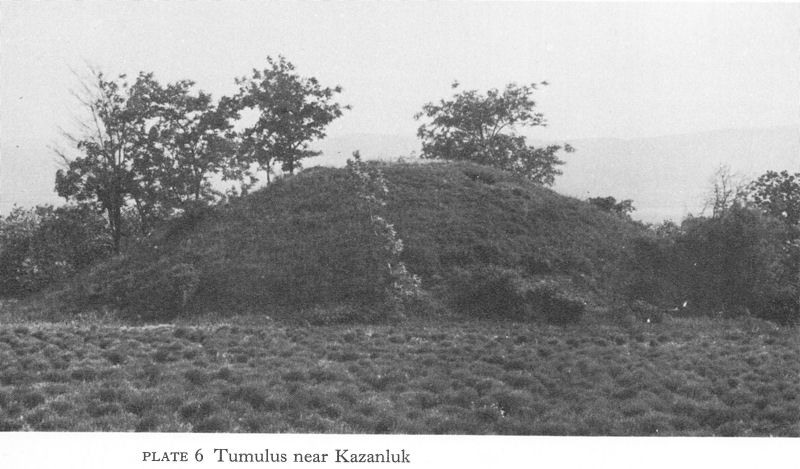
Plate 6 Tumulus near Kazanluk
![]()
31
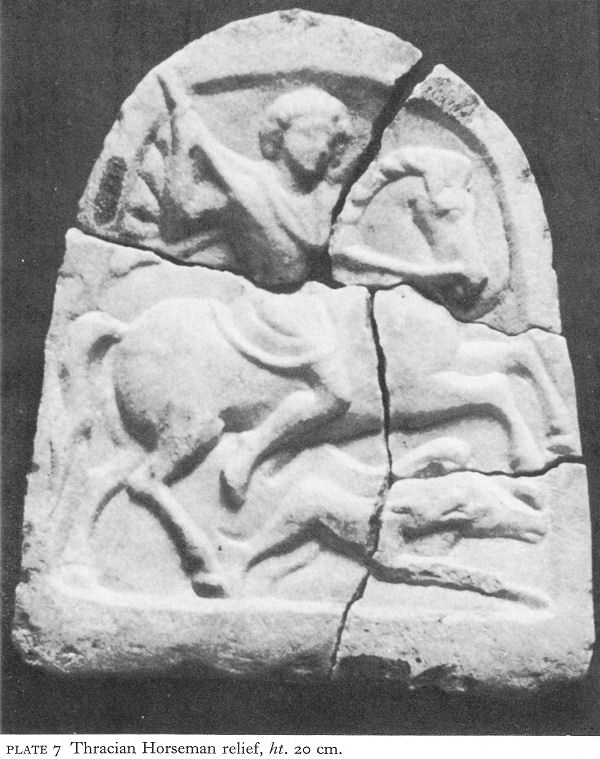
Plate 7 Thracian Horseman relief, ht. 20 cm.
Except for their kings, who, he says, worship Hermes as their supreme and ancestral deity, only Ares, Dionysos, and Artemis are acknowledged. Unlike his remarks about the Getai, it may be suspected that this information was second-hand, for these are manifestly Hellenised versions of Thracian deities. Hermes was the son of Zeus and guide of the dead, but perhaps also reflected the taxes extorted by the Thracian kings from the Greeks, as Ares the fighting qualities of the Thracians, ‘for whom to be idle is most honourable but to be a tiller of the soil most dishonourable; to live by war and rapine is most glorious’. [8] The extent to which the Greeks adopted and perhaps adapted the Thracian attributes and rites of Dionysos is unknown,
![]()
32
but in Thrace it is probable that he was essentially a fertility god. Artemis had many aspects; Bendis was, as far as is known, the only Thracian goddess; as such, hunting was one of her attributes and in this respect, but not necessarily in others, they corresponded.
The Thracians borrowed their religious representational art as well as their alphabet from the Greeks. Thus Thracian religion was further disguised by a fundamentally Greek iconography. It was not, as far as we yet know, the Thracians but the Greeks of Odessos (Varna) who built a temple to the Getic ‘Great God’ and certainly the Greeks who depicted him on their coins. ArtemisBendis, often represented with indistinguishable attributes, was another example of Greek syncretism.
An unquestionably, essentially Thracian religious figure is the Thracian Horseman or Hero, who first appeared in the Hellenistic period in the conventional iconography of a horseman riding slowly towards a goddess, and reappeared in the Roman period, when other iconographic forms were used, especially that of a hunter, usually on small relief tablets suitable for placing in a cave or other sanctuary. These icons, for such they were, often had a strong chthonic character, their votive and sometimes funerary purpose being basically consistent with a religion in which heroisation of a dead ancestor was an underlying theme. Their iconographic debt to Greece is impossible to estimate, especially since almost all known examples are relatively late in date; but association of the Thracian concept of immortality with the Thracian as well as Greek concept of heroisation is supported by the most common inscription: ‘Hero’. The horseman may alternatively or additionally be identified with one of the gods, most frequently Asklepios, but often Apollo and sometimes Dionysos; sometimes there is a Thracian epithet which cannot be surely translated. The icon-like quality of the small stone reliefs has helped to preserve them. Under Christianity they were reinterpreted as representing a new ‘hero’, St George, and in the early years of this century on St George’s Day peasants were still making pilgrimages and bringing sick people to be cured to one of Bulgaria’s main Thracian Horseman sanctuaries, one identified particularly with Asklepios.
NOTES
1. Homer, Iliad IV, trans. Rieu, E. V., The Iliad, Harmondsworth, 1950, 91.
2. Xenophon, Anabasis, VI 1,4.
3. Dremsizova-Nelchinova, Ts., Purvi Kongres na Bulgarskoto Istorichesko Drujestvo, Sofia, 1972, 1,335 ff.
4. Dremsizova, Ts. and Antonova, V., Iz Shoumen 1,1955, 5 ff.
5. Herodotos V,8, trans. Cary, H., Herodotus, London, 1901, 309.
6. Herodotos V,5, ibid., 308.
7. Herodotos IV,94, ibid., 268, 269.
8. Herodotos V,6, ibid., 308.
2 The Black Sea Cities
I. APOLLONIA PONTICA
Apollonia Pontica (Sozopol) was founded by Miletos towards the end of the seventh century. Strabo says the greater part of the city occupied an offshore island, which must have been the present Sveti Kyrikos, but it extended over the Sozopol peninsula and Greeks also settled on the Atiya peninsula, a few kilometres to the north. The site was evidently chosen for its two excellent harbours - the city’s emblem on coins was an anchor and a prawn - rather than trade. Its immediate hinterland was rugged and had no easy routes to the interior. The growing seaborne traffic plying the western Black Sea coast had shown the need for a port of call for revictualling and repairs between the Bosphoran harbours and such wealthy trading colonies as Histria and Olbia, established some half a century earlier farther north.
The Salmydessian coast of south-east Thrace between Apollonia and the Bosphorus had earned an evil reputation from its treacherously dangerous shores and the ferocity of the inhabitants. Aeschylus in Prometheus Bound describes Salmydessos as ‘the rugged jaw of the sea, hostile to sailors, stepmother to ships’. Xenophon goes into more detail:
In this part great numbers of ships sailing into the Euxine get stranded and wrecked since there are sandbanks stretching far out to sea. The Thracians who live here put up pillars to mark their own sectors of the coast, and each takes the plunder from the wrecks on his own bit of ground. They used to say that in the past, before they put up the boundary marks, great numbers of them killed each other fighting for the plunder. Round here were found numbers of couches, boxes, written books and a lot of other things of the sort that sailors carry in their wooden chests. [1]
No wonder Apollonia prospered. The colony, like others, must have had agricultural land, and good profits could be made from servicing storm-damaged shipping, supplying provisions, and providing recreation facilities for the sailors. Thence it developed as a point of transhipment and exchange of luxury goods manufactured in the Greek cities of the Aegean, notably pottery, textiles, jewellery, and wine, for raw materials such as grain, salted fish, hides, and flax from the rapidly increasing number of colonies dotted along the north-western and northern coasts of the Black Sea. Late in the sixth or during the fifth century, Apollonia successfully fostered dependent settlements in its vicinity, the most important, probably, being Anchialos (Pomorie), a valuable source of salt north of the Gulf of Bourgas.
With much coastal erosion and the picturesque tourist resort of Sozopol overlying the original city, opportunities for excavation have been small. A hoard of blunted copper arrowhead currency on the Atiya peninsula may reflect early dealings with the Asti tribe within whose territory the settlement lay, [2] and who almost certainly previously inhabited Apollonia. The earliest relics of the Greek city came to light during the dredging of the harbour in 1927.
33
![]()
![]()
34
Of the substantial quantity of mostly fragmented pottery almost all the sixth-century pieces were imports from Ionia, Rhodes, and Samos. One complete and fragments of two more funerary stelai, or grave stones, of the same period were also recovered. All three show an enthroned female figure, a Cybele, Demeter, or other ‘great goddess’. In the complete stele (Pl. 8) she appears to be resting a bowl, held in her right hand, on the arm of her seat. The primitive sculptural form is impressive; classic proportions are absent and drapery is indicated schematically. A terracotta figurine ascribed to the third quarter of the sixth century portrays a gracefully proportioned and executed version of a similar goddess. Found on the Atiya peninsula were headless fragments of a fine marble male statuette from the same period possessing a Late Archaic simplicity (Pl. 9).
After the ejection of Persia from Europe in 478 b.c., control of the Black Sea trade passed to Athens and Ionian imports dwindled to a trickle. A chance find in 1895, probably belonging to the beginning of this period, is the funerary stele of Anaxander, identified by a brief inscription at the top, showing a man leaning on his stick and gazing down at his dog, which stretches up on its hind legs to accept something from his hand (Pl. 10). [3] The subject was popular in the Greek world from the end of the sixth century, but, whilst the tall, narrow shape was in vogue during its last three decades, the strong stylistic resemblances with the stele from Orchomenos by Alxenor of Naxos in the National Museum of Athens, which is attributed to the first quarter of the fifth century, suggest the Apollonian stele was Greek work imported in the second quarter of the century. There are still traces of Late Archaic style in the rendering of the hair and drapery, but the peaceful realism and rhythmic composition bring it within the classic tradition.
Athenian commercial instincts were probably responsible for the development of trade with the hitherto neglected interior by such subsidiary colonies as Anchialos and Sladki Kladentsi, a site 3 kilometres west of Bourgas of which the antique name is unknown where two stores of commercial amphorae, large twohandled earthenware containers used for wine or oil, have recently been found. The success of this policy is reflected by finds of fifth-century Apollonian coins as far west as the Stara Zagora region and by the city’s power to commission a colossal bronze statue of Apollo, 30 cubits (13.2 metres) in height, from the famous sculptor Kalamis. The temple of Apollo the Healer, the Milesian patron god, stood, presumably, on Sveti Kyrikos, and fifth-century architectural fragments, among them part of a frieze of rigidly profiled warriors now in the Louvre, [4] may have belonged to this sanctuary. Athenian ascendancy is also reflected in fifth- and fourth-century pottery dredged from the harbour.
Two of the city cemeteries were partially excavated between 1946 and 1949. The major site was part of a necropolis extending for at least 4 kilometres along the road running south from the city. The excavation area, known as Kalfa, is close to the shore about 2 kilometres from Sozopol and now consists of sand dunes, beneath which some 900 graves were uncovered in a strip about 150 metres long and 10 to 30 metres wide. Although the shifting nature of the dunes gave no help in dating by depth from the surface, compensation was provided by stratification; in some places as many as n graves occurred within a depth of 5 metres. The second was a smaller excavation; in an area about 20 metres long and between 10 and 20 metres wide about a hundred graves were found.
![]()
35
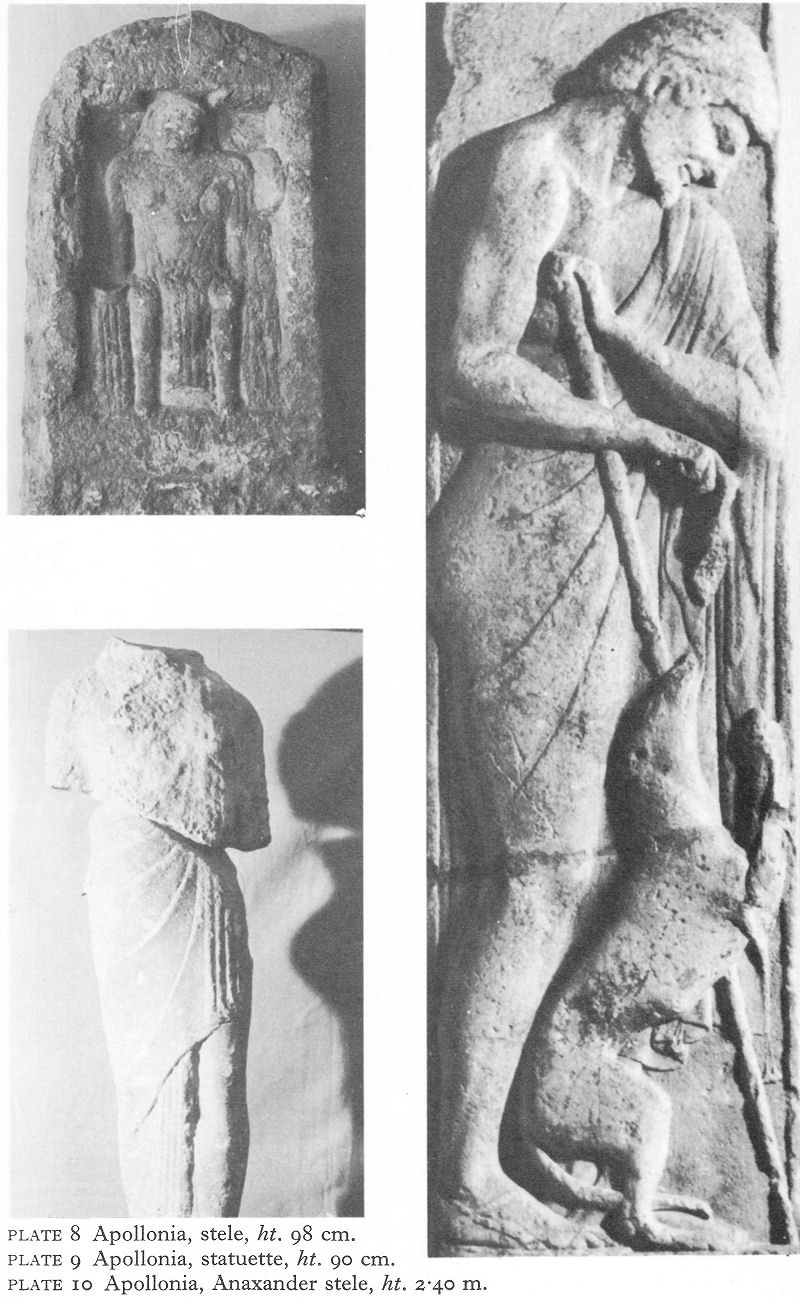
Plate 8 Apollonia, stele, ht. 98 cm.
Plate 9 Apollonia, statuette, ht. 90 cm.
Plate 10 Apollonia, Anaxander stele, ht. 2.40 m.
![]()
36
It lay much closer to the old city, by what is now called the Morska Gradina or Marine Gardens. Burials found here began about the middle of the first half of the third century and ceased after about a hundred years. The results of both excavations have been fully published and reflect the fluctuating history of the city and lives of the citizens over several centuries.
Apollonia’s first or Ionian phase is not represented at Kalfa. Graves of this period would have been nearer the city and, since sixth-century stelai have been recovered from the channel between Sozopol and Sveti Kyrikos, they may have been in land now eroded by the sea. Another cemetery may also have existed between Sozopol and the Atiya peninsula.
Chronologically the excavators divide the graves into three main phases: the first, beginning about 460 and lasting a hundred years; the second, from about 360 to 290; and the third, from about 290 to 175. Inhumation predominated throughout, only 11 cremations being noted. The skeletons normally lay stretched out on their backs, arms alongside the body, in the common Greek manner, and were oriented in no particular direction. Wooden coffins were usual, sometimes above them gabled tops consisting, in the case of adults, of four pairs of large square tiles, with similar tiles placed upright to close each end.
Only 22 stone tombs were found. Cists built of cut stone blocks, these were flat-topped and seldom much larger than the coffins. Two children’s graves were built side by side with a surround-wall. The stone tombs belonged to the second phase, the earliest of them being attributed to the mid-fourth century and the majority to the late fourth or early third. Some were re-used, even into Christian times. Eleven older children were buried in pithoi, or large wide-bellied storage jars, and 17 babies in amphorae - these are dated to the second half of the fourth century.
Seven crouched burials were exceptions to the normal manner of inhumation; five had both arms and legs bent up to the chin, in the other two the arms were missing. They are dated to the latter part of the fourth or early third century and may perhaps have been of Thracians who retained their ancient ritual, as happened in Black Sea cities farther north, although among the Thracians generally this form of burial is typical of a much earlier period.
The 11 cases of cremation are also attributed to Thracians. These are dated to the mid-fourth century or later; the body seems usually to have been burnt elsewhere and the charred bones then placed in clay urns, exceptions being a red-figure krater, or deep wide-mouthed bowl for mixing wine with water, and a cylindrical stone urn with a stone lid. One adult cremation was contained in two bowls of about the same size, one upside down serving as a lid. With the much-burnt bones were eight small objects of fired grey clay of different shapes, including a spindlewhorl, a weight, a miniature bowl, a bead, and what was perhaps a primitive figurine, which alone showed traces of burning. These were probably magic objects and occur in some burials elsewhere (p. 64).
The inventories and the value of the grave goods varied from period to period, and significant differences occur between richer and poorer graves. Besides vessels for eating and drinking, the former contained toilet accessories and other luxuries; children had toys. The latter might have only one rough, locally-made pot or nothing at all. Nevertheless, the absence of architecturally outstanding graves is matched by the quality of the goods placed with the corpses.
![]()
37
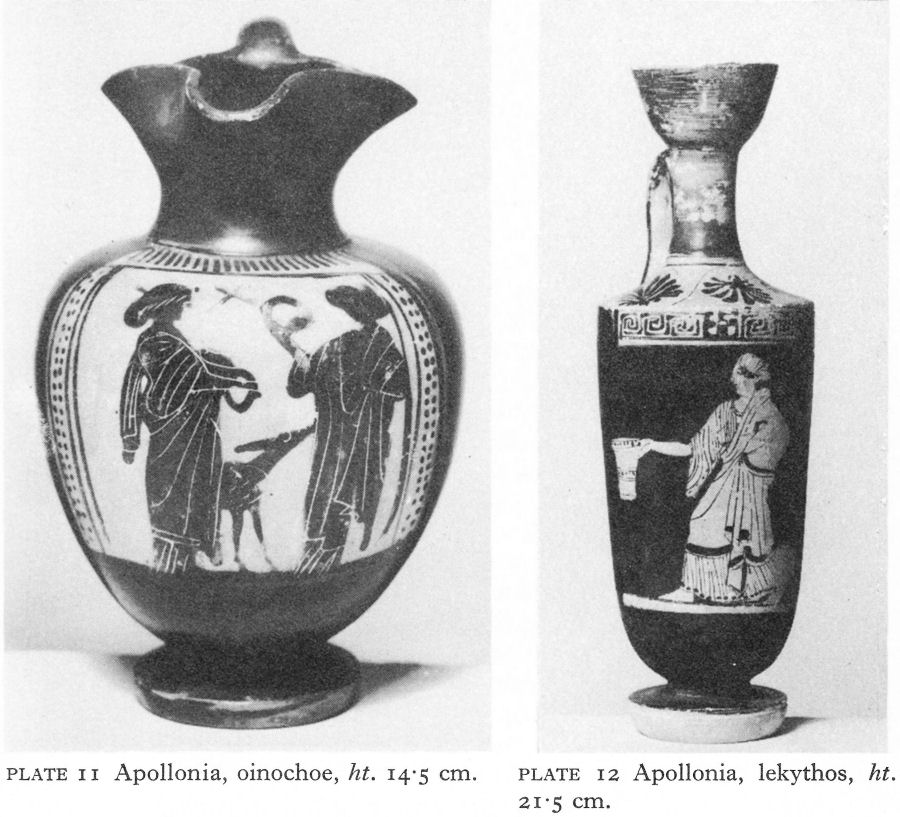
Plate 11 Apollonia, oinochoe, ht. 14.5 cm.
Plate 12 Apollonia, lekythos, ht. 21.5 cm.
Plato would have approved the lack of funerary ostentation shown, but the explanation may be either that the élite of the city were buried elsewhere or simply that the population basically consisted of small traders and middlemen. The relatively little jewellery found, particularly in the earlier graves, may, of course, be due to theft. About 30 stelai were recovered, still above the graves. Most bore no more than the two names of the deceased.
The intensification of trade with the Thracian interior to provide Athens with raw material she could no longer obtain from Asia Minor and the ensuing prosperity of Apollonia are reflected in the funerals of about 460 to 430. Almost all the pottery, averaging some four objects to a grave, although very occasionally reaching a score, was imported from Attica; the few exceptions were probably left over from the Persian occupation. Only one piece of Ionian ware occurs in a grave later than 430. Most of the pots were for everyday use and of little artistic merit. Nevertheless, a black-figure Attic oinochoe, or wine-jug, of about 470 was found in a grave of the second quarter of the fifth century. Made of fine light brown clay, it shows Artemis and Apollo against a light red rectangular ground, the remaining surface being decorated with a black glaze (Pl. 11). There were also a number of red-figure lekythoi, or small narrow-necked jugs for scented oils, generally showing women at their toilet or otherwise occupied in the home, like the lekythos illustrated in Pl. 12, found in a child’s grave and dated to the
![]()
38
third quarter of the fifth century. In a grave of the same date were two blue glass aryballoi, or globular vases; a quantity of black-glaze pottery which included four kylikes, or shallow two-handled wine-cups, turned upside down, evidently a ritual act; two aryballesque lekythoi; and terracotta figurines of Aphrodite, Demeter, and Silenus - two of the last, one of especially fine clay, representing him with breasts, an enlarged belly, and genitals.
The only 80 terracotta figurines discovered all belong to these three decades. Some were toys, but in certain richer tombs they were associated with a ritual hearth, where, after a funeral banquet, animal and fish bones, fruit stones, and pots were tossed on to the bonfire. The custom of breaking pots at a funeral was also a contemporary practice in the Thracian hinterland.
After 430, terracottas disappear and grave goods generally become fewer and inferior in quality, although almost all are still Attic imports. Athenian trade continued, on a reduced scale; not only did Athens have troubles, but, after the death of Sitalkes in 424, the Odrysian state, which had been favourable to Athens and had provided stable conditions for trade, began to disintegrate. Nevertheless, early fourth-century finds include a red-figure bell-krater displaying satyrs and maenads on the front and three youths on the back, which, together with a similar Vase found in a Thracian tumulus in the Mezek area, is attributed by Sir J. Beazley to the Black Thyrsus painter. [5] Also from the first half, probably the second quarter, of the fourth century comes the only painted stele - a sandstone slab 172 metres high excluding the wedge base - found in any west Black Sea city (Fig. 1). The elaborate architectural design on the upper part incorporates a pediment occupied by a picture, probably of a siren.
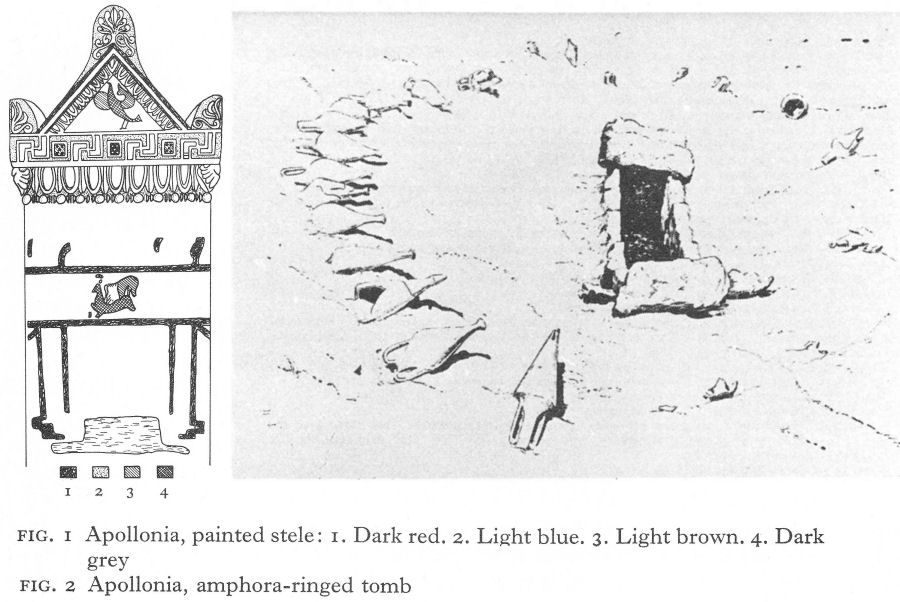
Fig. 1 Apollonia, painted stele: 1. Dark red. 2. Light blue. 3. Light brown. 4. Dark grey
Fig. 2 Apollonia, amphora-ringed tomb
![]()
39
In the upper part of the stele is a separate area divided off by two [horizontal] red lines, in which a stag is shown, attacked by a lion. Both pictures are much damaged and their details indistinguishable. So far as one can tell, the stag is dark blue and the lion light brown. There are four vertical red lines along the slab which are perhaps the outlines of two columns. Between them at their base is a two-line inscription, illegible because of the perishable nature of the stone but no doubt the name of the deceased. Above the red horizontal lines are other traces of red ornament. [6]
The middle of the fourth century saw a revival in Apollonian prosperity, but there is some evidence of trouble in the unusual feature of a number of mass burials without grave goods. They may have been due to a natural disaster, but could have been connected with the Macedonian arrival. Apollonia entered into an alliance with Philip II, who successfully exploited Thracian disunity to reduce the Odrysai and their rivals to varying degrees of subjection. However, the archaeological evidence from the Kalfa necropolis suggests that the city’s brief renewed prosperity was between the years 360 and 340 - before the peak of Macedonian power - when Athens was making fresh efforts to exploit the Thracian trade, her commerce interrupted with Egypt as well as Asia Minor. To these two decades are attributed many flamboyantly decorated ‘Kerch-style’ vases; these were mostly lekythoi, often aryballesque, but included other forms as well. Manufactured in Athens between 380 and 310, largely for the Scythian and Thracian export market, the polychrome colouring, extending to the use of white, blue, pink and even gilding and barbotine work, hardly conformed to Athenian taste. The subjects were preponderantly domestic scenes from the women’s quarters, often including Eros. Others showed children with toys or the household dog, youths in the gymnasium, and scenes from Greek mythology with an apparent emphasis on Dionysos. A large lekythos depicting Demeter, Persephone, Triptolemos, Dionysos, and Hermes is an example of a group of vases especially associated with Apollonia. [7]
The next half-century, beginning about 340, saw the slow decline of the city. Until 320 the Kerch-style lekythoi continued to be plentiful, but thereafter all imported objects became noticeably fewer. With the ascendancy of Macedonia and Alexander’s ejection of the Persians from Asia Minor, the links with Athens inevitably weakened. Amphora stamps suggest intensified trade with Heracleia Pontica during the second half of the fourth century, no doubt an attempt at diversification; but by its last quarter the regular use of ships capable of the direct north-south sea route across the Black Sea had undermined the foundations of Apollonia’s economy. The city’s first bronze coins were minted in 350 and soon they replaced silver ones in many graves.
Aristotle in his Politeia quotes Apollonia as an example of factional dispute following the admission of new settlers into a city. Whence and when these came is not specified, but during this half-century there are signs of the lowering of barriers between Greeks and Thracians. Thracian fibulae, or brooches, appear for the first time in the necropolis in the second half of the fourth century, as well as the fragile funerary garlands of gilded clay grapes or raspberries, rosettes, and ivy leaves that were fashionable among Greeks and Thracians alike towards the end of the century,
![]()
40
and there is a sudden profusion of local pottery. During the whole period between 360 and 290 about a quarter of the clay vessels found in graves are local work, including painted clay imitations of the earlier alabaster or glass Egyptian-type alabastra (small vases for unguents or perfumes). After two centuries of importing everything but rough kitchenware, Apollonia had to fall back on its own or other local resources.
A funerary ritual unique here is attributed to this period. In a circle of 7 metres in diameter enclosing a stone-built tomb, 27 amphorae were arranged, mouths outwards, level with the roof of the tomb (Fig. 2). Inside the tomb only a grey clay pot and a fragment of a bronze strigil, or perspiration scraper for use by athletes and after bathing, accompanied the skeleton. Thirteen of the amphorae were fairly well preserved and, whilst without stamps, are considered to be Thasian types of the second half of the fourth or the beginning of the third century. A similar circle of amphorae was found nearby in a very early dig; another occurs round a cremation burial at Olbia.
The third stage of Apollonia’s existence marked by these graves began about 290, about three-quarters of the way through the long reign of Lysimachos. The Greek colonies now served as garrison towns and at the end of the fourth century and the beginning of the third graves of soldiers, buried with their weapons, occur. Now, too, a new burial ritual appears, in which the coffined body and grave goods are placed in an immense earthen jar.
By the end of Lysimachos’ reign in 281, Apollonia, politically and economically, had fallen behind the neighbouring Megarian colony of Mesambria. The Celtic invasion and occupation of much of south-eastern Thrace was a further blow. Apollonia was not captured, but a fragmentary inscription in Doric dialect found in the city is generally interpreted to mean that it had been forced to join Mesambria to seek from Antichos II Theos aid against the Celts. [9] Contemporary inscriptions from Mesambria, Kallatis (Mangalia), and Histria refer to the granting of proxeny or honorary citizenship to Apollonians, suggesting a possible exodus of some of the wealthier and more timorous.
During the final phase represented in these excavations, the Kalfa site must have been too distant from the city and the Morska Gradina cemetery came into use. From here came one of the very few carved stelai. Third-century in date and probably commemorating a warrior killed in battle, [10] it shows a young man with two spears in his left hand and his right resting on a herm, a quadrangular pillar, usually decorated with genitals and surmounted by a bust. The inscription below is almost entirely lost (Pl. 13). The stele was not connected with any known grave.
Many Morska Gradina graves of between the second quarter of the third and the second quarter of the second century had no grave goods at all. In a few, some imported objects, such as Megarian bowls and some gold ornaments, were found, but almost all the pottery was local. Tile-roofed graves continued. A relatively rich cremation burial may indicate the status achieved by Thracian members of the community.
The liquidation of the Celtic kingdom in 218 revived the old antagonism between Apollonia and Mesambria. According to an Apollonian inscription, of which a fragmentary copy was found at Histria, at some time in the first half of the second century Mesambria captured Anchialos and then its fleet, suddenly
![]()
41
appearing before the walls of Apollonia, looted and profaned the temple of Apollo, although failing to take the city. The rescue of Apollonia and the defeat of Mesambria with the aid of forces from Histria is also recorded. [11] Apollonia was among the cities allied with Mithridates of Pontos against Rome in the first century, probably playing only a modest part. Fierce resistance to the Roman forces under M. Terentius Varro Lucullus in 72 b.c. is said to have brought destruction on the city and its fortifications. Pliny relates that the ‘tower-like’ bronze statue of Apollo by Kalamis that for four centuries had symbolised the greatness of Apollonia was shipped to Rome to adorn the Capitoline.
II. MESAMBRIA
Towards the end of the sixth or at the beginning of the fifth century the Milesian monopoly of the west Black Sea coast was broken by a Megarian settlement. Mesambria or Mesembria Pontica (Nesebur) - both names were used in antiquity - was probably a foundation of the earlier Megarian colonies of Byzantion and Chalcedon on the Sea of Marmara. Its present name has evolved with little change from that given it by the Greeks and Thracians.
North of the Gulf of Bourgas and immediately south of the last eastern spur of the Stara Planina, the colony occupied a peninsula now only 850 metres long and 300 metres wide, linked to the mainland by an isthmus so low and narrow that artificial banking was needed to make a modern road. Steep cliffs, subject to erosion, protect the north and east coasts, but on the south the land slopes gently to the sea. The situation offered easier access to the interior than Apollonia possessed, as well as fairly low and easy passes facilitating trade with the north.
The colony was probably the result of a succession of migrations from the Persian threat, which may account for a more independent economic development than that of Apollonia - one of a planned series of settlements in a time of peace. By about the middle of the fifth century economic prosperity was shown by the issue of coins. Naulochos (Roman Templum Iovis, modern Obzor), just north of the Stara Planina, was an early offshoot of Mesambria.
No major excavations have taken place in modern Nesebur, with its confined, densely populated area and its long history as a busy maritime town. But 20 relatively large-scale soundings between 1944 and 1964 have identified three distinct cultural layers prior to the Turkish period. The earliest was Thracian; it included both Bronze and Early Iron Age material, but extended over only part of the peninsula and varied from 20 centimetres to 2 metres in depth. Next, several metres thick and overlying the whole peninsula, was a Greek layer, distinguished by its pronounced yellow colour, caused by the disintegration of the mud bricks used to build houses. The third layer contained remains from the Romano-Byzantine period. Large stretches of the original Greco-Hellenistic ramparts have fallen into the sea or been otherwise destroyed, but short sectors, particularly near the isthmus, have been excavated. At the site of a necropolis which stretched several kilometres along the coast towards the south-west, there has also been some excavation, although, apart from early chance finds, these have been mostly salvage digs before refugees were housed here in the 1930s.
There is little doubt that the Greek colony was encircled by a fortified wall at an early stage. Almost all the north-eastern sector and perhaps also an acropolis have been eroded.
![]()
42

Plate 13 Apollonia, stele fragment, ht. 36 cm.
Plate 14 Mesambria, pre-Hellenistic city wall
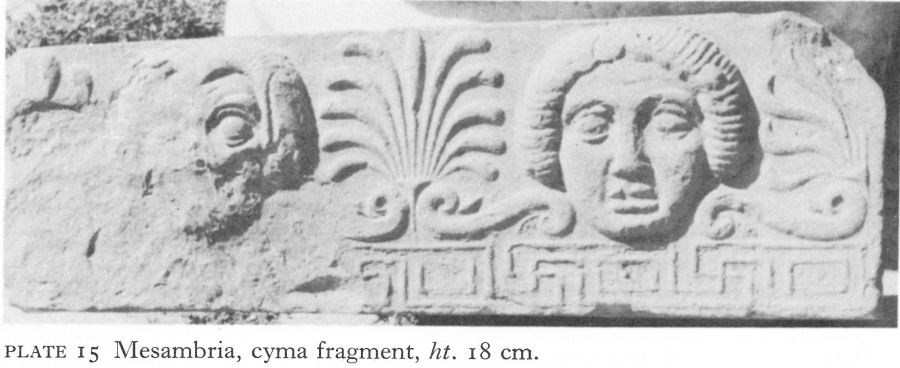
Plate 15 Mesambria, cyma fragment, ht. 18 cm.
Some slight impression of the damage can be gained at the site of the Sea Basilica, the north nave of which now lies at the bottom of a sheer cliff (Pl. 189). The narrow western shore facing the mainland has been more fortunate in suffering only from man.
Here the gateway, through which runs the road into the town, dates from the Romano-Byzantine period, but some remains of the earliest ramparts have been excavated nearby, following a line very close to the later walls. The lowest and first building period is dated to the fifth or, at latest, early fourth century. With foundations 2 metres deep, the outer fapade is dry-stone walling, generally using ashlar blocks of varying size, irregularly laid, but here and there strengthened by hooking one block into its neighbour, or, more rarely, laid in regular courses of unequal height. In the second building period, tentatively assigned to the fourth century, the isodomic method was used, the courses regular and of equal height. In the third period, stability was ensured by laying the blocks in courses to expose long sides and ends alternately, a system to gain added strength
![]()
43
perhaps introduced by the end of the fourth century, but common throughout the later Hellenistic era. This substantial facade was backed by an emplecton, or fill, of broken stone and yellow clay like that used for the bricks of the houses. As only parts of the emplecton have survived and nothing of the inner facade, the thickness of the wall is unknown. There were also no signs of towers. A short distance east of the Byzantine north-west angle tower an early sector of the north ramparts was found. Finely jointed ashlar blocks, rectangular or trapezoidal in shape, are laid without mortar in nearly even courses, with some of the blocks hooked to the next. The emplecton contained fragments of archaic Attic pottery and this wall is regarded as another sector of the original fortifications (Pl. 14). A later repair made use of a fourthor third-century Doric capital.
Soundings located several houses in the Greco-Hellenistic layer; the earliest, attributed to the fifth century, has still to be published. Building levels were distinguished by superimposed floors with evidence of habitation between them. Four Hellenistic houses had peristyles, probably with wooden pillars, and stood apart from their neighbours. Outside walls were coated with a plaster of fine lime and sand, with painted decoration in various colours, including Pompeian red, yellow ochre, green, and black. About a quarter of one Hellenistic house was excavated. Fragments of black-figure vases and sixth-century Chian amphorae were found beneath the floor, together with part of an inscription mentioning a sanctuary of Apollo. The excavated sector consisted of an irregularly paved and peristyled rectangular courtyard and rooms on the north and east sides. In the north wing a stone staircase with six steps making a right-angled turn descended into a cellar with stone walls 2-20 metres high. The debris of the collapsed upper parts of the house consisted of tiles, decomposed mud bricks, and fragments of stucco, painted red, blue-black, white, and in imitation of marble. There were also Mesambrian coins of the fourth to second centuries, terracottas, and ceramic fragments, including a mould for a ‘Megarian’ bowl. Built towards the end of the fourth century, the house was apparently reconstructed in the second. An interesting point about some of the building materials is an almost certain link with Olbia, a link also shown by decrees erected in the latter city. Fragments of fourthcentury Mesambrian cymata, or curved architectural mouldings, bear the same stamp as is found on Olbian tiles and, on the basis of Mesambrian material, much of it unpublished, I. B. Brashinsky recognises close analogies between cymata and ornamental frontal tiles of both cities (Pl. 15). [12]
Although some building material may have been imported, Mesambria possessed its own industries, to a much greater degree, on present evidence, than Apollonia. Besides finished objects, remains of two furnaces were discovered close to the Hellenistic house. The remnants of one, together with the discovery of a ‘Megarian’ bowl mould in the nearby house, suggest that it was a pottery kiln. The construction of the better-preserved furnace, the quantity of slag in its vicinity, and holes in the ground suitable for melting ingots, all pointed to a metallurgical purpose.
Close to the house and furnaces was the bothros, or sacrificial pit, of a temple. The contents, dating from the fifth to the third centuries, included fragmentary inscriptions which indicate a sanctuary of Zeus and Hera. No early public buildings have yet been found, but epigraphic evidence shows that the chief temple was dedicated to Apollo, probably Pythian Apollo,
![]()
44
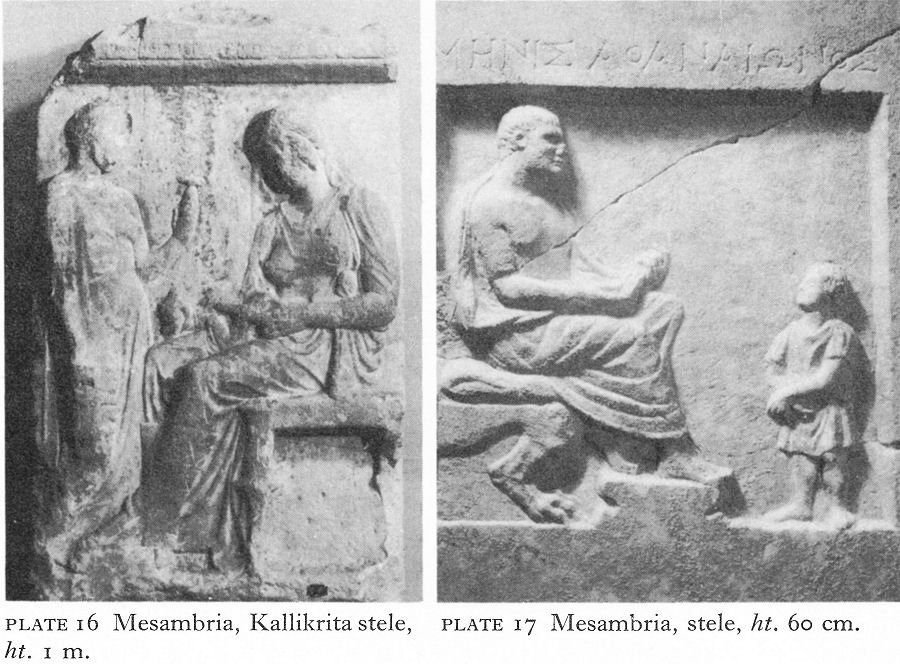
Plate 16 Mesambria, Kallikrita stele, ht. 1 m.
Plate 17 Mesambria, stele, ht. 60 cm.
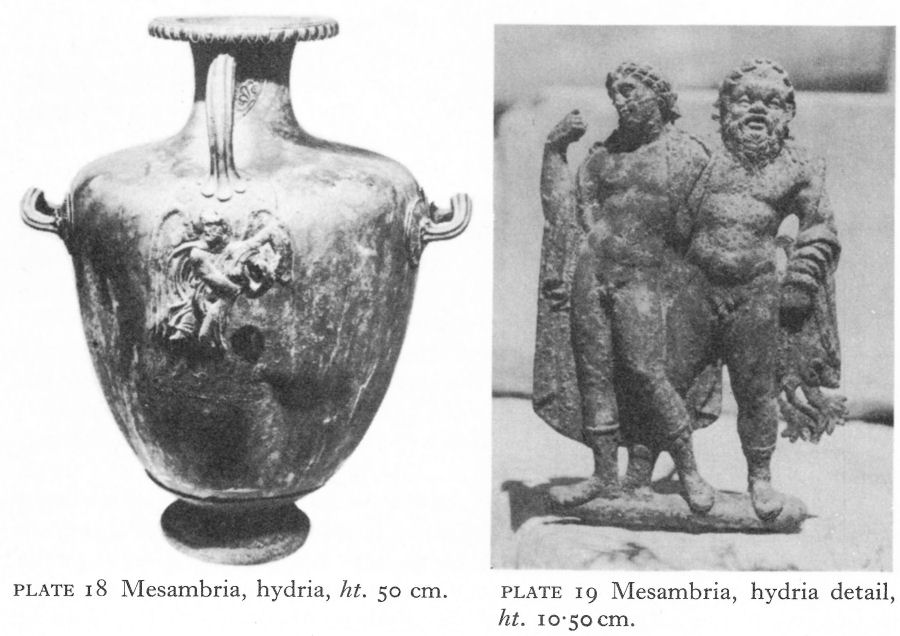
Plate 18 Mesambria, hydria, ht. 50 cm.
Plate 19 Mesambria, hydria detail, ht. 10.50cm.
![]()
45
much honoured in Megarian colonies and to whom was addressed a second- or third-century a.d. votive tablet of the Thracian Horseman found in the city. Dionysiac rites are attested by several inscriptions. Two, one of which had been erected in the temple of Apollo, refer to the ceremonies taking place in the city’s theatre. Other inscriptions indicate special attention to the cults of Athena Sotira, Demeter, Hekate, and the Dioskouri. From the third century onwards, and especially about the first century b.c. when the presence of refugees from Egypt offers a ready explanation, there are references to Isis and Serapis.
Aspects of Mesambrian life touched upon in other, mostly fragmentary inscriptions, include a probably third-century decree declaring free entrance to the harbour in times of peace or war; a treaty with a Thracian chief, Sadalas (p. 48); praise of a person who provided grain cheaply to the Mesambrians; and a late third-century decree honouring a woman, unfortunately so fragmentary that both her name and her virtues remain unknown. It is the earliest official honour paid to a woman found on the west Black Sea coast and an unusual feature at this time in a Greek city.
The approximate site of the mainland necropolis has long been known. More than fifty years ago, I. Velkov wrote:
Over an extent of 2 to 3 kilometres the whole area is strewn with broken stone and brick and fragments of antique pottery. In some places there are larger accumulations of such fragments and more massive stones. Antique coins are always to be found here, especially after a spell of strong wind. [13]
Large numbers of the burials were direct interments into the earth and in an area subject to constant weathering and habitation through the ages they were easily destroyed. By 1964 less than a hundred tombs had been identified, most through chance or the salvage digs of the 1930s. They were mainly inhumations of the fourth and third centuries, laid in variously oriented rectangular tombs, little larger than coffins, built of thick stone slabs smoothed on the inside but only roughly shaped on the outside; horizontally laid slabs formed the roof. Exceptions included a gabled tomb, like those at Apollonia but with two large limestone slabs balanced over the corpse instead of tiles, and double tombs, divided merely by a partition wall. Another possessed a small ‘antechamber’ with closed walls of three single slabs attached to the main compartment with no facility for intercommunication. Robbers had removed the grave goods, but charred embers and burnt potsherds in the ‘antechamber’ suggest a sacrificial purpose. Similar tombs were found in Thracian cemeteries in north-east Bulgaria. The tomb with the richest grave finds (see below) was also one of the largest (3 metres long, 1.60 metres wide, and 1.20 metres deep). The limestone blocks were more carefully dressed than usual, being smoothed inside and out.
The earliest funerary stele - that of Kallikrita - was found re-used south of Nesebur, in the village of Ravda. In spite of its damaged condition, the subject of a seated woman amusing a child with a toy and watched by a female attendant holding up an alabastron in her left hand and carrying a basket in her right, is portrayed with sympathy and dignity (Pl. 16). The Attic theme of the seated woman and her attendant, at its finest exemplified by the stele of Hegeso in the National Museum of Athens, was popular all over the Greek world. It is likely that Kallikrita’s stele, undoubtedly provincial work, was carved in a Mesambrian
![]()
46
workshop of the end-fifth or early fourth century. Three stelai bearing reliefs of a kantharos, or drinking cup, the earliest attributed to the second half of the fifth or beginning of the fourth century and the latest to the third, also come from the necropolis.
Another popular Attic subject was that of a teacher and his pupil (Pl. 17). Again, in this mid-third-century provincial version, stiff, a little disproportionate, and with an exaggerated zoomorphic chair leg, something of character comes through in the two personalities.
In some third-century graves, remains of clay ‘fruit’ garlands like those in Apollonia were found. A more appropriately Mesambrian grave find was the Megarian-type bowl; the quality of clay and workmanship of those recovered suggest local work.
Considering the extent to which the cemetery was robbed in antiquity and later, it is surprising that three bronze hydriai, water vessels with two horizontal and one vertical handles, have been preserved. One had served as a cremation urn; it was decorated with a bronze relief of the rape of Oreithyia by Boreas (Pl. 18). This motif was repeated on another, whilst the third showed the young Dionysos accompanied by Silenus (Pl. 19). Although sometimes used for cremations, these vessels were primarily valuable water jugs, coming within the category of expensive wedding gifts, as when Pseudo-Demosthenes refers to one ‘alongside a flock of fifty sheep, with the shepherd and a serving boy’. G. Richter, analysing a group of 20 such hydriai, concluded that they originated from a single workshop in the second half of the fourth century. [14] According to her, the source may have been Attica; Chalcedon has also been suggested. [15] The discovery of three in a site so little excavated could be due to chance, but is more likely to indicate either an origin closely connected with the colony or a successful export-import policy. More than a score of bronze hydriai of other types have been found in wealthy Thracian graves in the interior.
There was probably little time lost between burial and the surreptitious removal of the richest grave goods. The construction of the stone tombs made robbery easy. As the most valuable objects were usually placed near the deceased’s head, once the grave had been located or if the ceremony had been watched, it was only necessary to take up one roof stone to secure the major booty.
The large tomb mentioned above is one of the very few found intact, perhaps because of its superior construction or because it was originally covered by a tumulus. It contained the skeleton of a woman; fragments of fine gold thread all over the interior suggest that she wore or was covered by a rich textile. Besides three pots of local coarse ware and the ritual fragments of a stamnos, or jar for mixing wines, commonly found in these tombs, and three glass alabastra, there was a rich collection of gold jewellery, mainly of well-known Hellenistic types. There was a chain necklace with finials shaped like animal muzzles and enclosing opals, and beads from at least two others, one of glass. The finest workmanship was evident in a pair of earrings - in which one end of the hoop terminates in the foreparts of Pegasus and from the hoop is suspended a miniature amphora with elaborate filigree and granular decoration (Pl. 20). The earrings had been much worn and the wings of Pegasus were damaged; one had been repaired, not very skilfully, with a different, paler gold.
The most unusual of several rings was found on the skeleton’s finger - a spiral with a fantastic beast’s head with crocodile jaws at the top (Pl. 21).
![]()
47
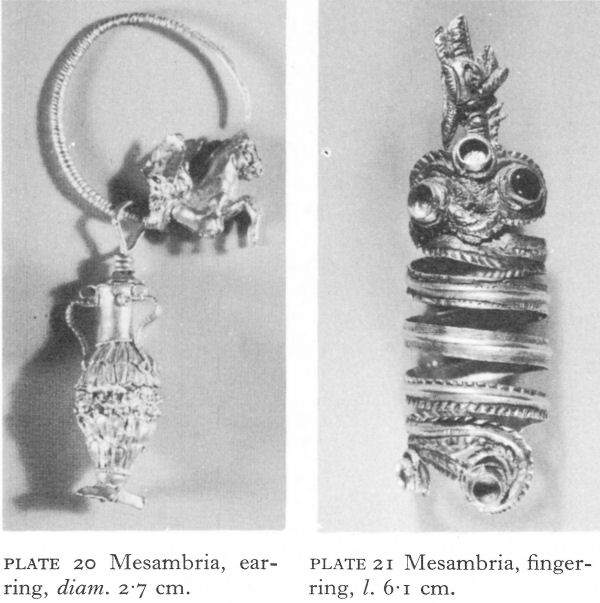
Plate 20 Mesambria, earring, diam. 2.7 cm.
Plate 21 Mesambria, finger-ring, l. 6.1 cm.
Three jewels, of which one amethyst remains, were inset in clumsily stylised shoulders and two more at the base of the spiral. This development of the common snake-spiral ring, an example of which was also found in Mesambria has few if any analogies in either Scythian or Thracian animal art. Also unusual was an oval brooch just over 8 centimetres across, to which was welded a bronze pin. Ornamented with a well-designed filigree decoration and inset with seven stones, it was of a type found elsewhere in this cemetery, but usually simply decorated by a mythological scene hammered on a mould without especial skill.
Near this tomb were several others, partially robbed or badly damaged, and two tumuli, suggesting that this isolated part of the cemetery was used by wealthy Thracians living in the city. The opulent grave goods, contrasting with those of Greek tombs, probably reflected not only Thracian belief in an afterlife in which one’s most precious possessions would be needed, but also a belief in the power of ancestors over the living.
The use of the pale gold noted above extends to the manufacture of at least nine ornaments found in Mesambria, including the moulded oval brooches. In one case it has been suggested that, lacking the correct matrix, the craftsman combined two others to achieve the semblance of a Nike, or Victory. The nature of these various jewellery finds suggests the likelihood of a goldsmith’s workshop in Mesambria by some time in the third century.
In spite of the mention of unpublished fragments of fine imported and local pottery among the debris of buildings and the representations of kantharoi on stelai, remarkably little ware of any artistic value is known.
![]()
48
An exception is a red-figure bell-krater, almost identical in shape to others found in Apollonia and Odessos; it shows a young girl being conducted towards Dionysos and erotes, a dancing satyr in attendance.
Little is known of Mesambria during the Macedonian period, although it was at this time that the city replaced Apollonia as the leading Greek colony on the south-west Black Sea coast. Doubtless access to the Getic areas north of the Stara Planina was an advantage, but probably the traditional adaptability of its citizens, shown by their mutually satisfactory relations with the Thracians in the hinterland, was a basic factor.
A partially preserved decree throws some light on Mesambrian-Thracian relations. Erected originally in the temple of Apollo but being carefully housed by a Nesebur dentist when brought to the notice of archaeologists in 1949, the decree records a treaty between the city and a Thracian ruler, Sadalas. [16] A rendering of the fragment reads:
... to Sadalas as soon as possible. Sadalas must be crowned with a gold wreath during the Dionysiac festivals at the theatre as a benefactor to the city. To him and his heirs will be granted citizenship - the right to represent the honour of the city; to take first place at the public games; to bring his ships in and out of the harbour of Mesambria without hindrance; to be crowned every year with a wreath of the value of fifty staters. The treasurer must write the oath and the agreement on an inscribed slab and place it in the sanctuary of Apollo near the tablets of the ancestors of Sadalas, Mopsuestis, Taroutin, Medistas and Kotys. Agreement between Sadalas and the inhabitants of Mesambria: if a Mesambrian ship is wrecked at sea off the territory of Sadalas, having delivered its cargo . . .
The names of Sadalas and his ancestors are Thracian. The courteous formula of a ‘gold wreath’ was a euphemism for a fairly substantial annual tribute. The inscription is adjudged ‘careful work of the early Hellenistic period’, [17] but in the absence of sufficient comparable local material, no more precise dating is possible on epigraphic evidence. Nor can Sadalas be identified with any certainty. It is a common Thracian name and he could have been a local Astian ruler or an Odrysian. Thus dating to a large extent depends on the period when a Thracian could have been sufficiently influential and powerful to have such relations with and receive such tribute from Mesambria. G. Mihailov considers this could only have been between the death of Lysimachos in 281 and the Celtic arrival in 278. [18] Other scholars have either minimised the power of the Celts [19] or felt that the reign of Lysimachos need not be excluded. [20] The existence of Seuthopolis, albeit some distance inland, may be cited in support of each view.
Archaeology does not record undue hardship in Mesambria in the third century. The teacher and pupil stele (Pl. 17) probably represents local work and an epitaph stylistically influenced by the Iliad may also suggest a degree of cultured leisure. The same necropolis continued in use.
In the second century, Mesambrian ambition led to the attacks on Anchialos and Apollonia already described. But when M. Lucullus arrived at the head of a Roman army in 72 b.c., Mesambria seems again to have adapted to circumstance. While Apollonia resisted, here there was no struggle; the next spring the city erected a decree in honour of Gaius Cornelius, commander of the Roman garrison.
![]()
49
Fierce resistance to Burebista’s Daco-Getic invasion is, however, recorded. Dio Chrysostom says that all the Greek cities south to Apollonia were captured, but judging by votive plaques to the protecting gods, Mesambria may have escaped, and certainly the city survived, perhaps little harmed, into the Roman era.
III. ODESSOS
Odessos (Varna) was founded by Miletos about 585 or 570 b.c. From the beginning, it was essentially a trading colony. Among Greek coastal cities between the Stara Planina and the Danube delta it was second in importance to Histria in the northern Dobroudja, until the latter’s decline, when first place was taken by the later Doric foundation of Kallatis, also in modern Romania. Other colonies included Kruni, by some authors identified with Dionysopolis (Balchik) renamed after a statue of Dionysos had been ‘miraculously’ washed up on its shore, a precedent later followed by some famous Byzantine icons, and Bizone (Kavarna). Excavation and published finds of early date from these and other sites have as yet been minimal. There were also Thracian coastal settlements.
Although dredging operations or soundings showed Bronze Age life under Apollonia and Mesambria, Odessos and its immediate vicinity go back archaeologically to the Late Chalcolithic period and beyond. Lake Varna, around which many pile settlements had been built, was an inlet of the Black Sea until about the beginning of the first millennium b.c., but the silting-up of the bar still left an excellent harbour. When the Greeks arrived, the region was inhabited by the Krobyzi tribe, a branch of the Getai, with whom Milesian Histria had already established good and profitable relations. The hinterland was fertile, well forested, and rich in game.
Today, Varna is Bulgaria’s third most populous city and her chief port. Even during the Roman period the walls were extended to include an area more than double the original settlement of some 13 hectares, and this involved the demolition of Greek and Hellenistic public buildings. In such circumstances, archaeology has always been severely hampered. Sufficient vestiges of the Greek curtain walls have been identified to show that they formed a basis for at least part of the Roman fortifications. Within the early walls, sites of only two preHellenistic buildings have been located.
Outside, chance finds and salvage digs over the last 90 years have traced the outlines of the two main early cemeteries; both were used until the mid-first century b.c. for both cremation and inhumation burials. One stretched northeast along the old road to Dionysopolis, covering the whole 44 hectares of the modern Morska Gradina by the seashore; the other, smaller but densely packed with graves, was near the north shore of Lake Varna. Another, apparently less extensive area north of the city was also used for burials. Three other cemeteries in the neighbourhood are specifically attributed to Thracian villages, rather than the Greek city. Two had several high mounds, excavated by K. Škorpil before they disappeared beneath modern Varna; the third consisted of low mounds now transformed into vineyards.
Škorpil is an honoured name in Bulgarian archaeology. Two brothers, Hermenegild and Karel Škorpil, were idealistic Czechs who, when Bulgaria
![]()
50
gained independence in 1879, decided to help the newly free Slav country discover, understand, and preserve its past. The elder, Hermenegild, came first, and by 1882 Bulgaria’s first archaeological society was founded in Sliven, close to where so many major prehistoric tells have since been discovered. In Varna, where a similar local society was formed a little later, Karel, the greater archaeologist, took the lead in building up an archaeological museum. On countless journeys of exploration he also made many important discoveries, especially in north-east Bulgaria, where an outstanding contribution was the identification of Pliska, the first capital of the medieval Bulgarian state. No less important to science was the stimulus he gave to local appreciation of the heritage of the past and the consequent founding of civic archaeological societies and museums. This did not endear him to those archaeologists and officials whose aim was to build up a collection of ‘treasures’ for a national museum; to them Karel Škorpil’s individualism, his interest in sites (as opposed to objects of silver and gold), and the enthusiasm with which he infected local societies seemed often obstructive. He also antagonised - and fought - developers interested in land only as marketable property, those who viewed ancient monuments as cheap quarries for building materials, and people primarily interested in selling finds abroad to the highest bidder. Škorpil’s contribution to Bulgarian archaeology is incalculable and it is warming to see it now recognised. The village where he made one of his last discoveries, an Early Byzantine basilica with a fine mosaic floor, has been renamed Shkorpilovtsi; he was buried at the site of another basilica he had found, at Djanavar-tepe, near Varna. In the city itself, the Archaeological Museum, with its tradition of scientific archaeology and fine collection, is Karel Škorpil’s main memorial.
The two early buildings within the city were probably cult edifices. In the first, the remains of a wall 1 1/4 metres thick were traced for 9 metres; on part of another wall at right-angles to it was the base of a Doric column with empty spaces for four others. This may have been the pronaos (porch or vestibule) of a temple. Even less was left of the second building, found below the ruins of a Hellenistic temple. It is thought to have been the temenos, or sacred precinct, of a temple of Demeter, the main evidence being pottery from the end of the sixth century and beginning of the fifth from three bothroi which bordered the supposed sanctuary.
The layer above this suggested temenos of Demeter provides some archaeological evidence of Hellenistic cults. [21] Here were the remains of an almost square dry-stone walled building (4.30 by 4.20 metres) with a single entrance. Potsherds attest its fourth-century construction, although there were later repairs. To the south of the sanctuary a well, an oven, a bothros with fragments of amphorae, a herm, and black-glaze ceramic were found, together with two marble votive reliefs. On one relief is a goddess with a quiver of arrows over her shoulders, a patera, or saucer-like dish often used for libations, in her right hand and two (?) spears in her left. A tiny male worshipper stands at one side and a dog sits below the patera at the other. The relief is dedicated to Phosphoros (the light-bearer), an epithet applied both to Artemis-Bendis and to Hekate. On the basis of the inscription this relief is dated to the third-second century [21] or to the second-first. [22] The other relief, attributed to the second century, shows a horseman advancing in a stately manner towards a standing figure.
![]()
51

Fig. 3 Odessos, Corinthian oinochoe, detail of decoration
Beneath is a short dedication to the ‘Heros Karabazmos’, a Thracian epithet which also appears on a number of Horseman tablets found in the sanctuary of a Thracian settlement at Galata, n kilometres south of Odessos.
Another syncretism was the ‘Theos Megas’, the Great God, probably Zalmoxis, later known as Darzalas, who also had a temple at Histria. Depicted on coins and represented by terracotta figurines in tombs from the fourth century onwards, the Great God of Odessos seems to have possessed the attributes of a chthonic fertility god. On both coins and statuettes he holds a cornucopia and a patera, on the statuettes often wearing the ivyor vine-leaf crown of Dionysos. Coins of the third century in particular frequently portray him on horseback, possibly an identification with the Thracian Hero and another pointer to the close links between Odessos and its Getic hinterland. A first-century b.c. list of the priests of the Great God of Odessos included a Thracian name and, during the Roman period, games known as ‘Darzaleia’ were held in his honour.
The interrelations of Thraco-Odessitan cults, which appear to centre on the Great God, are by no means clear. Their associations probably included the Samothracian mystery cult of the Kabiri, which flourished in all the northwestern colonies as well as in the interior (p. 96). Epigraphical evidence of the local Samothracian cult appears not only in a third- or second-century inscription found in Odessos, but seems to be implied in one on Samothrace itself. [23]
The earliest pottery found in Odessos consists of five Corinthian vases dated to about the first quarter of the sixth century. An early chance find and the only Corinthian ceramic found in Bulgaria, they probably came to Odessos as articles of trade through an Ionian intermediary. The main decoration of a trilobed oinochoe, a band of heraldically arranged mythological winged creatures and lions, is finely executed (Fig. 3).
Sixth-century Ionian pottery is rare and mostly in fragments; one shows a stylised hunting scene with brown figures on a light background. Two lekythoi are decorated with bands of black glaze on a yellow-brown background. An unusual fragment, attributed to fifth-century Ionia, is the broken-off neck and mouth of an amphora, decorated Janus-like on each side of the handles with the face of a bearded satyr, the hair indicated by small stamped circles.
Of greater artistic importance is a head dated to the first half of the fifth century (Pl. 22). The use of local marble demonstrates the existence of an Odessitan workshop. The head, which was intended to wear a diadem or crown, may have represented Apollo.
Isolated finds from the necropolis areas reflect dependence on Attic imports from the beginning of the fifth century, although the earliest object found in situ cannot be dated before the century’s end.
![]()
52
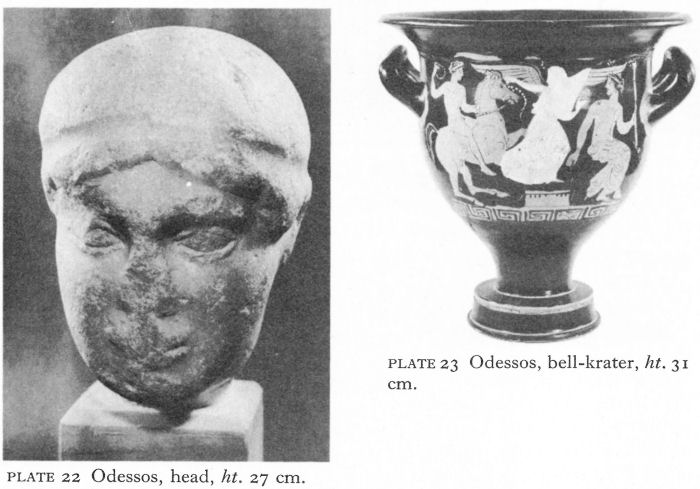
Plate 22 Odessos, head, ht. 27 cm.
Plate 23 Odessos, bell-krater, ht. 31 cm.
In two cases, a black-figure lekythos and a black-glaze olpe, a jug with an even rim and no spout, identical finds occur in fifth-century tumuli at Douvanli and near Stara Zagora, but such parallels do not necessarily imply an Odessitan source; similar vases were found at Apollonia and Attic pottery was then an important item of trade for all the Greek colonies.
Fourth-century finds reflect the popularity of the Kerch-style vases. One, a bell-krater, depicts on one side a horseman crowned by a Nike and watched by a seated youth holding a torch and on the other three young men, one holding a strigil; it contained partly burnt human bones (Pl. 23). The vase, dated to the middle or third quarter of the fourth century, is ascribed to the painter of two Ferrara vases whose work has also been identified at Apollonia, at Olynthos, and in south Russia. [24] Women’s heads are a popular decoration on lekythoi.
There is no mention of any use of Odessos by Philip II or Alexander, although its potentialities as a base for controlling the Getai seem obvious. Both reigns in general increased the trade and prosperity of the city and its Thracian neighbours. The rule of Lysimachos was more oppressive; taxation increased and Odessos, like the other Greek cities, had to support a substantial garrison. In 313, the leading city of the region, Kallatis, led a general revolt against the Macedonian garrisons, with the hope of Odrysian and perhaps Getic support. However, although Kallatis resisted for a long time, quick action by Lysimachos achieved the speedy surrender of Odessos and Histria and ensured the allegiance of the Getai.
It is doubtful if the area north of the Stara Planina suffered much from the Celtic kingdom, but ‘barbarian’ pressures from the North were generally beginning to make their presence felt on this fringe of the Greek world.
![]()
53
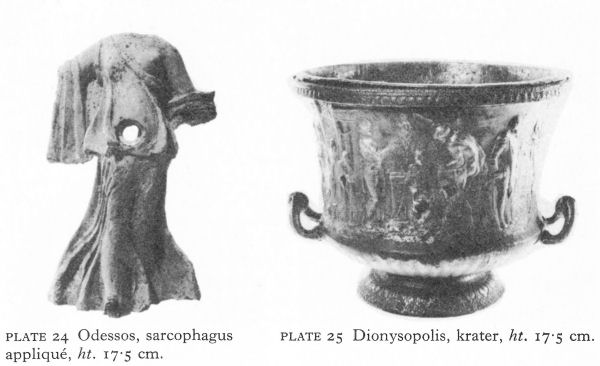
Plate 24 Odessos, sarcophagus appliqué, ht. 17.5 cm.
Plate 25 Dionysopolis, krater, ht. 17.5 cm.
In 179 b.c. the Bastarnae passed through, and Odessos was an early victim of Burebista’s Daco-Getic invasion of the mid-first century. Odessos, like Mesambria, had adapted to the commercial decline of Athens and to local changes. Under the threat of Burebista, links with the resurgent Odrysian vassal kingdom of the Romans grew stronger. Although this lacked stability, it was a trading area and also a refuge for at least a few Odessitans during the Daco-Getic invasion: soon after Burebista’s death, a decree acknowledged the protection given by one Sadalas. [25] Certainly not the Sadalas of the Mesambrian inscription, this one also is not clearly identified.
Funerary innovations typical of the Macedonian or Early Hellenistic era include barrel-vaulted Macedonian-type ashlar chamber tombs. Five have been identified in the vicinity of Odessos. One was found in 1932 beneath a large tumulus on which a memorial was being erected to commemorate the Polish prince ‘Ladislas of Varna’, who died here in battle against the invading Turks in 1444. The fourth-century b.c. tomb was conserved as part of the memorial to the fifteenth-century warrior prince. Its entrance had been destroyed and the contents looted in the distant past. A vaulted dromos, or passage, led into a square tomb chamber built of carefully dressed dry-stone blocks. In a similar tomb a wooden coffin had been decorated with terracotta appliqués of satyrs and maenads, like the one illustrated in Pl. 24.
A Thracian tumulus cremation near Galata contained a quantity of gold jewellery, including two finger rings, each with a woman’s head in relief on the gold bezel, considered to be imported Greek work of the fourth or third century. The mound itself, one of six in the necropolis, contained numerous sherds of black-glaze ceramic. More evidence of Greek influence in the Hellenistic period came from another tumulus burial by the Dionysopolis road. This mound, 25 metres in diameter, was one of the earliest excavated by the Škorpil brothers. In it was the skeleton of a woman wearing gold earrings composed of twisted, tapering hoops with lion-head finials,
![]()
54
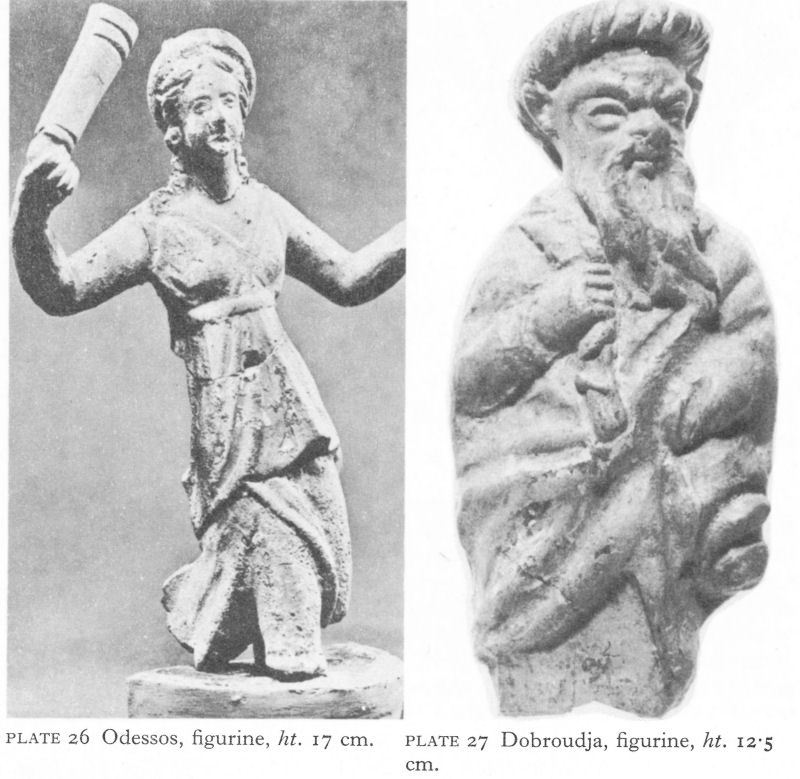
Plate 26 Odessos, figurine, ht. 17 cm.
Plate 27 Dobroudja, figurine, ht. 12.5 cm.
a Hellenistic type which gained widespread popularity in Bulgaria in the fourth century; other examples were found at Mezek (p. 73) and Seuthopolis. A bronze obol for Charon lay in the dead woman’s mouth.
At Dionysopolis itself, in a badly damaged ashlar tomb with two marble biers, a bronze krater, used for burning aromatic substances, was found by one of the skeletons. A ring encircling the top of the krater supported a dish-shaped sieve. The decoration, hammered in relief from a mould and well executed in the crowded Hellenistic manner, consists chiefly of scenes from Euripides’ tragedy Iphigeneia in Tauris (Pl. 25). The krater is attributed to the fourth or third century, the tomb itself being later. However, comparison with the silver ‘Chryses’ kantharos in the British Museum and with fragments of a marble krater from Mahdia in the National Museum, Bardo, [26] suggests that an early second-century date may be more likely.
Third-century imports included bone plaques decorated with figures finely incised with a sharp point. They were used to decorate coffins that in shape, if one may judge from the examples found on the Taman peninsula, imitated ornate stone sarcophagi and probably came from Asia Minor.
![]()
55
Of four such plaques found in the Galata burial containing the gold finger rings, two depicted women’s heads and two Dionysiac scenes. The material shows traces of paint. Ivory panels, decorated in much the same way, were found in the Great Bliznitsa and Kul Oba burials of the Taman and the Crimea, although here attributed to the fourth century. [27]
Few stelai have been found which predate the Roman period. Then the theme of the funerary feast became immensely popular (Pl. 149), so it is interesting that it appeared here as early as the fourth or third century b.c., when its use was beginning in Attica and Asia Minor. Besides the customary composition of the dead man reclining on a bier, a seated woman, and a three-legged table bearing food, the earliest Odessitan stele includes a horse’s head, a snake-entwined tree, a herm, and, being only partially preserved, probably other details, including attendants. In the Thracian lands the horse, snake, and tree were soon to be hived off to the separate iconography of the Hero Horseman, but in this early stele they are probably symbols of heroisation. Another funerary feast stele, of the third or second century b.c., is simpler; the upper part, which alone remains, shows only the man and the woman. G. Toncheva notes a gap during the first century b.c. and the first century a.d. before the theme’s recurrence. [28]
A study of over 300 amphora stamps in the Varna museum provides useful evidence regarding the import of wine and olive oil to Odessos and Bizone from the main Greek production centres. [29] The first to capitalise on the decline of Athenian power and Philip IPs stabilisation of Thracian affairs was Thasos, which exported amphorae of wine and oil into the Thracian interior both via the north Aegean colonies and by the Bosphoran sea route to the Black Sea colonies. This trade continued intermittently from about the middle of the fourth century until the end of the second. Rhodes, a major commercial power in the east Mediterranean, entered the market during the second half of the third century and by about 220 had almost monopolised the wine trade, a position held until the mid-second century. About the third decade of the second century, Sinope began to export olive oil to the west Black Sea coast; judging by the amphora stamps, this too was on a substantial scale. Heracleia Pontica was another big exporter, but the period and extent of its trade with Odessos are matters of some dispute. In view of the Thracian origin attributed to Dionysos, the import of wine may appear surprising, but north of the Stara Planina the climate at that period may well have been too harsh for easy viticulture. The Thracian plain in fact was the destination of large numbers of the imported amphorae. The extent to which new wine of local origin was passed off as Thasian or Rhodian by virtue of the ‘label’ on the amphora is, like many a similar fraud perpetrated today, unlikely ever to be known.
Opportunities to excavate Greek Odessos have been so limited that the city’s ability to survive in any circumstances is the main evidence for local industry. The fifth-century head and the many reliefs, although the great majority date from the Roman period, argue convincingly in favour of a well-established tradition of stonemasonry and carving. By contrast with Apollonia and Mesambria, many terracotta figurines have been found. The remains of at least one potter’s workshop, excavated at the north-east corner of the Morska Gradina necropolis, included many fragments and rejects, mostly of burnt or misshapen figurines. The local yellowish-pink clay was used, but it is hard to say if all the
![]()
56
moulds were imported or, as seems likely, moulds were made locally to portray Odessitan subjects. The broken but lively figurine of a dancer, waving what are probably clappers in her one remaining hand, was found in this workshop (Pl. 26). Another broken statuette of a bearded man with a shrewd wrinkled face from some unrecorded spot in the Dobroudja is probably also local work of the third century (Pl. 27).
Through continuing support from the Asiatic kingdom of Pontos and close links with neighbouring Odrysian vassal kings, Odessos was able to retain a gradually diminishing independence for longer than the cities of the south. Finally, without resistance, it accepted Roman suzerainty about 27 b.c.
NOTES
1. Xenophon, Anabasis, VII,5, trans. Warner, R., The Persian Expedition, Harmondsworth, 1949, 277-8.
2. Brashinsky, I. B., Arh XII/2, 1970, 11.
3. Munzova, L., IBAI XXXII, 1970, 255 ff.
4. Seure, G., Revue archeologique XIX, 1924, 328.
5. ARV II, 1432.
6. Trans. from Venedikov, I. and Velkov, V., Apoloniya, Sofia, 1963, 329.
7. ARV II, 1482.
8. Kurtz, D. C. and Boardman, J., Greek Burial Customs, London, 1971, 320.
9. IGB I, 388.
10. IGB I, 395 ter.
11. Pippidi, D. M. and Popescu, M., Dacia, Nouvelle Serie, III, 1959, 235 ff.
12. Brashinsky, op. cit., 11.
13. Trans. from Velkov, I., IBAD, 1919-20, 136.
14. Richter, G. M. A., AJA L, 1946, 361 ff.
15. Chimbuleva, Ya., Arh IV/3, 1962, 38 ff.
16. IGB I, 307.
17. Robert, J. and L., Bulletin epigraphique LXVI, 1953, 38-9.
18. Mihailov, G., IBAI XIX, 1955, 149 ff.
19. Danov, H. GSUFIF XLVII, 1951-52, 110ff.
20. Gulubov, I., Iz Bourgas I, 1950, 7 ff.
21. Toncheva, G., Actes 1st BC, II, 353 ff.
22. IGB I, 88 bis.
23. IGB I, 78 bis; Fraser, P. M., The Stones of Samothrace, London, 1960, no. 6.
24. ARV II, 1693-4.
25. IGB I, 43.
26. Webster, T. B. L., Hellenistic Art, London, 1966, 168-9, 189 ff..; Pls. 53, 54, and App. 12.
27. Artamonov, M. I., Treasures from Scythian Tombs, London, 1969, Pls. 257-62, 301-3.
28. Toncheva, G., Arh VI/1, 1964, 37 ff.
29. Mirchev, M., Amphorite pechati ot muzeya vuv Varna, Sofia, 1958.
3 The Thracian Interior before the Macedonian Conquest
I. DOLNO SAHRANE
Where burials are concerned, interest is naturally focused either on the more monumental constructions or on those especially rich in grave goods, features which highlight the degree of culture reached in an area and the extent of contact with neighbouring peoples. Yet in their relative simplicity the commoner, poorer graves of more ordinary people are archaeologically at least as important because they reflect indigenous traditions more strongly. Before turning to the major tumuli, a brief description of some graves from a small necropolis with a long existence will help to provide a degree of perspective, even if no example can be chosen which may be called representative, and a comprehensible pattern for the country has still to be traced.
Dolno Sahrane is 15 kilometres west of Kazanluk. Near Seuthopolis, it was in Odrysian territory by the Early Hellenistic period and probably before. Four tumuli excavated in the 1960s contained burials reaching back to the end of the Bronze Age and forward to medieval Christianity. One tumulus, 18 metres in diameter and less than 2 1/2 metres high when excavated, was erected in the sixth century b.c. for two burials; another, much older, was re-used in the sixth-fifth century for four. In all cases, the bodies were laid out flat on a bed of stones, with the grave goods beside them, then covered with another layer of stones, above which the earth mound was piled. Bronze objects from the former mound were an arc-shaped fibula, flattened at the top of the curve where it was decorated by five ribs in relief; an open-ended finger ring; and three short sections of thin, narrow spirals, possibly from a necklace. Coarse, thick-walled hand-made pots, often with tongue- or bud-shaped handles, had also been left between the layers of stones, but they had been broken beyond reconstruction. Such pots continued in use for a very long time, sometimes as cremation urns in poorer graves. The grave goods of the four burials of the sixth to fifth centuries in the latter tumulus were, in probable order of date: (i) a large clay urn with tongue-handles and a small clay cup, both hand-made; (ii) none; (iii) two large pots both beyond reconstruction, but one of coarse hand-made ware with tongue-handles, the other wheel-made, of finer clay and amphora-like in shape; (iv) a slightly curved iron knife and an iron arc-shaped fibula.
The latest of the four tumuli excavated was constructed about the end of the fifth or the beginning of the fourth century and used only for cremation. It was enclosed by a rough stone retaining wall, 34 metres in diameter. A round hearth, slightly above ground level, was found in the centre of the mound, piled with greasy black ashes and embers. The act of cremation was thorough; the charred remains were then inserted into an amphora (Pl. 28), the neck of which was thrust into another amphora with its neck broken off, and turned upside down before being buried.
57
![]()
![]()
58
Fragments of a third amphora were also found, stuck into the mouth of the first. It was impossible to tell from the remains if more than one person had been cremated. The grave goods included two arc-shaped iron fibulae and a small iron knife. All the pottery was local and, with one possible exception, wheel-made. The influence of Greek models was pronounced, especially in the amphorae, although the only two cups that could be reconstructed, both with twin handles rising above the mouth (Pl. 29), as well as the fragments of a similar type of jug and another cup, demonstrated the strength of earlier Thracian traditions. Apart from the grave goods, five pithoi were found in the east and south parts of the mound; their contents, if any, are not known.
The sex of the skeletons could not be ascertained, but the presence of knives usually signified a male burial.
II. DOUVANLI
In the neighbourhood of Douvanli, a village in the Thracian plain about 25 kilometres north of Plovdiv, a large necropolis containing the richest tumulus burials in Bulgaria was excavated in the late 1920s and early thirties. Out of some 30 tumuli excavated, six contained burials of outstanding interest, all oriented more or less east-west. The table below gives some basic details of each, sex having been determined according to grave goods, arms and armour indicating a man, normally feminine jewellery and toilet accessories a woman.
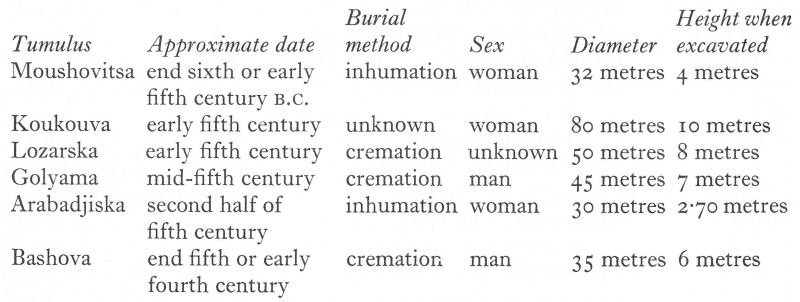
[[ Tumulus: Moushovitsa, Koukouva, Lozarska, Golyama, Arabadjiska, Bashova ]]
All mounds had been under the plough and where, as at Koukouva tumulus, traces of a retaining wall were found, many stones had been removed for building material or to facilitate cultivation.
The Moushovitsa tumulus
The skeleton, armless, lay on its back in a possibly timber-lined pit grave about 3 1/2 metres long and 2 metres wide, in the exact centre of a mound formed by alternating layers of black earth and local soil. The grave goods, as at Mesambria, almost all by the head, were those of a lady of high rank and included some fine gold jewellery.
A large gold pectoral, or ornamental breast plaque, with stylised birds round the edges, embossed using a single punch, had remained in situ (Pl. 30).
![]()
59
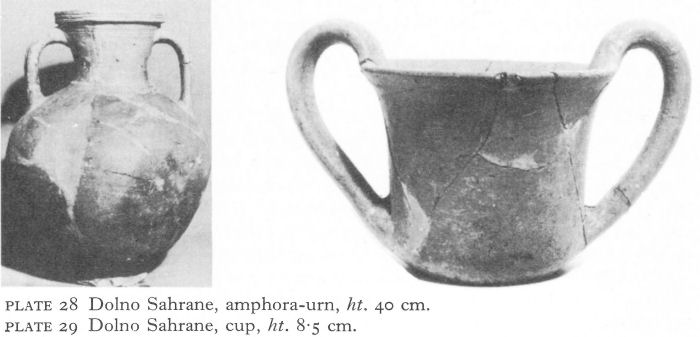
Plate 28 Dolno Sahrane, amphora-urn, ht. 40 cm.
Plate 29 Dolno Sahrane, cup, ht. 8.5 cm.
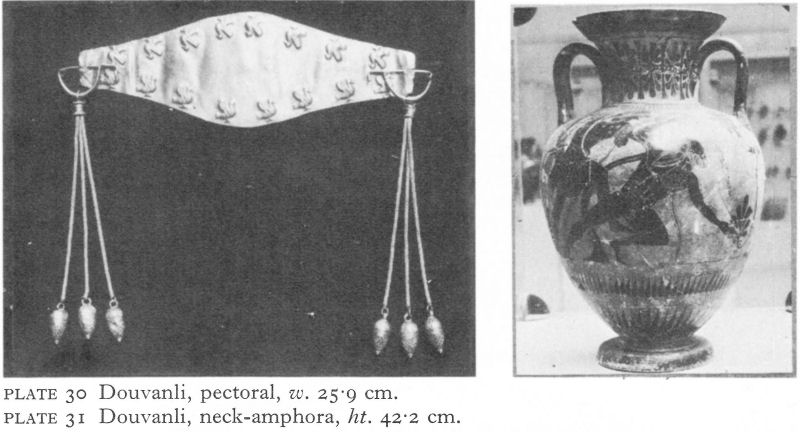
Plate 30 Douvanli, pectoral, w. 25-9 cm.
Plate 31 Douvanli, neck-amphora, ht. 42.2 cm.
Through holes at each end were attached plain arc-shaped fibulae from which three stylised bud pendants were suspended by cord-chains, all items being made of pure gold. Gold or, less frequently, silver pectorals were a usual feature of noble Thracian burials, both male and female - in inhumations placed where they had obviously been worn in life - during a period from about the turn of the sixth-fifth centuries until the middle or second half of the fourth. They varied considerably in size and shape, but were invariably longer horizontally than their vertical width; ornamentation also varied, but was usually embossed; holes at the horizontal ends enabled them to be attached to a garment.
Round the neck was a gold necklace with 20 hollow globular pendants or bullae. They were decorated with filigree rosettes and granulated borders, and suspended by broad loops, a type with analogies in Etruscan jewellery. [1] Another necklace, or part of the first, lay behind her head; it consisted of 19 little biconical gold beads.
![]()
60
Two massive splayed spiral earrings had been attached to her ears; each weighed over 26 grams. In shape they resembled an omega, with finials of closely granulated pyramids. Ten tapered hoop earrings, nine with their lower halves identically decorated with filigree and granulation, lay beside the head.
Other grave goods included a bronze hydria, which was lidded by a silver phiale mesomphalos - a shallow bowl with a central omphalos or boss. This type of dish, considered to have some ritual significance, had both Greek and Persian variants and was common in rich Thracian graves before the Hellenistic period. D. E. Strong considers the Moushovitsa phiale, relatively deep and with its embossed, pear-shaped ornament, ‘may not be Greek’. [2] There wTas also a large black-figure neck-amphora, portraying on one side Theseus fighting Procrustes (Pl. 31) and on the other Dionysos with a satyr and maenad. The amphora is ascribed to the Troilos painter, a Late Archaic vase painter who normally worked in red-figure. [3] The toilet accessories were a bronze hand mirror, three miniature Egyptian glass oinochoai, and seven alabastra. A terracotta bust, 11.5 centimetres high, of a dignified female wearing earrings, was perhaps a portrait of a deity. There were also several household vessels of high quality.
North of the head was a strange medley of 42 tiny objects, among them triangular pieces of agate, bronze finger rings, larger rings of amber, iron, and clay, coloured glass beads, clay balls, and Mediterranean seashells - Cardium, Murex, and Cypraea. A possible meaning for this and a similar collection from the Arabadjiska tumulus is suggested on p. 64.
Antedating the Persian invasion, the burial in the Moushovitsa tumulus is a testimony to the cultural impact of Greece on the Thracian aristocracy.
The Koukouva tumulus
The Koukouva or Koukova tumulus, the largest in the necropolis, was partly planted with trees, partly used for grazing, and partly as a vineyard until 1925,
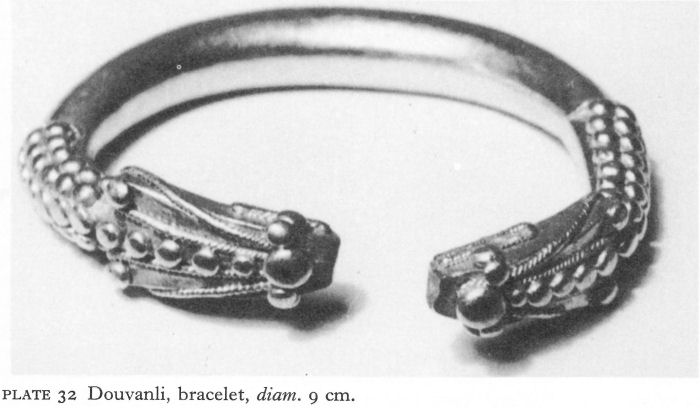
Plate 32 Douvanli, bracelet, diam. 9 cm.
![]()
61
when a peasant irrigating vines struck what he immediately saw to be a tomb of dressed limestone blocks. In haste to get at the treasure, he and his friends flung out the earth which had fallen in through the broken roof, and with it pottery and other objects which were smashed or lost. Two days later, when the news reached the Plovdiv museum, not only had all the gold and silver disappeared, but even the floor stones. Intense activity by officials and archaeologists succeeded in tracing some of the grave goods, but almost certainly there had been many more. Even so, the total weight of gold recovered was over 1 1/4 kilograms. The objects clearly suggested a female burial, although no human remains survived.
Some of the gold jewellery was very like that at Moushovitsa. Part of a necklace had similar globular pendants; there was an almost identical pair of ‘omega’ earrings and seven of tapering hoops, with both filigree and granulated decoration. There was also a pectoral, similar in shape and size, but without any fibulae or pendants it may once have possessed, and decorated with an overall repousse pattern. New items included a torque of twisted gold wire, weighing 349 grams, and a pair of open-ended solid bracelets with stylised snake-head finials carrying heavy granulation (Pl. 32) and two finger rings with pointed oval bezels, one with a cock engraved in intaglio. One fish and fragments of others in sheet gold - there had originally been as many as sixteen - are not jewellery in the accepted sense; there are Scythian analogies and they probably had some religious significance, showing the dead woman to have been a priestess.
By good fortune, a superb silver-gilt amphora (Pl. 33) was saved. Its shoulders and bulge were decorated with a double row of lotus flowers and palmettes, below which was vertical channelling. The handles were in the form of fantastic beasts with lion heads and manes and ibex horns (broken off on one side). Wings were indicated in relief on one handle; on the other they were outstretched to form a spout. N. K. Sandars has described the amphora as ‘absolutely typical of the unlocalised Achaemenian court style’. [4]
There was a silver phiale mesomphalos as at Moushovitsa, but with a larger boss and a fluted body, five bronze vessels including two hydriai, a bronze mirror, and an iron tripod. An alabastron and five pottery kylikes, one black-figure, the other four identical and coated with black-glaze, were also traced.
At Koukouva Greek and oriental influences appear together; the amphora may be a direct legacy of the Persian occupation.
The Lozarska tumulus
In the Lozarska tumulus a stone sarcophagus, carved from a single block and with a monolithic lid, was found 4 metres south-east of centre and 4 metres above ground level. The pressure of the earth mound had caused some damage. The contents were very different from those of the other major burials. Inside were burnt bones but no ashes, so that cremation must have taken place elsewhere. The main feature was a wooden bed with a curved headrest and four turned legs of a design current in Greece in the fifth and fourth centuries b.c. [5] There were holes in the remaining bed-frame for cords or some form of webbing, and pieces of a red cloth on the bed. The only grave offering was a late black-figure Attic lekythos with a rather crude palmette decoration. The Greek influence is paramount here.
![]()
62
The Golyama tumulus
Here the tomb, at ground level in the centre of the mound, was built of dressed white sandstone blocks, almost all more than a metre long, and on three sides was enclosed by a second row. Six large transverse pedimented blocks formed the roof. The inner dimensions were those of a large sarcophagus (2.33 metres long by 1.08 metres wide by 1.11 metres high).
The cremation burial of a man was undisturbed. A pile of burnt bones had been placed in the middle of the floor, on top of them two gold pectorals and a gold ring, with a little earth and fine embers. The whole was covered by a carmine red cloth, probably with a light brown woven pattern and tiny gold sequins sewn to it, but on exposure to the air the textile crumbled to dust.
The smaller pectoral, 17 1/2 centimetres across, was somewhat similar in shape to those at Moushovitsa and Koukouva, except that the lower edge was more like an obtuse angle than a curve, whilst the upper had a rounded indentation in the middle, perhaps to fit some kind of collar, unless it was to be worn just below the neck. Hemispherical bosses were punched across its breadth and round the edges, where they were linked by tangental pitted lines. The larger pectoral was roughly boat-shaped, 38 1/2 centimetres across and with a much deeper indentation in the centre of the upper edge. The overall punched decoration of rosettes, open flowers, bosses of various sizes, made up a roughly symmetrical pattern possessing a primitive barbaric splendour. The variety of shape and decoration of these pectorals is very great - a fine example of the same period at the Ashmolean Museum in Oxford from a male burial in a tumulus at Dulboki, between Stara Zagora and Nova Zagora, is wider and rather more symmetrically decorated than the larger one at Golyama. The grave finds from Dulboki are a unique collection outside the Thracian regions and give an excellent idea of a rich Thracian burial of this time.
The pointed oval bezel of the gold finger ring had an intaglio figure of a naked rider on a galloping horse, saddleless but with bridle and reins.
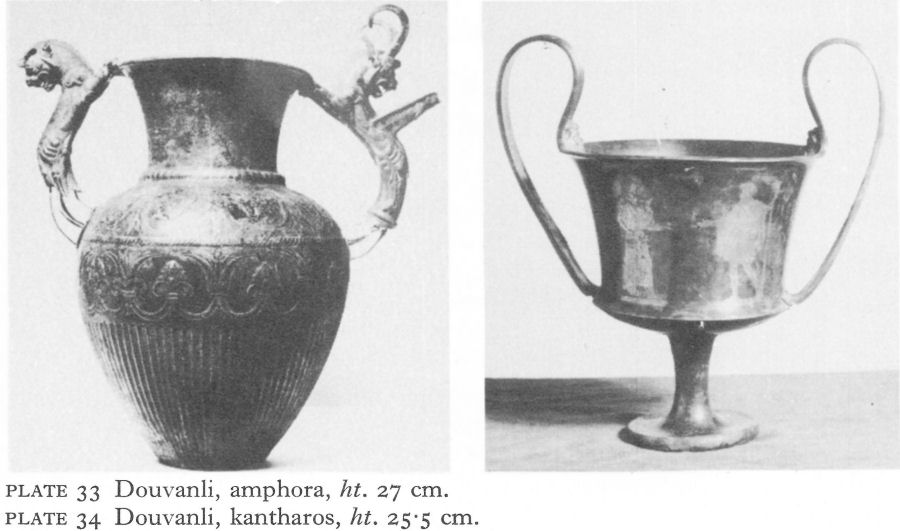
Plate 33 Douvanli, amphora, ht. 27 cm.
Plate 34 Douvanli, kantharos, ht. 25.5 cm.
![]()
63
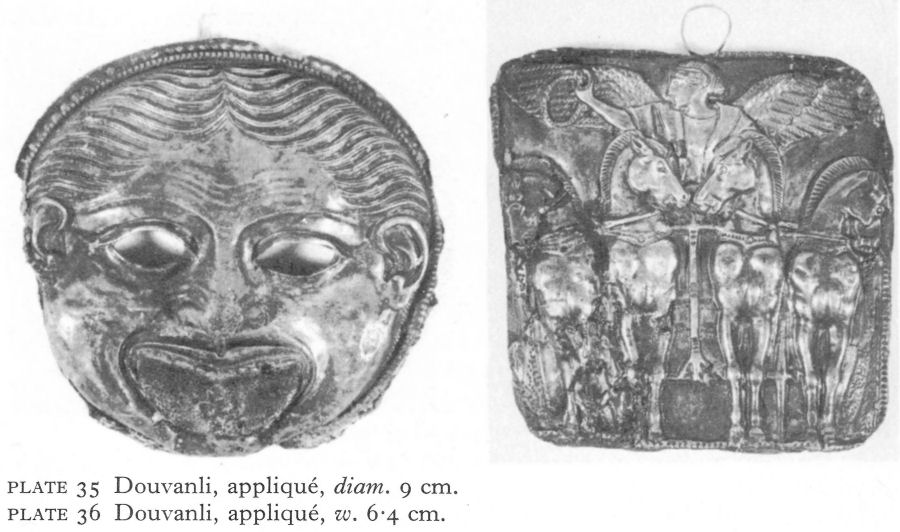
Plate 35 Douvanli, appliqué, diam. 9 cm.
Plate 36 Douvanli, appliqué, w. 6,4 cm.
Engraved in Greek letters round the bezel was the name ΣΚΘΥΘΟΔΟΚΟ, Skythodokos being no doubt the name of the owner.
In Golyama, for the first time at Douvanli, the grave goods included engraved and gilded silver vessels, a Greek fashion beginning about 450 b.c., to which date are assigned two stemmed kantharoi found here. [6] Both were identical in shape and in displaying satyr’s heads between the curve of the handle and the rim. Apart from this, one was quite plain. The other (Pl. 34) had finely gilded scenes on the body of the vase - on one side a girl offering a fawn to Dionysos and on the other a satyr and maenad. Eight silver-gilt appliqués were found in a position suggesting they had been attached to a disintegrated jerkin. On either side of a Gorgon head (Pl. 35) was a Nike driving a quadriga (Pl. 36); five lion heads were arranged symmetrically below.
Between the appliqués and a fine bronze hydria had been a leather helmet. All that remained were the bronze cheek and neck guards, and elaborate appliqués with palmette and spiral decoration. Close to the ashes lay a curved iron sword of the single-edged slightly curved Thracian type, 82 centimetres long (Fig. 4), a fragment of ivory decoration remaining on the handle, two iron spearheads, and part, perhaps, of an iron belt. The only pottery noted was a damaged late black-figure lekythos, found outside the tomb.

Fig. 4 Douvanli, Golyama tumulus, Thracian sword, l. 82 cm.
The Arabadjiska tumulus
In the south-western part of the mound, a shallow pit had been dug (4.20 metres long, 3.0 metres wide, and only 20 centimetres deep) and within this a smaller and deeper pit (2.50 metres long, 1.45 metres wide, and 35 centimetres deep). The latter, lined and roofed with beams, contained an undisturbed female inhumation.
The skeleton, lying on its back, as at Moushovitsa, was adorned with gold
![]()
64
jewellery of broadly the same type as in the earlier female graves. The pectoral on the breast, alike in shape, was only about two-thirds the size, and in decoration closely resembled the smaller one in the Golyama burial. The necklace was composed of 17 hollow globules with filigree and granulated decoration, but here hung by little tubes and the earlier loops generally replaced by similarly decorated beads, which, minus pendants, also formed the back of the necklace. Two twisted ‘omega’ spiral earrings lay beside the head, with granulated decoration below as well as on the pyramidal finials. There were also six boat-shaped earrings decorated with fine filigree; the thin wire of the hoop passed through the hollow interior of the ‘boat’.
On the skeleton’s left hand was a gold ring like the ‘rider’ ring from the Golyama burial, but less finely executed and the Greek lettering is now indecipherable. Other grave goods included a plain silver flask and silver sieve, an Attic red-figure hydria with a domestic scene, and a black-glazed kylix. A bronze hand mirror and an alabastron were the only toilet accessories found.
In the north-west corner of the pit was a neatly laid out collection of 50 small objects. They included some miniature stone axes identifiable as Late Chalcolithic or Early Bronze Age artefacts; partially pierced clay spindlewhorls, looking like rejects from some prehistoric workshop; sling-stones or, perhaps, pebbles; a bronze horse frontal ornament of a common Thracian type (see p. 76); knobs of coloured glass and stones or fragments of fired clay in different shapes; and Cardium and Murex shells.
The collections here and in the Moushovitsa burial are not unique in Bulgaria. Comparable, if smaller, collections have been noted in graves as far north as Oryahovo on the Danube, at Vratsa (p. 79), and as far south as Apollonia (p. 36), as well as in the north-east. V. Mikov has suggested an explanation based on an ethnographical analogy, a ‘healing ceremony’ at which he was present in Sofia in the 1930s, for people suffering from headache caused by bewitchment or the evil eye. The witch, he said, prepared a bowl of water, throwing into it such fired clay objects as cubes, balls, and rings. Watching the ripples and bubbles, she mumbled unintelligible words. Then the remaining objects were inserted, including a stone ball, a Murex shell, and lastly a Cardium shell, with which she scooped up some of the liquid and then poured it back, muttering: ‘Mother of God’ and ‘Christ’. Prayers followed, then one by one the witch took the objects out and rolled them about. Finally, the sick person dipped the righthand fingers into the water, moistened eyes and forehead, and drank a mouthful. Powder scraped from miniature stone axeheads and mixed with water was said to relieve chest pains; the cure for typhus was ‘heavy’ stones in water drunk by the sufferer. [7]
If the Sofia witch had been repeating a ceremony - demoted to a superstition - which two and a half millennia earlier had been the prerogative of a royal Thracian priestess, it is not the only example of such continuity found in Bulgaria.
The Bashova tumulus
Early in the excavation a sacrificial pit was found in the centre of the mound, 2 metres below the surface; there were no signs of burning, only local potsherds and an Attic red-figure pelike, or twin-handled wine jar, depicting two women sacrificing at an altar.
![]()
65
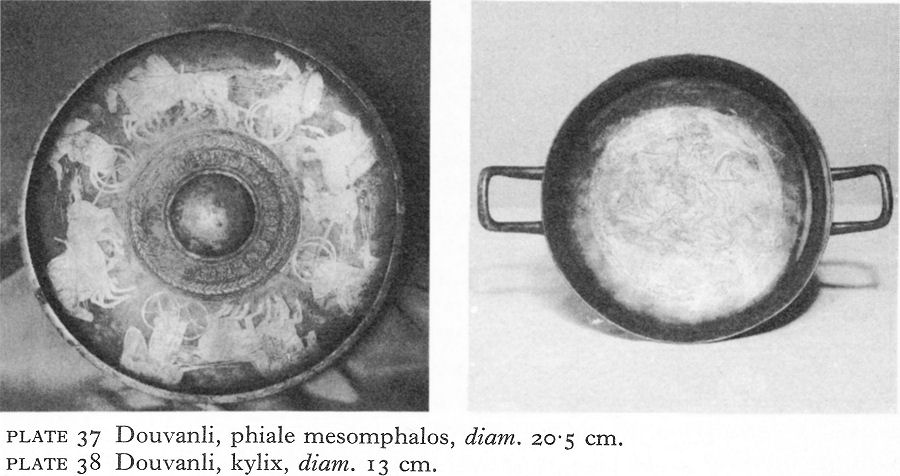
Plate 37 Douvanli, phiale mesomphalos, diam. 20,5 cm.
Plate 38 Douvanli, kylix, diam. 13 cm.
The grave itself was a roughly rectangular pit (about 3 metres long, 2 metres wide, and 170 metres deep) in which a stone tomb (2.10-2.20 metres long by 1.10 metres wide) had been built, roofed by thick wooden beams which had rotted and collapsed.
The ashes of the dead man lay on a silver phiale mesomphalos. [8] This had as its principal decoration four chariots galloping either in procession or in a race round the inside of the bowl (Pl. 37). The chariots, each with their four horses, charioteer, and accompanying armed warrior, were particularly finely engraved and then gilded. In each, the horses and human beings were individually portrayed. The warriors wore different armour and carried different insignia on their shields. One gripped the chariot rail, as if terrified; another leant excitedly forward to grasp the reins, to the consternation of his charioteer. The dish, which probably dates to the last decades of the fifth century, [9] has the word ΔΑΔΑΛΕΜΕ prominently engraved on the outer side. Also appearing on three other silver objects, this could be an invocation or the name of the owner.
One of the other inscribed vessels is a kylix, on the shallow inner base of which is engraved, equally finely but with tender delicacy, a wreath-encircled scene of a goddess (? Selene) riding over the sea (Pl. 38). The third inscribed object is a fluted horn rhyton, a vessel from which wine was drunk from a spout at the bottom, terminating in the foreparts of a horse and with a lotus and palmette band round the rim. Although the horn rhyton was a drinking vessel of Persian origin and was popular among Scyths as well as Thracians, there seems little doubt that this specimen, like the kylix and the phiale, was the work of a highly skilled Greek silversmith. The fourth inscribed item was a simple silver jug with a fluted body.
The customary gold pectoral was found together with the remains of armour. It was small (13.8 centimetres across), but proportionately wider than those in the other Douvanli burials, and was also unusual in being decorated by the figure of a semi-stylised lion.
Of the armour, a bronze corslet, badly damaged, with separate front and back,
![]()
66
was simply decorated with linear curves emphasising the major muscles. This is a typical example of fine Greek work of the fifth-fourth centuries. [10] Lying underneath it were found the remains of what had probably been an iron helmet and a broad iron belt, as at Golyama, both too decayed for reconstruction. Weapons had included a curved iron sword, again recalling Golyama; a short straight dagger of which part of the scabbard remained; 40 bronze triple-edged arrowheads; and fragments of two iron spearheads of the long leaf-shaped type with strongly emphasised vertical ribs.
As usual, there was a bronze hydria, this one with a decoration below the vertical handle of open tracery enclosing a Silenus mask, beneath which hung a large palmette and above two heraldically opposed lions. Also of bronze were a plain situla, or bucket-shaped vessel, with twin mobile handles, and a low vase with flat horizontal shoulders, both closely resembling finds at Mezek (Fig. 6), a jug, and a shallow two-handled bowl.
The pottery consisted of two Attic red-figure hydriai and a black-glaze jug identical in shape and decoration to the inscribed silver jug.
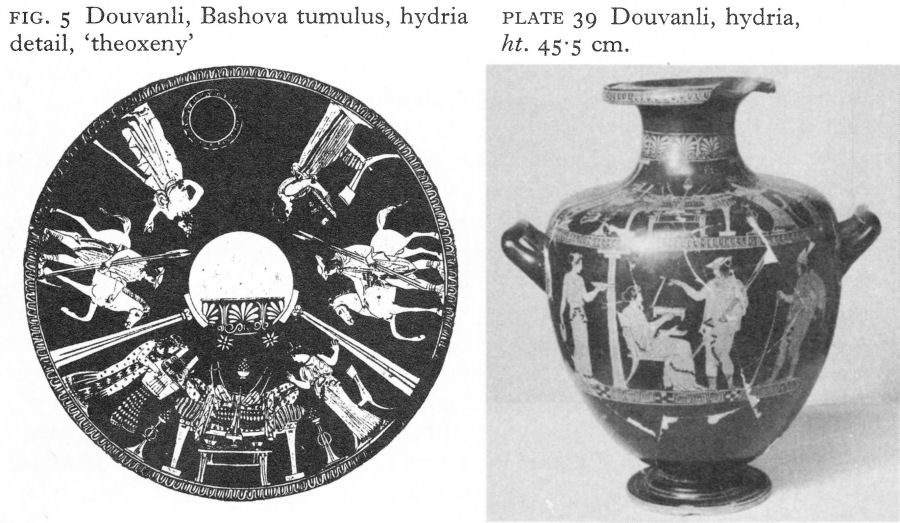
Fig. 5 Douvanli, Bashova tumulus, hydria detail, ‘theoxeny’
Plate 39 Douvanli, hydria, ht. 45.5 cm.
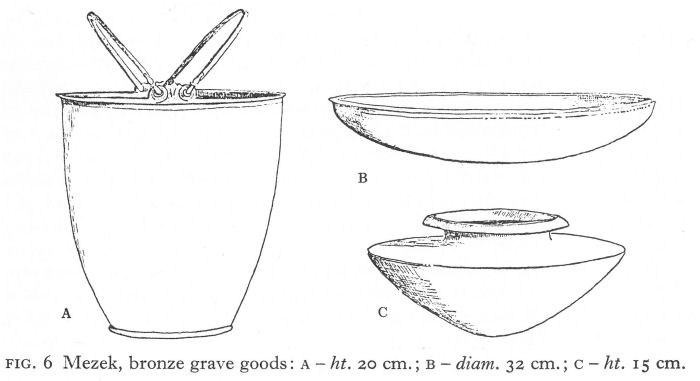
Fig. 6 Mezek, bronze grave goods: a - ht. 20 cm.; b - diam. 32 cm.; c - ht. 15 cm.
![]()
67
The larger hydria (Fig. 5 and Pl. 39), a fine example, is ascribed to the Kadmos painter. [11] The scene on the shoulder is rare. Two worshippers, a man playing a kithera and a woman with raised hands, stand at either side of a sumptuous empty couch, before which a table is spread for a feast. Two pillars enclose this scene; behind them two men advance, each carrying two spears and leading a horse; behind again are an old man leaning on a stick and a woman carrying a dish. The worshippers by the couch wear crowns and are richly dressed, probably a priest and priestess, and the two men with horses may be the Dioskouri. The scene has been interpreted as the theoxeny - a feast offered to a deity - of the Dioskouri.
Five of these six graves contained objects of outstanding archaeological and artistic interest. The sixth, the purely Greek Lozarska, is an enigma in a Thracian tumulus. The gold pectorals, of local workmanship, with the possible exception of the Bashova lion, are an essentially Thracian feature, which, although found in Thrace before the Persian occupation, probably stemmed from Persian origins. The dead of both sexes were honoured equally. On one hand there is the sumptuous feminine jewellery, on the other the magnificent plate and the accoutrements, many of them iron and therefore badly corroded, of the men.
The importance of hydriai, already observed at Mesambria and shared by the Greeks in their homeland as well as other peoples, notably the Greek-influenced Trebenište culture of Macedonia, is evident. They must surely be symbolic of water, accorded universal reverence as essential to life in all primitive religions. There is some evidence that hydriai were associated with Orphic beliefs in the afterlife, [12] but no assessment is yet possible of the extent to which Thracian religion was permeated by Orphism as interpreted by the Greeks.
There are grounds for thinking that two, if not all three, of the women were priestesses; a collection of ‘magic’ objects would not have survived the rape of Koukouva. The men must have been primarily warrior leaders. For them all to have amassed objects of such richness and superb quality is a strong argument in favour of royalty.
Problems arise in trying to assign the Douvanli necropolis to a particular tribe. There is no historical evidence for an Odrysian presence so far up the Maritsa basin in the early part of the fifth century. Thus the Moushovitsa and probably the Koukouva and Lozarska tumuli antedated the foundation of the Odrysian state unless it had been already created under the Persians as a means through which they could control the territory. The other main contenders are the Bessi, normally associated with the highlands of the central and western Rhodopes. Nevertheless, one of their main centres, Bessapara, is believed to have been situated near Pazardjik, west of Plovdiv on the edge of the Thracian plain. Logically, therefore, Douvanli could be the necropolis of their rulers, strange as it seems to have chosen open country rather than one of the wild mountainous plateaux of the Rhodopes. In the highest range of these mountains, according to Herodotos, a sanctuary of Dionysos existed from which a Bessi priestess delivered oracles - perhaps using her collection of ‘magic’ objects. Nevertheless, the fighting qualities of the Bessi (or Satrai, as Herodotos calls the group to which they belonged [13]) were such that no Thracian tribe would lightly have undertaken the violation of their royal graves.
![]()
68
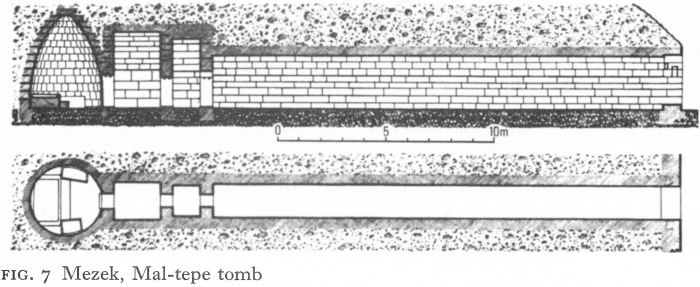
Fig. 7 Mezek, Mal-tepe tomb
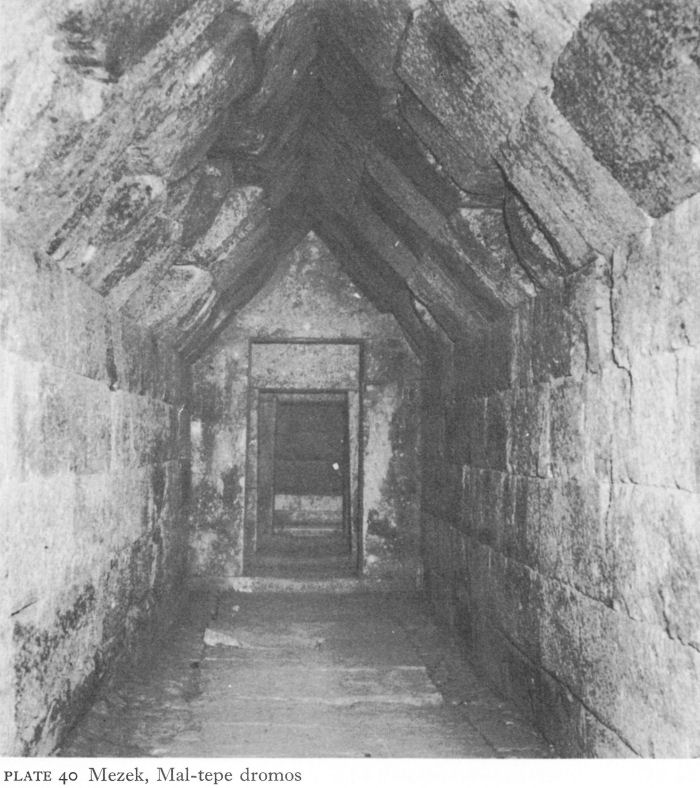
Plate 40 Mezek, Mal-tepe dromos
![]()
69
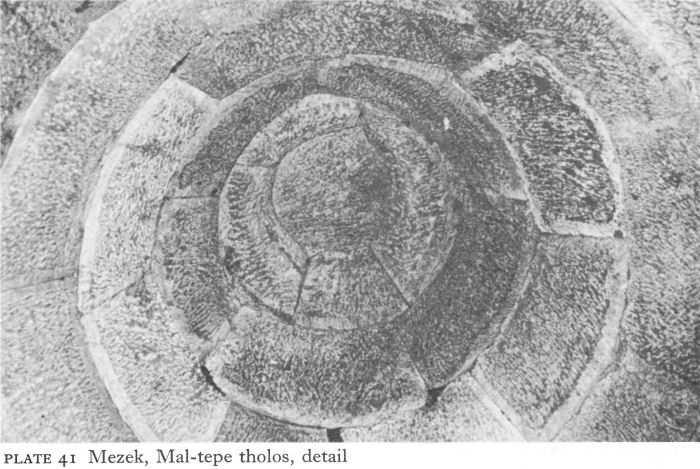
Plate 41 Mezek, Mal-tepe tholos, detail
The balance of such evidence as exists seems to give them Douvanli.
III. MEZEK
Almost on the Turkish frontier, the village of Mezek is about 8 kilometres west of Svilengrad, where the Maritsa creates its gap between the eastern Rhodopes and the Sakar hills. Some 25 kilometres eastward is Turkish Edirne (Roman Hadrianopolis and Thracian Uskudama), an Odrysian tribal centre strategically placed at the junction of the Maritsa and the Tundja, with access downstream to the Aegean Greek colony of Ainos. Around Mezek and extending into Turkey is a large and widely scattered necropolis with several groups of tumuli, nearly all of which were plundered in Antiquity - a Roman lamp in one tomb tells its own story. A direct link with Uskudama is possible, but surface and chance finds, particularly from a flat-topped hill where remains of a medieval fortress still dominate the region, show the existence close to Mezek of an important Iron Age settlement, which prospered especially in the fifth and fourth centuries b.c. This lead has still to be followed up, but at least two other Thracian forts guarding the area have been located.
Mal-tepe (Imanyarska tumulus)
This tumulus is usually known by its Turkish name, meaning ‘hill of the treasure’, although the Bulgarian ‘mound of the treasure-hunter’ is equally appropriate. The largest mound of the whole necropolis, its diameter is about 90 metres and its present height about 14 metres.
Early this century, peasants poking round the foot of the mound stumbled on the life-size bronze statue of a wild boar.
![]()
70
The size and weight - 177 kilograms - made it embarrassingly difficult to sell with the circumspection necessary for maximum profit. But a leg, broken off in antiquity, was found nearby. Following a familiar tradition, the peasants sent the single limb to Plovdiv, hoping to stimulate a large offer for the whole body. But the secret was not kept. Mezek was then in Turkey, where the authorities, once alerted, halted negotiations, although some years elapsed before the boar was surrendered to the Archaeological Museum of Istanbul. A Turkish excavation had reached only the retaining wall when the First World War ended operations; post-war territorial changes transferred Mezek to Bulgaria.
Quiet fossicking by the peasantry continued. In the early 1930s three men unearthed part of a bronze candelabrum, also at the foot of the mound. The next day they came on the tomb entrance, but it was a dark and frightening hole. The superstitious and thoroughly scared trio returned to the village for physical and moral support. They returned with a team which, headed by the mayor and teacher and equipped with lanterns, entered the tomb. Unfortunately, although archaeologists came quickly and traced many of the grave goods, the tomb had already been cleared, except for two under-floor burials. The position of the grave goods could only be doubtfully ascertained by questioning the peasants who removed them. The tomb appeared also to have been disturbed in Antiquity. None of the bones, said to include those of horses, had been kept, except for one horse’s tooth.
The retaining wall had long been used as a quarry. Originally it was about 5 metres thick, faced with huge flagstones, also used to close the entrance. Outside the latter were the remains of a carelessly constructed building of unknown dimensions, containing in its debris the burnt bones of a large animal, possibly a horse. This structure was outside the retaining wall and thus must have remained visible.
The entrance, on the north-east, was built of horizontally laid ashlar blocks, the upper three stepped and topped by two blocks meeting in the centre. This led to a dromos, similarly corbelled but with the overhanging ends of the blocks trimmed to form an even surface (Pl. 40). The dromos, 21 1/2 metres long and rising to a height of over 2 1/2 metres, is impressive in its proportions and perfect dry-stone masonry. After two rectangular antechambers, massive bronze double doors of a similar type and decoration to those of marble or bronze found in Macedonian tombs, opened into the tholos or beehive-shaped tomb, 3.30 metres in diameter and 4.30 metres high in the centre (Fig. 7). The consummate craftsmanship and consequent preservation of the tholos were such that the excavator could not tell if the dry-stone walls had been strengthened by iron cramps (Pl. 41). In execution and design - its simplicity (now) unmarred by any sign of plaster or painting - the tomb has an abstract and aesthetically satisfying beauty.
In spite of resemblances between Mal-tepe and the very much larger ‘Treasury of Atreus’ at Mycenae, there can be no direct relationship. The tradition of such tombs continued and sixth- to fourth-century examples occur as near to Thrace as Asia Minor, Thessaly, and the north Black Sea coast. Mal-tepe and other tholos tombs near Mezek and east of Edirne are probably most closely related to those of the fifth to mid-third centuries in the Kerch and Taman peninsulas which were built by Greek architects for the indigenous ruling class.
![]()
71
B. Filov, on the evidence of the finds, considers it unlikely that Mal-tepe was constructed before the first half of the fourth century, an opinion which is generally accepted and which agrees with the dating of Scythian tombs of a similar type. A doubt must, however, remain. Historically the fifth century, when Odrysian power was at its height and when, as at Douvanli, Thracian rulers possessed great wealth and were open to influences from many directions, cannot be ruled out. Nor, on the other hand, can the late fourth century, the date to which the earliest finds are attributed and which is supported by the Macedonian-type doors.
The furniture does not attain the standard of the architecture. A large monolithic sarcophagus opposite the entrance obviously belonged to the original burial and suggests an inhumation. The tomb and antechambers have two stone-paved floors and the sarcophagus stands on the lower, earlier one. A smaller, lower block in front was perhaps a podium for sitting beside the sarcophagus or, more probably, for offerings. Two casket-urns at each end of the podium are rectangular except where one side is curved to fit the wall, but they differ in size and crowd and destroy the symmetrical harmony of the chamber. Both had been thoroughly rifled, but in size and shape suggest cremation burials.
Nothing was found between the main chamber’s two floors, but a second, quite undisturbed burial phase was discovered between those of the two antechambers, although only 5 centimetres separated the levels. Each contained a single cremation; judging by the jewellery, both were female. Both had a silver coin of Alexander the Great, providing a terminus post quem for this phase; the other finds were dated to the last quarter of the fourth century.
The grave goods from the tomb chamber were, in the main, found scattered outside or obtained by purchase, and must have been only a small proportion of the original total from the three burials. Various little gold appliqués were recovered. A pair 3.4 centimetres high and about half as wide, ornamented with highly stylised and skilfully hammered plant motifs, seem almost to be vegetal counterparts of the stylised animal appliqués found elsewhere in Mezek, at Vratsa (p. 76), and many other Bulgarian sites. There were also several rosettes and two rectangular appliqués with filigree work framing a cornelian and a large number of gold beads.
Fragments of two iron swords, one spear, and a bronze helmet indicated at least one male burial. According to the Douvanli pattern, the two cremations would have been male and the main inhumation burial female, but Douvanli is by no means typical. Here in Mal-tepe are a group of three more or less contemporary mixed burials, and two subsequent (female) cremations.
The bronze objects, all of excellent quality and workmanship, are dated by the excavator to the latter part of the fourth or early third century. Of particular note is the candelabrum, pieces of which were found inside as well as outside the tomb, enabling a partial reconstruction. A tripod terminating in curved lion legs bore a long stem, from the top of which two hooks probably carried lamps on chains. Above them was poised a dancing faun, holding up a cup shaped like a large open flower (Pl. 42). The vigorous realism of the carefully executed figure is especially noticeable in his diabolically mischievous face. The diadem above his horns and animal ears is of a distinctive kalathiskos or basket type; apparently formed from overlapping leaves.
![]()
72
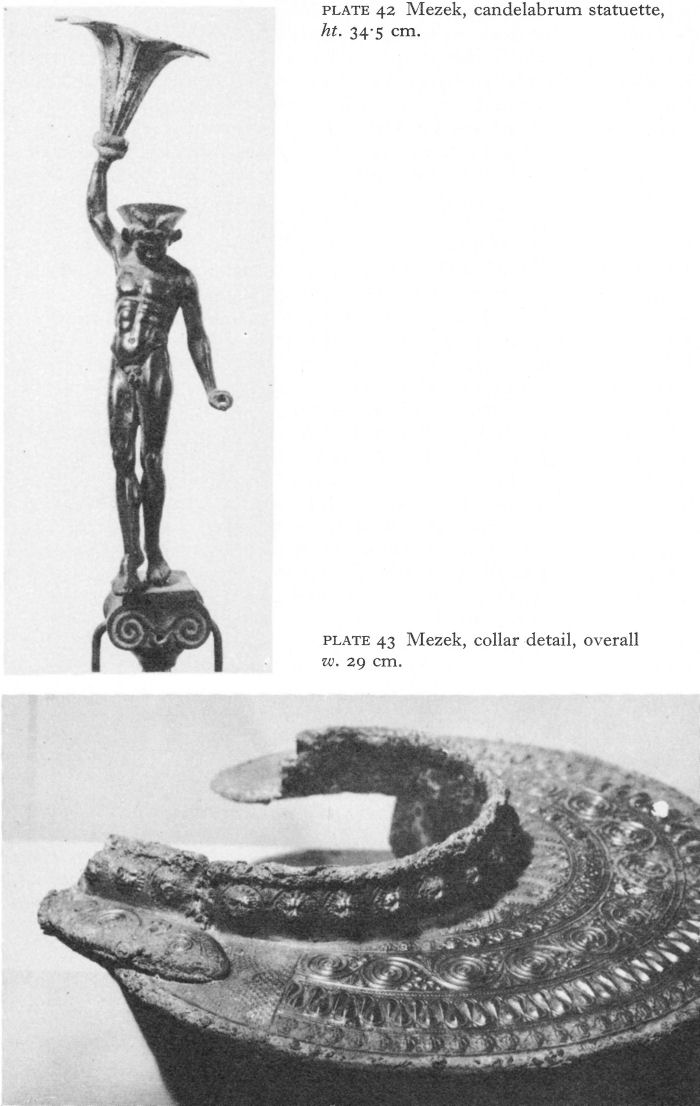
Plate 42 Mezek, candelabrum statuette, ht. 34.5 cm.
Plate 43 Mezek, collar detail, overall w. 29 cm.
![]()
73
Bronze vessels included a situla with twin mobile handles below which were palmette decorations so elaborate as to suggest stylised faces of satyrs. A plainer cauldron had a single handle with a ring for hanging it over a fire. Jugs of various shapes, including an askos, an asymmetrical vessel with its mouth off-centre and a single handle, were beautifully proportioned and ornamented at the handle base. A round lion-head appliqué, a ring in its mouth, was found by the door and almost certainly decorated it. The only surviving examples of pottery, three amphorae, two of them Thasian and one locally made, cannot certainly be linked with the other finds.
The under-floor burial in the inner antechamber was the richer of the two. The grave goods included a gold bead necklace from which hung by a broad ring a filigree-decorated pendant like a more elaborate version of the Douvanli bullae (p. 59), and a gold wire chain necklace with lion-head finials. There were also five gold lion-head earrings like others at Galata, near Varna, and Seuthopolis, and objects resembling fish scales. More finds were a glass alabastron, coloured glass beads and numerous ones of clay, clay grapes, and gilded clay objects with heads like raspberries recalling the wreaths found in Apollonian graves (p. 39) and elsewhere, a broken silver needle, and several spindlewhorls. The grave goods in the outer antechamber were somewhat similar but generally less costly. Neither approach the wealth of the Douvanli female burials.
Other finds have features which are not pure Greek or Thraco-Greek. These include an elaborate lunula-shaped iron collar which, although highly ornamental, was also a very serviceable piece of armour (Pl. 43). The upper surface was plated with silver on which traces of gilding remained. A series of concentric bands of different relief motifs began with lion heads on the vertically raised neck-guard. Then came rows of highly stylised palmettes, tiny human heads, a broad vegetal band with continuous symmetrically spiralling tendrils springing from a central female bust, an almond-shaped motif, and, lastly, another row of human heads. Filov points out that although all the motifs are Greek and fulfil the most exacting technical requirements, by treating them without apparent relation to meaning or size, an abstract and ‘barbaric’ effect quite contrary to the canons of Greek art is produced. He draws comparisons with fourth-century b.c. Celtic art, notably the Amfreville helmet; nevertheless he classes the collar with Thracian pectorals and suggests that it was made in a Black Sea or Aegean colony, possibly Amphipolis.
L. Ognenova-Marinova and I. Venedikov relate the collar to fragments from two tumuli near Vurbitsa and Yankovo,both on the north slopes of the eastern Stara Planina. The Yankovo find was also connected with a circular stone tomb chamber, although only the base row of stones has survived. Both fragments appear very like the Mal-tepe collar in shape and incorporate the spiralling tendril motif in almost identical fashion. These authors attribute the non-Greek features of the three pieces to oriental influences. [14] P. Jacobsthal, on the other hand, has suggested southern Italy as a possible origin for the Mal-tepe collar. [15]
There was also a group of small bronze objects, some with stylised human heads of a type that Jacobsthal has identified as metal parts of a Celtic chariot. [16] The question thus arises of a third burial phase during the Celtic occupation in the third century b.c.
![]()
74
The Celts were accustomed to tumulus burials and Mezek lay well within the estimated boundaries of their kingdom; one so magnificent and with a clearly indicated entrance might have proved irresistible.
The bronze boar may perhaps provide support for the theory of a Celtic phase. This animal had a chthonic significance for both Thracians and Celts, but no other Thracian tumulus is known to have been associated with a wild boar, other than by a boar’s tooth among the grave goods or boars’ bones among those of other animals consumed during ritual feasting. In Celtic areas, apart from boar figurines, an actual boar burial in a stone tomb with grave goods has been excavated at Sopron-Bécsidomb in Hungary and burials of wild boar were associated with two chariot graves in the Champagne area of France - in one case the ritual knife remaining in the carcase. [17] At Mal-tepe the original site of the boar is unknown. The animal is realistically though roughly modelled. There is an impression of bristly fur with no suggestion of muscle or bone, but behind the boar’s right ear is a spear wound from which fall three drops of blood.
The collar is superior work and doubtfully Greek. There is a likelihood of the boar being made by or for the Celts; the chariot parts are Celtic. We still know almost nothing about the Celtic kingdom in Thrace, but if the collar is Celtic, it reflects the Persian influence on Celtic art in which Thrace and its art played an intermediary role.
Other Mezek tumuli
Near Mal-tepe, on a hill called Kurt-kale, another tholos tomb was found in a tumulus only 30 metres in diameter and six high when investigated. The tomb had been thoroughly looted in Antiquity and there remained only some horse bones in a bowl and amphora fragments. Entered from the south, the tomb had no dromos and only one antechamber preceded the beehive-shaped tomb chamber, its base diameter just over 3 1/2 metres and height nearly the same (Fig. 8). The antechamber was roofed by a corbelled vault of four layers, each comprising Tour stone blocks laid across the corners of the row below. The construction of the tomb was characterised by the same meticulous workmanship that marks Mal-tepe. The stone blocks were carefully rusticated except for a smooth narrow strip round the edges and, again, no plaster or paint was discernible. The floors had been dug up by the robbers and no tomb furniture had survived.
Remnants of another ashlar tomb were found in the smallest tumulus of the necropolis. Ploughing had greatly reduced its size and most of the stones had been removed, but in one corner two or three rows of regularly laid blocks remained from what had been a simple rectangular tomb, oriented east-west and measuring 6.26 by 2.80 metres. The stones were carefully smoothed and squared except that three outer faces remained rough and uneven. The east-façade-wall was squared inside and out. The tomb was destroyed in Antiquity and the mound re-used for a second burial. However, the first still contained a human skull, a small iron axehead, an iron arrowhead, a blue glass bead, a small coarse greyish-black pot, other pieces of local grey and red pottery, fragments of a Greek black-glazed vase, and one of a small red-figure vase. The last, according to the excavator, suggested a fourth-century terminus ante quem for the tomb.
Some interesting grave goods were found by chance just outside the village. Any tumulus or cairn that had existed had been completely eroded and no remains of any form of tomb were found;
![]()
75
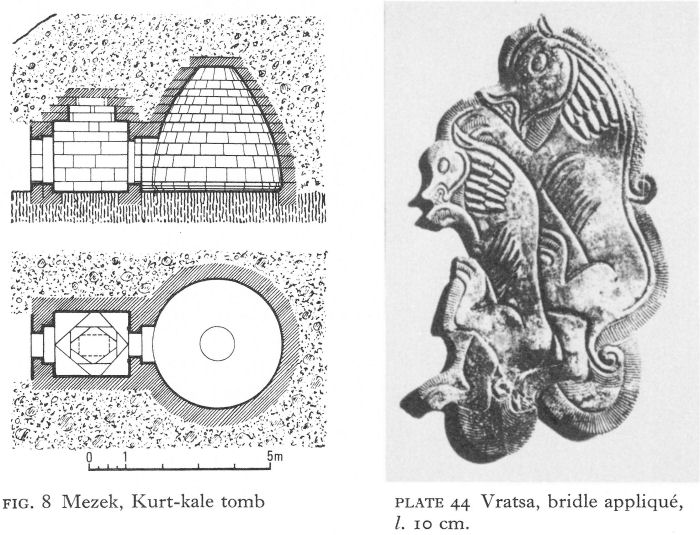
Fig. 8 Mezek, Kurt-kale tomb
Plate 44 Vratsa, bridle appliqué, l. 10 cm.
the burial thus appears either to have been straight into the earth or else in a wooden coffin or lined pit now completely perished. The offerings included a deep silver mesomphalos phiale with a ribbed bowl showing Achaemenid influences. [18] and four silver harness appliqués, one a frontal with a lion head erect above two horned animal heads, the others flat side-pieces, each portraying three stylised panther or lioness heads. These latter have a general resemblance to examples in the fourth-century second burial at Vratsa (Pls. 44, 46, 47) and contemporary finds elsewhere in Bulgaria, Romania, and south Russia. Among bronze objects were a damaged situla, a biconical jug, a shallow dish, and a shallow flat-shouldered pot (Fig. 6), all grave goods represented at other sites. Some iron fragments were probably the remains of scale armour, and sherds were found of imported pottery.
The Selska tumulus, second largest in the whole necropolis, was just north of the village. It had a diameter of 80 to 85 metres and was a little under 13 metres high. Although almost entirely excavated, no signs of a primary burial were found. Instead, at ground level in the centre of the tumulus a wooden post 1 1/2 metres high, remnants of which had survived, had been erected and a cairn of small pebbles piled around. Above this was a small mound of black earth followed by a layer of larger stones and then another of black earth. On top of this, layers of soils of various colours had continued to be laid, at least until the twentieth-century height of the tumulus was reached. The soil, unlike the earth used for the other mounds, contained very few potsherds, suggesting an early date, perhaps before the period with which this book is concerned. Possibly the Selska mound was either a cenotaph or a ritual burial of an ancestral deity.
![]()
76
IV. VRATSA
The town of Vratsa lies on the northern edge of the Stara Planina almost due north of Sofia, with which it is linked by the Iskur gorge and relatively easy passes. In the pre-Roman era it fell within the territory of the Triballi, a tribe always outside the Odrysian sphere.
In 1965, workmen digging foundations for a new building in the town centre penetrated a mound known as the ‘Mogilanska mogila’ and came on a mass of rough stones and rubble, indicating a grave. An immediate salvage dig showed the excavation to be of such importance that work was still continuing when I visited the site in 1969. Preliminary publications of the finds, however, permit some account to be given of a series of major burials of added interest because of their geographical situation.
Three burials were discovered in the mound, which had a stone and rubble base varying in height from 60 centimetres to 1.30 metres. The first, built of uncut stones at the original ground level, was circular, with a diameter of 9J metres. Looted and almost entirely destroyed at a very early date, no indication of the roofing survived. Some human bones were found inside, and just outside a red-figure Kerch-style skyphos, a deep stemless cup with two horizontal handles. Other pots included a glossy grey Thracian cup, in shape between a skyphos and a kylix. The red-figure skyphos provides a terminus ante quem of about 380 b.c. and, taking the later burials into consideration, this one probably dates to early in the second quarter of the fourth century.
Later in the same century, the mound above the round chamber was levelled, a second tomb built in the southern part of the tumulus, and the mound heap re-formed. This was the tomb found in 1965. The complex, 12 metres long inside and four wide, consisted of two east-west oriented rectangular rooms, the main tomb chamber and an anteroom, connected by a short passage. The walls were formed by irregular dry-stone layers, with other stones heaped round them. The floor was of stamped clay and the roof had been of wooden beams nailed together.
Near the entrance to the antechamber were the remains of a four-wheeled chariot. The skeletons of two horses, yoked to it for their ritual slaughter, lay where they had fallen, the iron bits still in their mouths. The chariot, the earliest found in Bulgaria, seems to have been a heavy vehicle with iron-rimmed wheels and other iron parts. Beyond it lay the skeleton of a riding horse, its bit made of silver and its harness decorated with 20 silver appliqués, 11 of them on the bridle. The discovery of the last was especially important as it showed for the first time the position of the appliqués - which are a common feature in Thracian burials.
A frontal occupied the centre of the horse’s forehead - an erect animal head, in this case of a fantastic beast (Pl. 46). It had been made by hammering silver sheet on to a mould, the details being worked with a chisel. The neck was holed to take the bridle strap or cord. The other bridle appliqués were in five pairs, all examples of highly stylised animal art, flat and carved in low relief. One pair showed a lion attacking a horned animal (Pl. 44); the rest were cut-out animal heads, usually three, sometimes accompanied by one or more other animals, encircled round a central boss and enclosed within a border (Pl. 47). Shallow silver rings were soldered to the backs to attach them to the harness.
![]()
77
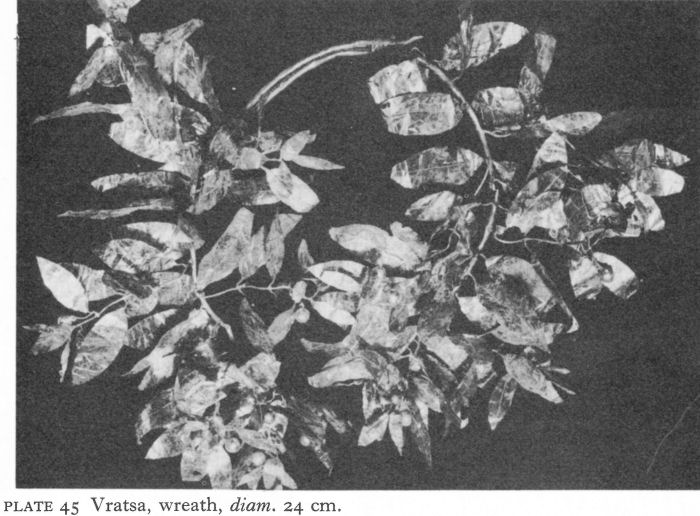
Plate 45 Vratsa, wreath, diam. 24 cm.
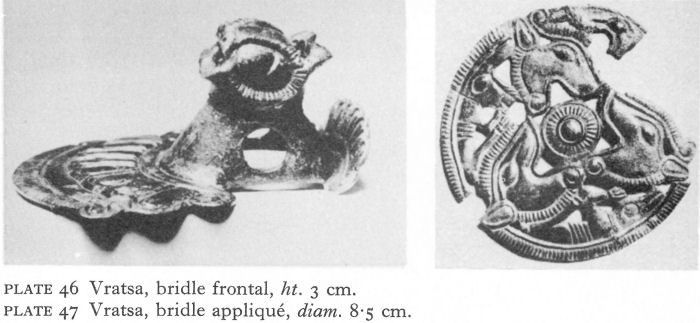
Plate 46 Vratsa, bridle frontal, ht. 3 cm.
Plate 47 Vratsa, bridle appliqué, diam. 8.5 cm.
These appliqués reflect a fundamental difference between Thracian and Scythian stylisation in their general rejection of distorted posture. All the other nine silver appliqués from the harness were virtually identical female heads, flat at the back, where there was a bronze ring, and clumsily moulded. No reconstructions of the chariot or horse harness have yet been published.
Also in the antechamber, near the riding horse, lay the contorted skeleton of a young woman, aged about 24. The head of the iron spear that had killed her was still between her ribs. She is thought to have been a slave, since the only other object by the body was an iron fibula - no doubt a dress fastening - near the shoulder. Eighteen iron spearheads were found nearby.
![]()
78
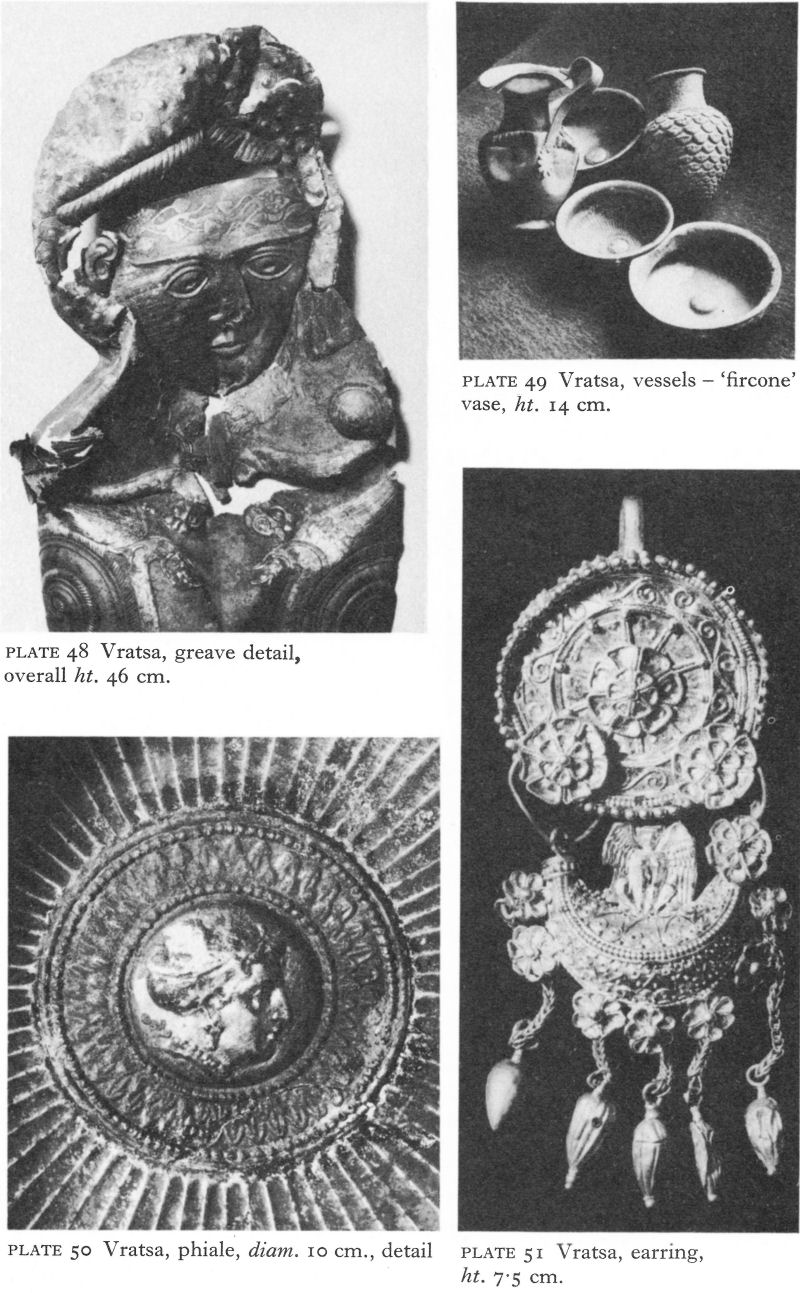
Plate 48 Vratsa, greave detail, overall ht. 46 cm.
Plate 49 Vratsa, vessels - ‘fircone’ vase, ht. 14 cm.
Plate 50 Vratsa, phiale, diam. 10 cm., detail
Plate 51 Vratsa, earring, ht. 7.5 cm.
![]()
79
The main tomb chamber contained a double burial, a man aged about 30 and a woman about 18. [19] The man’s grave goods lay on his right. Much of the armour was badly damaged by the collapse of the roof, but a magnificent silver greave survived almost unscathed (Pl. 48). The knee-guard consisted of an ivy-crowned ‘Medusa’ head. Serpents and fantastic reptilian beasts emerge from her tresses; two others, one winged, the other clawed by a bird, decorate the shin-guard. Selective gilding of the monsters and the head, including horizontal bands across one side of the face, heightens the effect of the skilfully worked decorative motifs. A pair of greaves from a Thracian grave at Agighiol in the Romanian Dobroudja is very similiar and may have come from the same workshop, although they lack the creative vitality of the Vratsa find.
There was also a badly smashed bronze helmet, fragments of a curved iron sword in a scabbard, of knives or daggers, and of a quiver with 80 bronze arrowheads, some with parts of wooden shafts. Beyond the arms and armour were bronze and silver vessels, the former including two situlae and a hydria, the latter a small handleless flask, the lower conical part entirely covered by overlapping scales to give the impression of a fir-cone (Pl. 49), a scarcely bigger jug with gilt fluting on the shoulder and the handle terminating in a palmette, and five phialai. One of these last, of the Greek type and with fine radial fluting, has soldered to the centre a medallion of a female head in profile, framed in bands of leaf ornament (Pl. 50). The others, plain and of the mesomphalos type, all bore the pricked words ΚΟΤΥΟΣ ΕΤΒΕΟΥ. Kotys is a common Thracian name, borne by several kings and occurring in other inscriptions on phialai; the second word still awaits clear interpretation.
The female skeleton lay on the left of the male. Like the slave woman, she had been killed - or had committed suicide. The knife which pierced the left breast had not been withdrawn and the position of the bones suggests that she was left as she fell. A fine laurel wreath of gold, weighing just over 200 grams, was still round the skull (Pl. 45); and by the ears were a pair of elaborate, exquisitely worked gold earrings of the disc and boat type first introduced about 360 b.c. [20] From a concave disc worked in filigree and granulation hung an intricately decorated boat, bearing a sphinx, from which bud pendants had been suspended by tiny chains. Both disc and boat were adorned with rosettes (Pl. 51). Earrings of this general type have been found in the Thracian Chersonese, in south Russia, and at Eretria. A bronze hand mirror lay by the left hand, and gold hair pins were also found. Forty tiny gold rosettes and palmettes strewn about the head and neck had probably ornamented a veil. Round the neck was a glassbead necklace with a multicoloured pendant, a satyr-like head with beard and bulging eyes - perhaps an amulet. Little clay figurines and other objects nearby recall the collections at Douvanli.
This tomb provides interesting archaeological support for Herodotos’ account of the ritual sacrifice of the favourite wife (p. 30). Although Vratsa is far from the areas he knew, the custom is one he describes as belonging to the unidentified Thracians who lived beyond the land of the Krestonians, whose territory lay north of the Chalkidiki peninsula. As the grave goods include Greek imports, it is possible that Herodotos was told of such a ceremony by a trader who had visited the Triballi. This double burial probably took place about the middle of the fourth century.
![]()
80
The third Vratsa burial is believed to have been a double inhumation, although the tomb was looted and the bones scattered. Again consisting of two rectangular chambers, together measuring 13 1/2 by 6 metres, it was outside the original retaining wall of the mound. A horse’s skeleton, lacking head and neck bones, with some plain silver and bronze harness appliqués but no bridle ornaments, lay in the antechamber. Grave goods left behind included ten much-oxydised bronze plaques, a rotted leather quiver with 73 bronze three-edged arrowheads, and two small iron knives. A bronze fibula and a ring with a bird carved on its bezel could have belonged to a man or a woman; possibly feminine belongings were a tiny gold bird, a gold pendant, and fired clay objects - balls and other shapes, anthromorphic figurines, miniature boots and vases - again suggesting magical practices. There was also a flat-handled silver jug, 8 centimetres high, with a vertically channelled spherical body like that from the Bashova tumulus, and another little jug of gold, 9 centimetres high, with a handle composed of a ‘Herakles’ or reef knot. The shoulders have a band of linked palmettes, below which two quadrigas, each with single drivers, are placed back to back. In front the leading horses are on either side of a giant palmette. These figures show a combination of naturalism and primitive stylisation which suggest local work, comparable with some plaques found at Letnitsa, further east along the northern edge of the Stara Planina, and of approximately the same period (Pl. 5).
Fragments of Attic black-glaze pottery helped to date the tomb to about the middle of the second half of the fourth century. Full publication of the Vratsa tumulus will add greatly to archaeological knowledge of antique Thrace.
NOTES
1. Higgins, R. A. Greek and Roman Jewellery, London, 1961, 141.
2. Strong, D. E., Greek and Roman Gold and Silver Plate, London, 1966, 77.
3. ABV 400.
4. Sandars, N. K., Antiquity XLV, 1971, 108.
5. Richter, G. M. A., The Furniture of the Greeks, Etruscans and Romans, London, 1966, 56.
6. Strong, op. cit., 78-9.
7. Mikov, V., Izsled. Dechev, 668-9.
8. This follows B. Filov, but I. Velkov’s excavation report (IBAI VI, 1930-31) does not mention that the phiale contained ashes.
9. Strong, op. cit., 80.
10. Snodgrass, A. M., Arms and Armour of the Greeks, London, 1967, 92.
11. ARV 1643.
12. Kurtz, D. C. and Boardman, J., Greek Burial Customs, London, 1971, 210.
13. Herodotos VII, 111.
14. Ognenova-Marinova, L., Actes 1st BC, II, 397 ff.; Venedikov, I., IBAI XXXI, 1969,
15. Jacobsthal, P., Prahistorischer Zeitschrift XXV, 1934, 86, n. 28.
16. Jacobsthal, P., Early Celtic Art, Oxford, 1944, 151-2, Cat. nos. 164, 176.
17. Joffroy, R. and Bretz-Mahler, D., Gallia XVII, 1955, 5 ff.
18. Strong, op. cit., 100 ff.
19. Nikolov, B., Obzor II, 1970, 79.
20. Higgins, op. cit., 123.
4 Macedonian and Hellenistic Infliences
I. PHILIPPOPOLIS
Philippopolis (Plovdiv), on a group of hills, overlooking the river Maritsa, occupies the most commanding position of the whole Thracian plain. The Yasa-tepe tell on its outskirts flourished in the Late Neolithic and Chalcolithic periods. Resettlement began nearby at the end of the Bronze Age on Nebet-tepe, one of three hills linked by a precipitous ridge. Stratigraphic excavation and pottery finds here have shown a gradual expansion which appears to have accelerated considerably between the sixth and fourth centuries when, according to Ammianus Marcellinus, the site was known as Eumolpias. The necropolis of the pre-Roman city has not been discovered, although one tumulus of the fifthfourth and one of the third century have been excavated. The first, on top of Yasa-tepe, was a simple cremation burial; a second nearby was revealed by the chance find of a fine third-century grey Thracian kantharos (Pl. 52).
A monumental tomb, dated to the late fourth or early third century, lies across the river to the north. The entrance, of two upright monoliths surmounted by an even more massive third, led into a flat-roofed ashlar antechamber, 1 1/2 metres square. The tomb chamber, 2.45 metres wide and 2.20 metres long, was similarly constructed, except for a domed ceiling, formed, like the antechamber at Kurt-kale, of three rows of stone blocks laid diagonally across the corners of those below. The chamber had been painted, and there are sculptured fragments of a Macedonian-type bier with stone imitations of turned wooden legs. The tomb had been thoroughly robbed, leaving only a late fourth-century coin and fragments of a gilded clay ‘raspberry’ wreath.
The settlement’s increased prosperity was undoubtedly due to Greek trade. Strategically placed at a naturally defensible crossroads, with access by the Maritsa to the Aegean, it stood on the ‘Diagonal’ route between Europe and Asia and at the junction of others leading south-west through the Rhodope and Pirin mountains to the Mesta and Struma valleys, north over the Stara Planina to the Danube, and north-east via Beroe (Stara Zagora) and Kabyle (near Yambol) to the Black Sea cities of Mesambria, Anchialos, and Apollonia.
Following his conquest of Thrace, Philip II established a Macedonian contingent on and around the three linked hills - Nebet-tepe, Djambaz-tepe, and Taksim-tepe - and renamed the ‘city’ after himself. These hills have remained the city’s core, and for much of Antiquity its citadel, although the urban boundaries soon extended to include three others - Djendem-tepe, Sahat-tepe, and Bounardjik-tepe. The Greeks might call it maliciously ‘Poneropolis’ - the ‘city of criminals’ - but Philip’s name has stuck. Thracians either used the Greek form or a Thracian version, ‘Pulpudeva’. The Slav name was ‘Pupuldin’, the Turkish ‘Filibe’, and the present ‘Plovdiv’ derives through medieval SlavoBulgar variants of the Thracian version. The Romans renamed it ‘Trimontium’, but Philippopolis continued to be used.
81
![]()
![]()
82
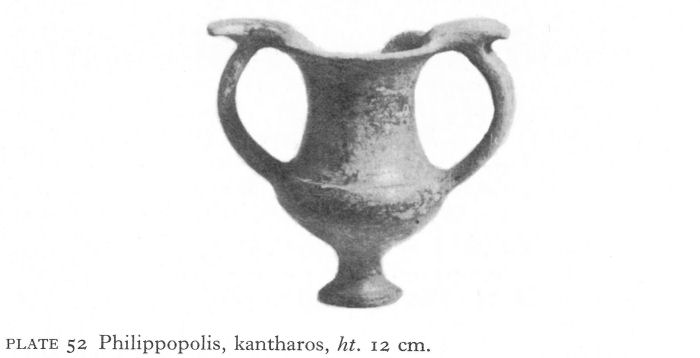
Plate 52 Philippopolis, kantharos, ht. 12 cm.
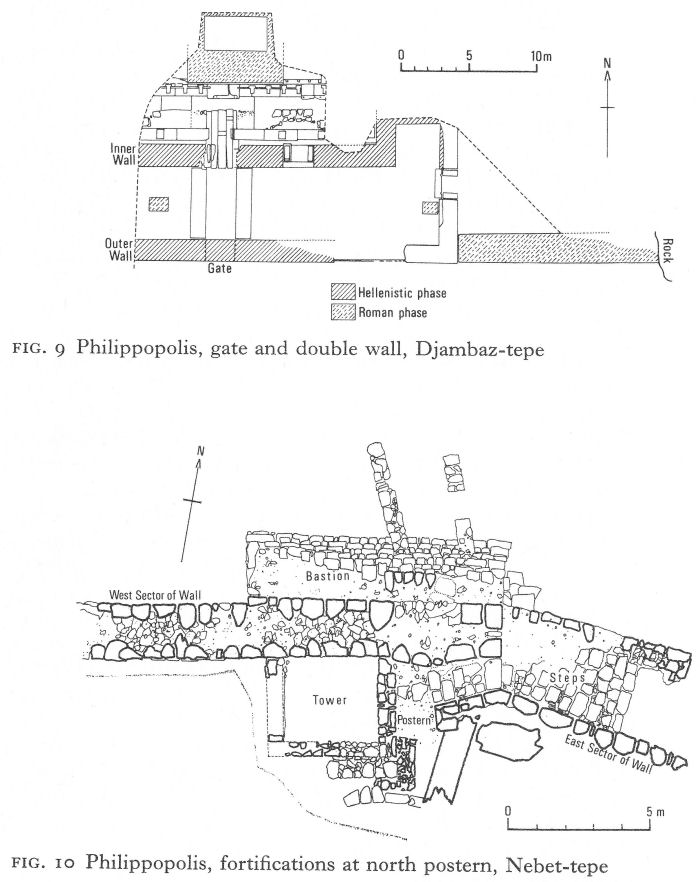
Fig. 9 Philippopolis, gate and double wall, Djambaz-tepe
Fig. 10 Philippopolis, fortifications at north postern, Nebet-tepe
![]()
83
Yet, on present archaeological evidence, neither Philip nor Alexander appear to have been responsible for the Hellenistic fortifications of the city described in 1868 by A. Dumont. ‘On voit a Philippopolis’, he writes,
les vestiges d’une enceinte pelasgique. Ces fragments des murs sont au sommet d’une colline tres escarpee de trois cotes, la colline de Nebet-tepe, une des trois acropoles qui donnerent autrefois son nom a la ville de Trimontium . . . Toutefois l’histoire . . . et plus encore la maniere primitive dont les murailles sont construites, nous prouvent qu’elles appartiennent a la haute antiquite. Les pierres, de grandes dimensions, ne sont pas taillees; elles ont la forme des polygones irreguliers et sont assorties sans ciment, de maniere a ne laisser entre elles aucun interstice. Ces restes de murs, au nombre de trois, sont situes sur le cote de 1’acropole qui regarde la Maritza. Le plus septentrional mesure 6 metres de long sur deux environ de haut; les deux autres, qu’on voit a l’est, offrent a peu pres les memes dimensions. [1]
The excavator of the Hellenistic wall of Nebet-tepe, L. Botousharova, states: ‘One can trace it along high parts of the north slopes of Nebet-tepe and on the ridge of the peak it passes over a paved area of a settlement strewn with pottery of the second half of the fourth century’. Of the buildings inside the walls, she says: ‘We have reason to think that the Thracian settlement did not evolve quickly into a real Hellenistic city. In the second half of the fourth century, Philippopolis must have been a small settlement; no street paving or big buildings have been found.’ [2] It seems that in the Macedonian period the function of Philippopolis may have been military rather than administrative. The surviving walls are, in general, situated on the steeper slopes which, in the time of Philip, might have been considered relatively secure without the massive defences which have now been exposed. The easier slopes have been inhabited for over two thousand years; any trace of Macedonian or Thracian fortification here would long ago have been destroyed.
Stretches of Hellenistic wall have been discovered on both Nebet-tepe and Djambaz-tepe. On the latter, sectors of two parallel walls, 5 metres apart and facing south, were found with a vaulted entrance in the outer leading by an unroofed corridor to a gate in the inner (Fig. 9). Both walls, varying from a little under to a little over 2 metres thick, were faced on both sides with irregular, roughly cut blocks of local syenite and light grey mortar, with an emplecton of broken stone mixed with mortar. The outer gateway, 2.20 metres wide, was arched by nine trapezoidal sandstone blocks rising to 3 metres at the keystone. The inner gateway was similarly vaulted, except that the blocks forming the vault projected well over 2 metres inside, in the opinion of the excavators to support a floor connected with the defences. [3]
On the north edge of Nebet-tepe the Hellenistic fortifications excavated were: two sectors of curtain walling; a bastion; an internal tower; and a flight of steps climbing to a postern gate (Fig. 10). The western sector of the curtain wall began at a sheer rock face and, mostly laid directly on the rock surface (Pl. 53), ran in a straight line east-north-east for about 33 metres, passing outside the postern to end at the top of the steps. Its eastern end, for a length of 9.20 metres, had walls 2.10-2.40 metres thick and was protected by the bastion; over the remaining length the thickness was a constant 2 metres.
![]()
84
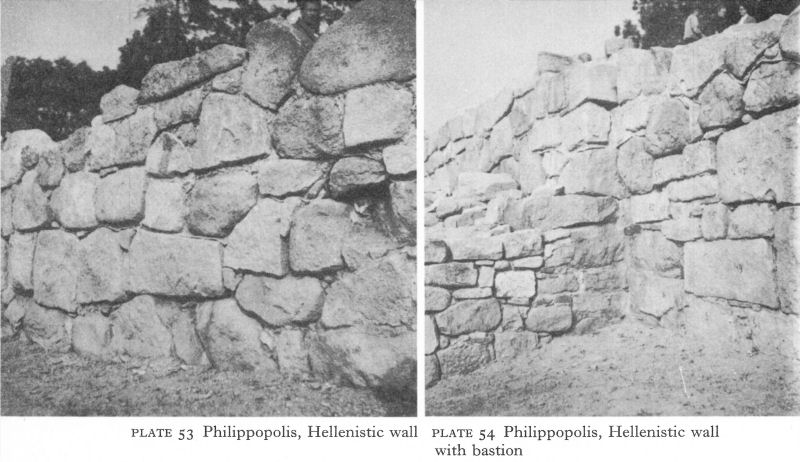
Plate 53 Philippopolis, Hellenistic wall
Plate 54 Philippopolis, Hellenistic wall with bastion
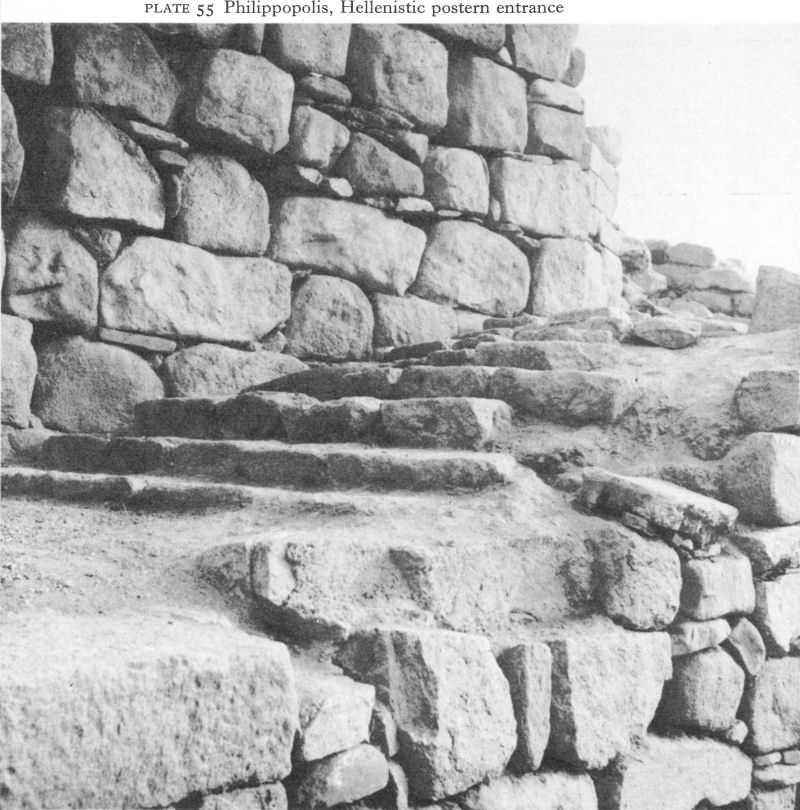
Plate 55 Philippopolis, Hellenistic postern entrance
![]()
85
An emplecton of tightly packed stone was slightly reinforced by mortar towards the outside. The inner face was laid without mortar and the large stones were unworked. On the exterior, the outer faces had mostly been roughly shaped and laid on beds of light grey mortar, also used to plaster over the joins, in the interstices of which pieces of tile and flat stones were wedged. Occasionally, larger and better-finished blocks are noticeable. Seemingly at random, the wall had been strengthened by inserting the facing stones as 'headers’ lengthways into the emplecton.
The stepped bastion was about 3 metres deep at its base, built directly on top of soil against an already strengthened wall (Pl. 54). Behind was the postern gate and the internal tower. Traces of two parallel walls extended from the bastion down the north slope as though remaining from an earlier entrance to the fortress.
Continuing without a break east of this western sector of curtain wall was the retaining wall of the staircase (Pl. 55). Eight stone steps, laid without mortar, separated it from the eastern sector of the curtain wall, which was faced in a similar manner but set further back than the western. For a distance of about metres before the top step, the curtain wall bent to create a platform some 80 centimetres wide in front of the postern gate. The inner part of the wall and its continuation east to another sheer rock face was rebuilt in the Roman or Early Byzantine period (Pl. 176).
The almost square tower - 3 by 3 1/2 metres, with walls about 70 centimetres thick using light grey mortar - stood behind the bastion commanding the approach to the postern. It was entered from the south. Beneath the south-east corner, a 20- to 40-centimetre layer of earth containing black-glazed sherds was found above a pavement of river stones, thus providing a fourth-third-century terminus post quem for this building. L. Botousharova advances this date to the end of the third century on the ground that the light grey mortar was not used earlier, and she considers these fortifications to date between the third and the first centuries. [4] Lysimachos, therefore, seems the most likely ruler to have initiated these defences, although his work may have been heavily damaged, by either the Celts or the Thracians, and then reconstructed by the latter sometime before or after the Macedonian occupation of the city in 183 b.c.
II. THE PANAGYURISHTE TREASURE
Diodorus Siculus tells a possibly apocryphal story about Lysimachos when captured by the Getai in 293 b.c., but set free by their king Dromichaites after being offered a symbolic banquet, aimed to secure the peaceful continuance of Getic rule over the Danubian territories. The banquet was prepared to show two ways of life. The Getai sat on straw, ate humble food off wooden boards, and drank from horn or wooden cups. Lysimachos and his fellow Macedonians (their captured goods being used for the purpose) were seated on draped couches before a silver table bearing a magnificent feast with wine poured into gold and silver cups. The story ends in Lysimachos’ assent to Dromichaites’ pointed suggestion that the Macedonian way of life in their own land was preferable to that of the Getai and a consequential ‘live and let live’ agreement. [5] Whether true or not, the episode reflects a conception of Macedonian luxury which is vividly represented in a collective find made in 1949 near the town of Panagyurishte and now in the Plovdiv Archaeological Museum.
![]()
86
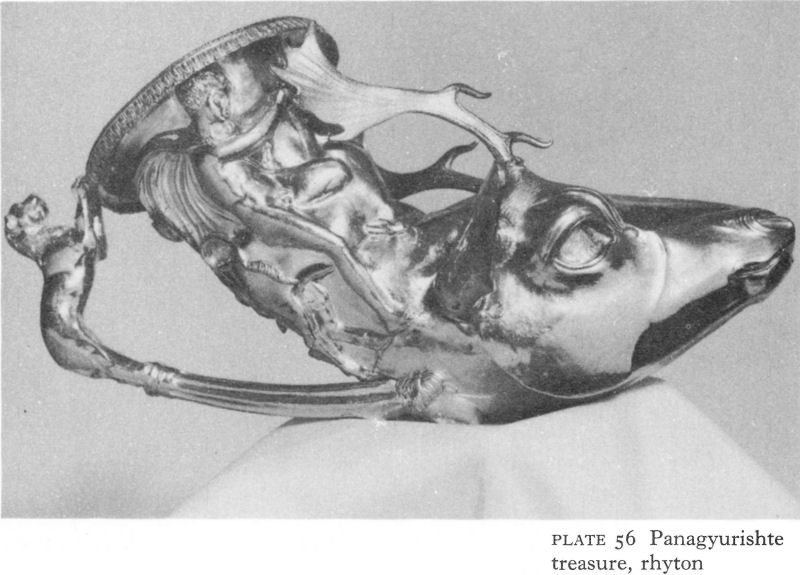
Plate 56 Panagyurishte treasure, rhyton
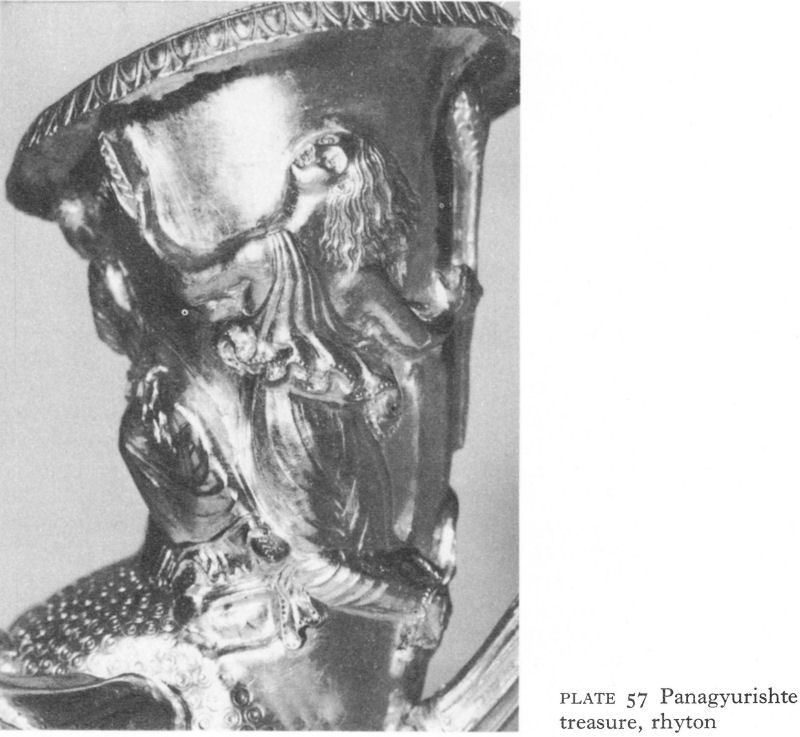
Plate 57 Panagyurishte treasure, rhyton
![]()
87
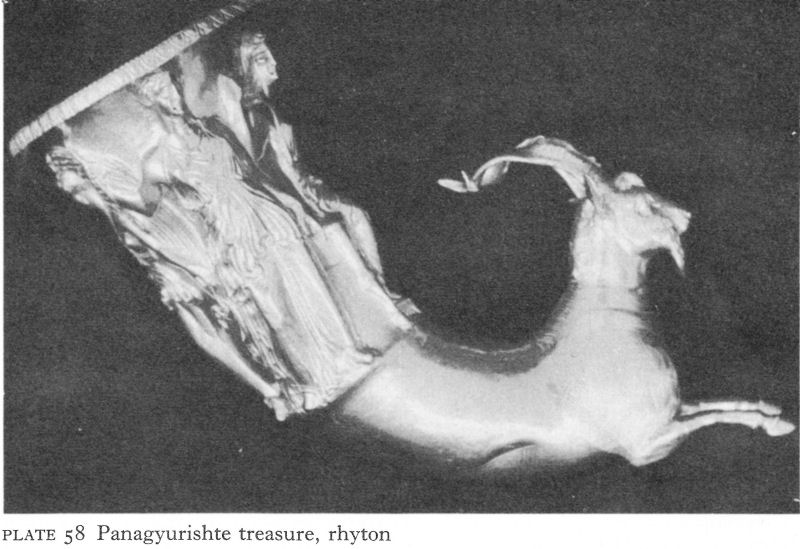
Plate 58 Panagyurishte treasure, rhyton
The find consisted of a gold hoard of nine elaborately decorated gold vessels, weighing a total of 6.10 kilograms.
Seven were rhyta, three of them in the form of animal heads, one horn-shaped but ending in the foreparts of a goat, and three vases in the form of erect female heads. In addition, there was an amphora-rhyton with two drinking spouts enabling it to be used simultaneously by two persons, and a large phiale mesomphalos. All were of pure gold, formed by being hammered on to moulds which produced repousse relief decoration, with details etched by a chisel. The work of more than one craftsman and, in all likelihood, more than one workshop, the objects were probably assembled over a period of time.
The three animal-head rhyta, all with handles, form one contemporary group. Two have stag heads with branching antlers (Pl. 56) and the third a ram’s head with well-flattened horns, the drinking spout being in the animal’s lower lip. The upper part is decorated in high relief with figures from Greek mythology, usually named. The handles are in the form of a lion, placing its forepaws on the rim of the vase and standing on a fluted column, terminating at the base with a female head. One of the two stag-head rhyta, 13 1/2 centimetres high and weighing 674.6 grams, depicts the Judgement of Paris, although Paris is called here Alexander. The other, 13 centimetres high and weighing 689 grams, shows Herakles capturing the Arkadian stag and Theseus fighting the Marathon bull, scenes not identified by name. The composition of the second rhyton is symmetrical and, unlike the first, with its elaborately draped figures, Herakles wears only a lionskin and Theseus a chlamys, or short cloak. The ram’s-head rhyton shows Dionysos and a maenad, Eriope, both seated, with an unnamed dancing maenad on either side (Pl. 57).
The horn-rhyton, 14 centimetres high and weighing 439-05 grams, is slimmer,
![]()
88
handleless, and more gracefully proportioned than the head-rhyta (Pl. 58) although lacking the classical restraint of the earlier example at Douvanli. The drinking spout is between the goat’s forelegs. Above is Hera, enthroned, with Artemis and Apollo, each holding a bow, on either side. At the back is a Nike. All four figures are named.
Two of the three female-head rhyta - usually thought to represent Amazons - are almost identical, although from different moulds. They are 21 1/2 and 22 1/2 centimetres high and weigh 460.75 and 466.75 grams respectively. The tall concave neck of the vase is mounted on thick tresses of hair, caught up, behind, by a star-studded veil which is tied in front with a bow. The base of the woman’s columnar neck is encircled by a necklace with pendants, a lion head in the centre having its mouth as the spout. The much smaller neck of the third vase - 20 1/2 centimetres high and weighing 387.3 grams - springs from a helmet decorated with two griffons. The curly hair, unconfined, falls freely round the helmet to the base of the vase. It has a similar lion-head spout, and all three vases have handles very like those of the animal-head rhyta, except that a winged sphinx replaces the lions and palmettes the female faces.
The largest object in the treasure is the amphora-rhyton. Twenty-nine centimetres high, it weighs just under 1.70 kilograms (Pl. 60). Comparison with the silver-gilt amphora from the Koukouva tumulus at Douvanli is interesting. The form and proportions of the neck are different; that of the Panagyurishte amphora is taller and the concave profile, with its exaggerated lip resembling those of the female-head rhyta, reflects a stylistic debasement. But there are many resemblances: the plain neck, the shape of the body, and the handles, except that centaurs have here replaced the fantastic beasts and there is no spout. The shoulder again has the customary lotus and palmette bands, repousse work in fairly high relief, although much lower than that of the scene below, which is an entirely new departure.
Below one handle a double door is slightly ajar to reveal the head and forearms of a terrified old man. Five warriors approach, four brandishing swords, the fifth sounding a horn. The foremost is already hammering at the door. All loom considerably larger than the old man and are even taller than the doorway. (I. Venedikov suggests this may be intended to show perspective.) Each is naked except for a chlamys, and heavily muscled. Four are bearded, the fifth, much younger, is clean-shaven. The faces of the four swordsmen express tense ferocity. This scene occupies most of the space, but between the back of the trumpeter and the door is an apparently unconnected scene of an old and a young man, leaning on knobbed sticks and conversing calmly. No identifications are given and the scenes have been variously interpreted, perhaps the most likely being episodes from the Seven Against Thebes.
On the base of the vase the mouths of negro heads provide two spouts. Since the rhyton is held aloft when drinking, the bottom is also decorated. The infant Herakles is fighting two snakes; with him is a bearded old man, wearing an ivyleaf crown and drunkenly holding a kantharos to one of the spouts (Pl. 61).
The phiale mesomphalos, 25 centimetres in diameter and 3 1/2 centimetres high, and weighing 845.7 grams, is made from a gold lacking the reddish tinge apparent in the other vases (Pl. 59). Its massive plain rim encloses three concentric rows of 24 individual negro heads in high repousse relief, palmettes filling the intervening spaces.
![]()
89
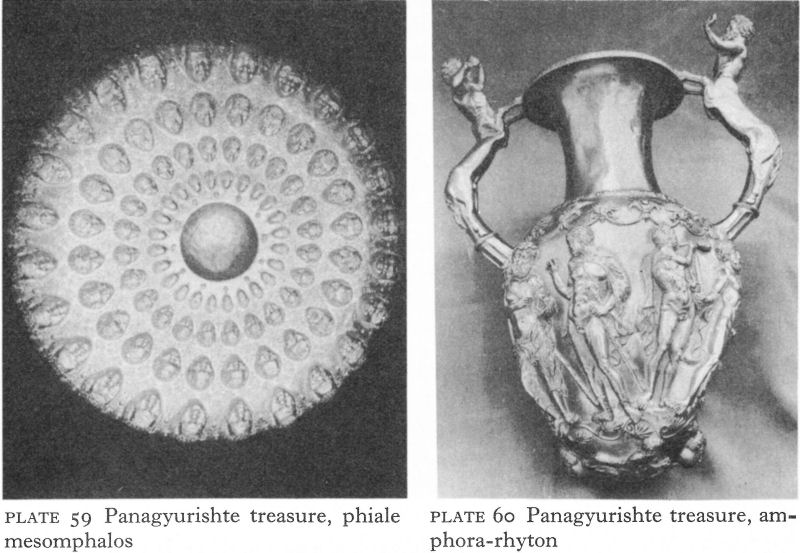
Plate 59 Panagyurishte treasure, phiale mesomphalos
Plate 60 Panagyurishte treasure, amphora-rhyton
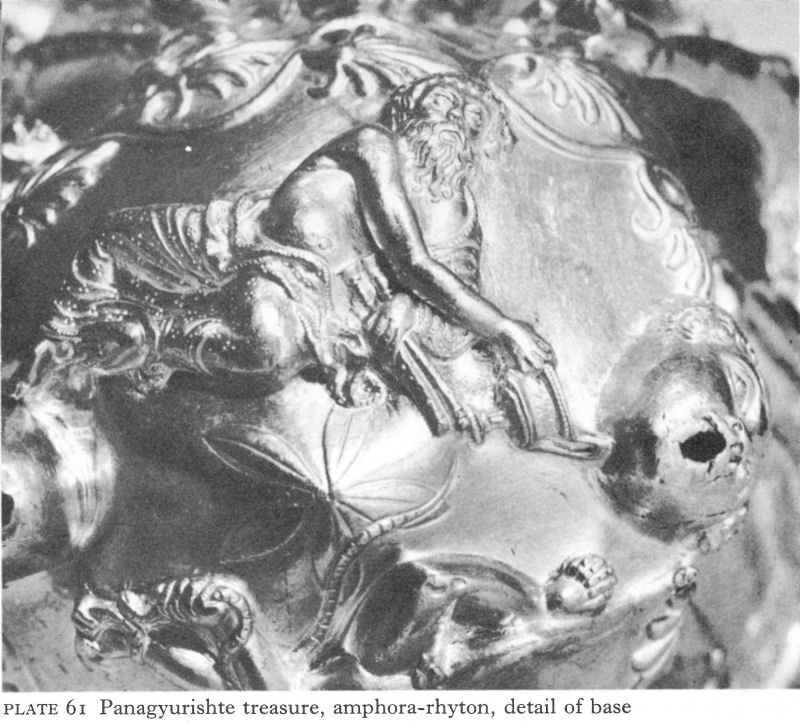
Plate 61 Panagyurishte treasure, amphora-rhyton, details of base
![]()
90
The heads gradually decrease in size as they approach the omphalos, ringed by 24 acorns. A possible clue to its origin is provided by two weight stamps, one expressed, like that on the amphora-rhyton, in terms of Persian darics, the other in Greek drachmai. The Persian unit used was the gold daric (or its Greek equivalent, the stater) of Lampsakos on the Asian shore of the Dardanelles, a city whose coins were slightly heavier than normal, usually weighing about 8.44 grams. Since the mark signifies 100, this would represent approximately the weight of the phiale measured by this unit. The Greek drachma, on the other hand, was a silver unit which replaced the gold daric as the standard of currency in Asia Minor soon after the death of Alexander the Great. Although this type of phiale is known from the late fifth century, it is a reasonable assumption that the Panagyurishte example came from a Hellenistic city of Asia Minor, probably Lampsakos, shortly before or about the time of the death of Alexander in 323. Possibly the original or a later purchaser may have insisted on its being re-stamped according to the new standard, not necessarily in Asia Minor. Alternatively, it may have been made several decades earlier and been stamped for the first time in Lampsakos in the twenties of the fourth century.
The name of Hera on the horn-rhyton is written in Ionic dialect, whilst in the scene of the Judgement of Paris (or Alexander) on a stag-head rhyton it appears in Attic dialect, but as the figure bears no resemblance to portraits of Alexander, this only suggests that the inscription was added at a time when Attic had superseded Ionic in Asia Minor, and merely provides a terminus ante quem for this group of rhyta. The substitution of Alexander for Paris reflects adulation of the former, but is unlikely to have been made in his lifetime. Oriental influences are strongly apparent in the amphora-rhyton. They can also be traced in the flowing and elaborately detailed apparel of most of the figures on the rhyta.
Regarded as a whole, the impression given by the treasure is of extravagant, even barbaric flamboyance. The element of Hellenistic ‘baroque’, expressing an exuberant triumph that ruptures the boundaries of taste to spread into gluttony, nevertheless retains a certain aesthetic validity and occasionally reaches standards of superb craftsmanship. The era of Alexander the Great represented a breakaway from the petty despotisms and quarrels of the Greek city-states. It was a vision of a new world and artistically such a concept went to people’s heads, as later in Europe the Counter-Reformation committed extravagances and excesses when freed from the unnatural restraints imposed by those fulfilling an historic necessity for reform,
With the possible exception of the phiale, the hoard may be dated variously to about the last quarter of the fourth century and the first quarter of the third. How it was assembled is unknown, as are the dates of the different objects. The trite uninspired nature of some of the figures may be due to inferior workmanship or to later degeneracy. Probably about the end of this period it was buried - almost certainly to preserve it from an enemy - near a Thracian settlement of local importance and prosperity in the Sredna Gora foothills.
Venedikov writes that the treasure was ‘produced not in a country with ancient Greek traditions of art, but somewhere in the Hellenistic East which had not yet rid itself completely of its Persian tradition’. Certainly not made for Greeks, the obvious candidates are Macedonians or Thracians.
![]()
91
The former are the more likely - the irresistible conquerors and liberators - although the twin spouts of the amphora-rhyton smack of the Thraco-Scyth. It is necessary to remember that the gold artefacts found in Macedonia and Thrace must represent only a minute proportion of what then existed. So much gold did not have to belong to Alexander or Lysimachos. Made for or assembled by a Macedonian, it may have passed to a wealthy Thracian, someone likely to appreciate a good drinking set, especially a gold one. Whoever hid the treasure, the Celtic invasion of about 279 or the subsequent establishment of the Celtic kingdom was probably the reason. The evidence of the labourers who dug it up suggests careful burial, carried out by either a local chief or a military leader facing disaster with little time to spare. A fleeing general is usually suggested, but perhaps the local chief of this secluded hill-land, which contains tumuli and the remains of several fortresses, is more likely. It is difficult to discern any religious purpose for the vessels, although they might possibly have been offerings to some sanctuary.
III. BRANICHEVO
Philip II's annexation of Thrace probably had little direct effect on the countryside outside the path of military operations. A group of Getic tumuli near Branichevo, 60 kilometres north of Shoumen on the road to Silistra - though like the Dolno Sahrane graves, not to be considered typical - illustrates the burial practices of a small group of simple Thracians at this time.
Eleven tumuli were excavated. In the four smallest, 5 or 6 metres in diameter and J metre or less high, destruction had been severe and finds were minimal. Three others were 6 to 8 metres across; they were scarcely higher than the destroyed group, but contained burials, as did another three with diameters of 12 to 15 metres and about 1 metre high. By contrast, one mound was 41 to 44 metres across and over 4 1/2 metres high. All had originally been higher and perhaps wider. The disparity in size between the one large tumulus (another large one was not excavated) and the rest was reflected in the grave goods. These also dated the whole group to between the middle of the fourth and the beginning of the third centuries b.c.
Burial was without exception by cremation, but in only one case did this take place within the tumulus area. Here the corpses of a man and a woman, with their clothes and appropriate equipment or ornament, were burnt on a pyre which was fierce and prolonged, judging by the thick layer of black ash and embers, the baked earth below, and the remains of the bones. Fragments of little jugs suggested the addition of libations and a feast was indicated by numerous scorched bones of calves, sheep, goats, pigs, and fish as well as amphora fragments in the earth of this and the other mounds. Afterwards, the man’s bones, mixed with those of animals, were placed in one urn and the woman’s similarly mixed in another. In the man’s urn were also.two curved iron knives; in the woman’s three spindlewhorls, three beads, and a silver coin of Apollonia. The simple tongue-handled urns were placed in a pit beside the pyre with three small jugs and a cup made of coarse local ware arranged round them; two better-quality bowls, turned upside down, lidded the urns. The whole was covered by an earth mound.
It is interesting to see in this simple burial another apparent corroboration of the description by Herodotos of Thracian funeral rites and to find that the Getai may also have killed and buried the wife simultaneously with the husband (p. 30).
![]()
92
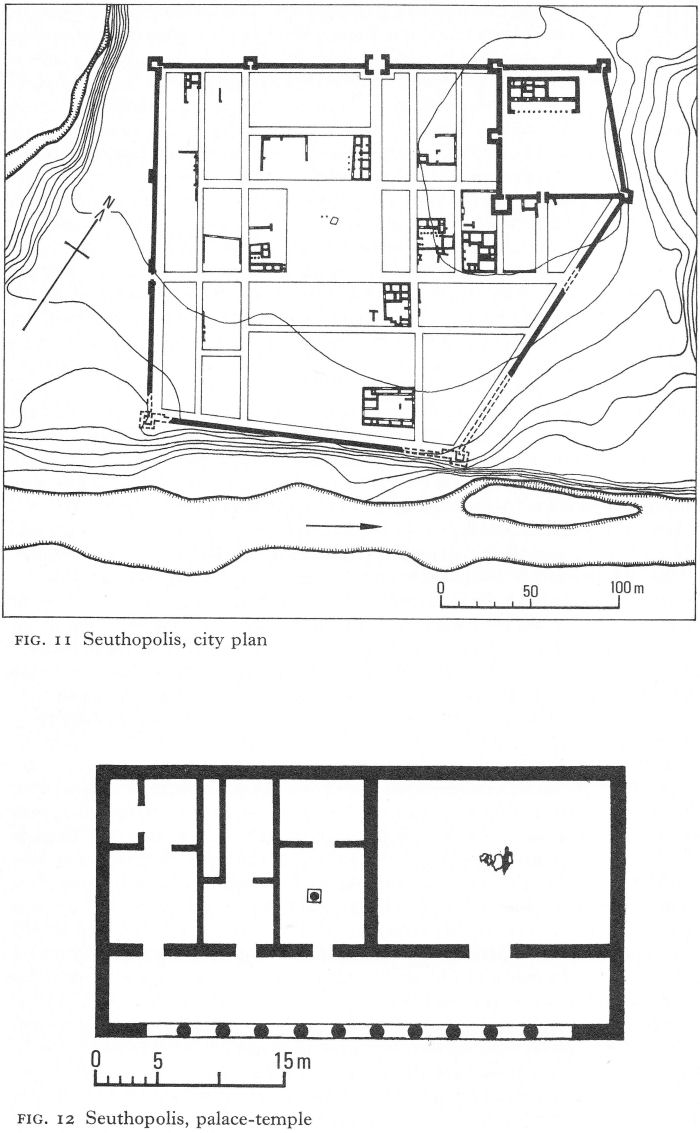
Fig. 11 Seuthopolis, city plan
Fig. 12 Seuthopolis, palace-temple
![]()
93
The presence of the pyre is the main difference between this and the other small tumuli. In one, a bowl, lidded by another, contained the burnt bones of a child; in two, there was only one bowl containing bones, but whether of one or two persons could not be ascertained. In another tumulus, human bones were distributed among five bowls, two of them lidded; one bowl also contained three knives, a second a short sword and a wild boar’s tooth, and a third five spindlewhorls. As all the bowls were small, the largest only 17 centimetres high, 29 centimetres across at the rim, and 12 centimetres at the base, this probably also represented a 'husband and wife’ cremation. Another mound covered at least four separate interments, perhaps members of the same family.
The large tumulus was clearly erected for the local chief. Inside was a rough, more or less rectangular, tomb, constructed of river stones mortared with clay. A few bones had been put into an amphora, together with a gold pendant. Two other amphorae stood in a corner and grave goods of various kinds were placed on the floor. Armour consisted of a bronze helmet with short nose and cheek guards and a substantial rear neck guard, and numerous pieces of an iron hauberk. The latter was made of strips, some decorated with small bosses within embossed circles, linked by tiny rings; it appeared to have been decorated by a small snake made from silver wire. The only weapons were three broken iron spearheads. A bronze appliqué composed of three horses’ heads symmetrically arranged round a circular boss and two silver bell-like pendants were probably bridle ornaments of symbolic significance, as no horse bones were found. As well as the two amphorae, provision for eating and drinking included a twin-handled bronze situla, much damaged and undecorated except for two incised lines below the rim and a simple palmette between the twin handle rings; and a small silver phiale, not quite 7 centimetres high, of the common Achaemenid type, with a flat base. The lower half had an overall decoration of repousse lozenges, the concave upper half was plain but had inscribed on opposite sides: ΤΗΡΗΣ and ΑΜΑΤΟΚΟΥΓΑΔΡΥ ΙΗ. A clay kantharos was a local copy of a Greek model.
The chief’s wife was buried separately in a peculiar fashion for this period and place. A shaft, later filled with broken stones, was sunk and from the bottom of its western side a hole, measuring approximately a cubic metre, was hollowed out, then packed with burnt bones, grave goods, and earth. Apart from a single black-glazed clay bowl on a ring base and a bronze hand mirror, all the offerings were ornaments, among them a round bronze clasp and a bronze arc-shaped fibula, a silver pendant and several appliqués, including one of gold leaf with a rosette motif similar to that on the clasp.
The settlement linked to the necropolis evidently had a short life. It may have been annihilated through natural or human causes, the clan may have temporarily exhausted the soil and moved on, or may simply have emigrated to a safer or more profitable position. We know it only through its dead.
IV. SEUTHOPOLIS
The construction of the Georgi Dimitrov dam near Koprinka, a village 4 kilometres west of Kazanluk in the Valley of Roses, unexpectedly opened an unknown chapter of Thracian history.
![]()
94
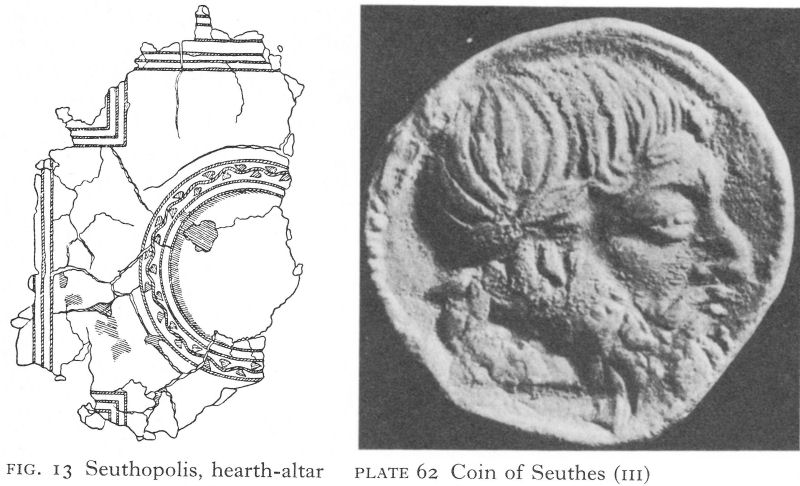
Fig. 13 Seuthopolis, hearth-altar
Plate 62 Coin of Seuthes (III)
A seven-year salvage dig, begun in 1948, brought to light the remains of a carefully planned and fortified city of the fourth-third century b.c. Unrecorded in the sources, an inscription found in the sixth year of the work identified it as Seuthopolis - the city of Seuthes. The site, now under the waters of the dam, awaits its full publication; thus conclusions based on the brief, although authoritative, information available in some general articles and preliminary studies are necessarily tentative.
Seuthopolis stood on a low terrace of the Sredna Gora inside a sharp bend of the river Tundja, which, running 4 to 5 metres below the site, gave further protection by its confluence here with a small tributary (Fig. 11). The fortifications, forming an irregular pentagon, used these natural advantages so that only the north-west wall occupied an exposed position. The walls were about 2 metres thick, except on the south-west where, the ground falling steeply to the river, they were a little less. Foundations of two rows of large stones carried a mud-brick structure reinforced by a wooden framework, fastened by long iron nails found in large quantities. Roughly square towers, three-quarter projecting, occupied the four main angles. Three partly projecting towers reinforced the fifth corner and the north-west wall. A gateway, probably double, in the centre of this wall was defended by a half-projecting rectangular tower. Another entrance in the east wall seems only to have required reinforcement by bastions.
The area enclosed was small, no more than about 5 hectares. The greater part consisted of streets and buildings laid out on a normal Hellenistic grid plan, but in the northern corner, which was also the highest point, was a citadel, possibly a fortified residence (tyrsis) or a temple complex, separated from the rest of the city by towers and a curtain wall fully as powerful as the outer defences. The principal structure in this citadel was rectangular and stood near the north-west wall. It consisted of a large hall, 18 metres long and 12 metres wide, occupying the north-east end, and three subdivided rooms (Fig. 12).
![]()
95
Four doorways opened from them on to a colonnaded portico which ran the whole 41 metres length of the building and faced a large rectangular courtyard, paved with pebbles, leading to a fortified gateway. The usual Hellenistic construction of mud brick on stone foundations had been embellished by imported terracotta antefixes and other architectural ornaments. A Doric capital and the bottom drum of a granite column found in the courtyard may have come from either the colonnade or the monumental gateway. Fragments of painted stucco, with wax added to the paint to give a glossy finish, and stone fragments from the interior of the great hall suggest a black-tinted stone plinth round the base of the walls and a dado imitating polychrome marble slabs. The upper parts were Pompeian red and the ceiling white. A clay hearth altar occupied a central position, and another was found in the middle of the next room. The base of a staircase was discovered in one room.
The citadel area excepted, a road ran right round the inside of the city walls. From the north-west and south-west gates two streets, 6 metres wide and paved with pebbles, led into the agora, which was relatively large - 46 by 48 metres. Narrower, similarly paved streets ran parallel to the two main ones and divided the city into building blocks of varying sizes. Nor were the excavated houses uniform. Some were built round a peristyled courtyard; others had their main rooms shielded by a southern portico with wooden columns on stone bases facing a more or less open courtyard. The foundations were of broken stone and clay; the mud-brick superstructure sometimes had a wooden framework; the roofs were tiled. In one house the remains of stairs were found. Most houses had a hearth altar in the main room. Like those in the inner fortress, they were usually decorated with incised geometric and vegetal ornamentation (Fig. 13).
Although the city was small, the houses were spaciously planned, usually extending from one street to the next. Two or three might make up a whole block, and an area of 300-350 square metres was common; the largest house covered 500 square metres. Water came from wells, and a drainage system took the domestic waste through stone channels, clay pipes, or curved tiles to drains - usually laid along the middle of the streets - which, utilising the gradient, emptied through spouts in the curtain wall into the river.
Bones of domestic animals, several iron ploughshares, and blades resembling pruning knives indicated a farming economy. There was plenty of wheel-made local grey and red pottery. Imported ware included Thasian amphorae and a great deal of Attic black-glazed pottery. Terracotta figurines were also popular, possibly originating from Odessos or the Dobroudja colonies.
Eight hundred of the 1,300 antique coins found were issues of Seuthes. Their ten bronze denominations indicate an advanced money economy. As considerable numbers have also been found, singly and in hoards, along the upper reaches of the Tundja, Seuthes’ kingdom was apparently concentrated in the present Valley of Roses. T. Gerasimov has noted two types of coins. [6] One carries his name and a horseman on the reverse and the head of Zeus on the obverse, in the manner of Philip IPs coins. The other is broadly similar, but the face of Zeus, though still bearded and with flowing, laurel-crowned locks, is far more individual (Pl. 62). Gerasimov suggests this is a portrait of Seuthes. The supposed portraits vary considerably, but the head illustrated certainly fits a ruler with Seuthes’ remarkable powers of survival over a period of exceptional danger and strife.
![]()
96
Plainly present, too, is the craftiness of one capable of correlating his own image with that of the king of the gods in a manner to appeal to Thracian loyalties and religious ideas without open offence to his probably nominal Macedonian suzerain; the coins might merely be Thracian imitations of Philip’s issues. Gerasimov’s interesting suggestion is supported by the publication so far of only a few coins and the mint has not been identified; there is no reason to suppose it was Seuthopolis.
The inscription identifying Seuthopolis was a decree carved on a marble slab found in the room next to the great hall of the citadel. The greater part of the Greek text, which was intact, is still unpublished, although translations into Bulgarian, Russian, and Latin have appeared. [7] The decree appears to record a solemn undertaking by one Berenike and her four sons - Ebrizelmes, Teres, Satakos, and Sadalas - consequent upon an act of Seuthes whilst he was in good health. Two other persons are concerned, Spartokos and Epimenes, one by name Thracian and the other probably a Macedonian. The presumption is that Berenike - a Macedonian name - was either the widow or the wife of and regent for an aged or ill Seuthes. The details of the undertaking are obscure, but it is expressly stated that the decree is to be carved on stone slabs to be set up at Kabyle, in the Phosphorion - probably a temple of Artemis and Hekate - and in the agora, and at Seuthopolis, in the temple of the Great Gods and in the sanctuary of Dionysos by the agora.
As a fragmentary inscription in the Seuthopolis agora mentions a Thracian priest of Dionysos, it is generally assumed that the temple of the Great Gods - usually the Samothracian Kabiri - was the great hall in the inner fortress. It is the earliest indication of the Kabiri cult in the Thracian interior. One passage in the decree may mean that the sanctuary was controlled by Berenike and her sons and that Epimenes had taken refuge there, as was the custom on Samothrace. If, as is thought, the citadel enclosed both the temple of the Great Gods and the royal residence, priestly functions on the part of the royal house would be implied, as Herodotos says was the practice among the Bessi. Such functions could accord with an identification of Seuthes with Zeus on coins. Berenike’s name appears alone in the conventional ending as the person especially responsible for ensuring the undertaking is kept, giving rare epigraphic support for the archaeological evidence of the princely graves on the status of women among the Thracians.
Seuthes - the third Thracian king known of this name - is first mentioned in written sources as rising against the Macedonians in 325, when Alexander was embroiled in Asia. In 323, there was an indecisive battle between Seuthes and Lysimachos. Ten years later, Seuthes agreed to support a league of Black Sea cities against Lysimachos (p. 52), but on the latter’s unexpectedly speedy arrival Seuthes changed sides. However, when Lysimachos had to return south with part of his army to deal with an invasion by Antigonos, Seuthes joined the latter and ambushed Lysimachos on his way across the Stara Planina. A hard battle ended in victory for Lysimachos. Seuthes then drops out of the historical record, although coins issued by Lysimachos on or after 306 were overstruck with his name. Whether this Seuthes was one or more persons is impossible to say, but, usually identified for convenience as Seuthes III, it is now evident that he (or they) tried valiantly and constructively to revive the Odrysian kingdom and made good headway against heavy odds.
![]()
97
The life of the city was brief. There had been some kind of forerunner in the inner fortress area, where coins of Philip II were found with local pottery below a thin layer of ash. The new city was probably built in the last two decades of the fourth century under Greek architects, perhaps from a Black Sea city - a surmise only, because, for all tve know, a time may have come when Seuthes received substantial aid from Lysimachos. Besides the coins of Seuthes, others in the ruins date from the reign of Alexander the Great to that of Demetrios II (239-229). Numerous burnt bricks and fragments of battering rams indicate that at some stage - the mid-third century is proposed - the city was besieged, sacked, and put to the flames. A later and humbler resettlement perished after a few decades, then the Tundja flooded the area, covering it with sand and gravel. Deserted for some 1,400 years, when a small medieval village established itself here, the site of Seuthopolis has now been submerged once more beneath the Tundja’s waters.
V. TUMULI OF SEUTHOPOLIS AND THE KAZANLUK REGION
Three large tumuli near Koprinka and Seuthopolis were also excavated before being submerged by the waters of the dam. In the first, Koprinka No. 1, the cremated remains and grave goods of a Thracian woman lay at the base of a small cairn over which the earth mound had been heaped. Her gold jewellery included a necklace of 36 hollow spherical beads, half of them decorated with filigree forming a double spiral, and a pair of the lion-head hoop earrings popular in the Hellenistic period. Bronze vessels included a fine oinochoe, the base of the handle adorned with the relief head of a young satyr, and a situla with twin handles, below them a stylised ivy leaf. There was also a Greek aryballesque lekythos and other imported pottery, a clay lamp, and the terracotta statuette of a young girl.
Koprinka tumuli Nos. 2 and 3 contained inhumation burials. In No. 2, a passage almost 3 metres long led through a rectangular antechamber, measuring about 2 3/4 by 2 metres, into a tholos chamber about 5 metres in diameter. In tumulus No. 3 (Fig. 14) the tomb was smaller and had no dromos. Unlike the stone-built tholos tombs at Mezek and elsewhere, the Koprinka pair belong to a very small group, all near Kazanluk, built of fired bricks shaped in special moulds. Those used for the antechambers were rectangular, those in the circular tomb chamber were segments of the circle with appropriately curved inner and outer ends. Although the Koprinka tombs were destroyed to near ground level, bricks from the dome were easily distinguished by the slant-cut face of their inner sides, producing, like the corbelled stone slabs at Mal-tepe, a smooth, even surface. Since only one thickness of brick was used, the structure was strengthened by a ‘jacket’ of rough stones mortared with clay before the earth mould was raised.
Two other brick-built vaulted tombs have been excavated, one in Kazanluk itself, the other 13 kilometres farther east, at Muglish. Both are larger than the Koprinka tombs, Muglish, as yet unpublished, being the largest of all; both have painted interiors. A third, much-damaged tomb with signs of paintings has been found at Krun, [6] kilometres north of Kazanluk, but at the time of writing no details of it are available.
![]()
98
Tumulus No. 2 at Koprinka contained two secondary inhumations; both were in rectangular brick graves, roofed by stone slabs and just big enough for, in one case, a male with an iron spear and strigil and, in the other, a female whose few grave goods included a gold necklace and fibulae. The bricks used, as well as those in a similar grave on the edge of the dam, were not new but, as is clear from their shapes, came from the destroyed domed tombs.
The available evidence points to a late fourthor early third-century date for all the graves, probably with no great lapse of time between the three types. Although this was the high period of prosperity for Seuthopolis, within the city the use of fired brick was extremely limited and, in almost all cases, the bricks were re-used, Only mud brick seems to have been employed in the buildings. Suddenly therefore, for a very brief period, it appears that well-fired bricks of good quality were manufactured in a highly skilled and sophisticated manner exclusively to construct domed tombs. Then, apparently no less suddenly, this brickmaking ceased, although the old bricks were used for new tombs of a quite different type - one that corresponded to a cist grave - and for utilitarian purposes in the city. The origin of the craftsmen with the skill not only of brick-making but of building circular domed chambers is, as is their fate, an unsolved mystery. Perhaps a consequential benefit of Seuthes’ relationship with Antigonos was a visit from Greco-Syrian craftsmen who took their secret with them when they departed or died. But there is no evidence to support such an origin. It can only be said that the importance of the burial ritual to the Thracians is again emphasised.
The first brick tholos tomb was found in 1944 in Kazanluk. Its fortuitous excavators were troops digging an air-raid shelter in what was thought to be a natural hillock, 7 metres high and 40 metres in diameter. The soldiers, fortunately tunnelling from the south, soon came upon and burst through a rough masonry wall to find the entrance to a narrow room that was blocked at its north end by a large rectangular granite slab. Knocking this down, they came into a circular chamber decorated with curious paintings. At this point archaeologists took over the ‘air-raid shelter’ and began an attempt to conserve a splendid and unique example of Greco-Thracian tomb painting.
The tomb (Fig. 15) consisted of a now much-destroyed, roughly constructed outer chamber, probably unroofed. This led into a rectangular brick-built antechamber or dromos - its precise function is unclear - with a ‘gabled’ ceiling formed by overlapping slant-cut bricks. The brick-built, beehive-shaped chamber into which this opened had a diameter of 2.65 metres and reached a height of 3.25 metres. The top was slightly truncated by a massive square capstone, the lower part of which was carved to form a round ‘stopper’. As at Koprinka, the bricks were specially tailored to give a smooth and rounded inner surface, and the tomb was reinforced by a ‘jacket’ of broken stones mortared with clay.
Like the rest, the tomb had been looted in Antiquity, although here the structure had been undisturbed. The few remaining objects included human bones, identified as belonging to two persons, one a woman. Perished wood and nails suggested a coffin or coffins. A rusted iron spearhead, pieces of a curved knife, and an iron bit from a horse’s bridle, as well as broken horse bones (in the outermost chamber), are evidence of a male burial, but there was nothing to tell whether the two had been buried at the same time.
![]()
99
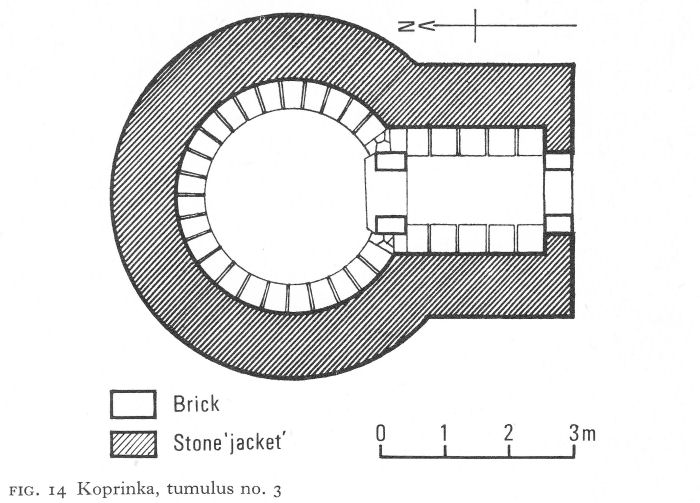
Fig. 14 Koprinka, tumulus no. 3
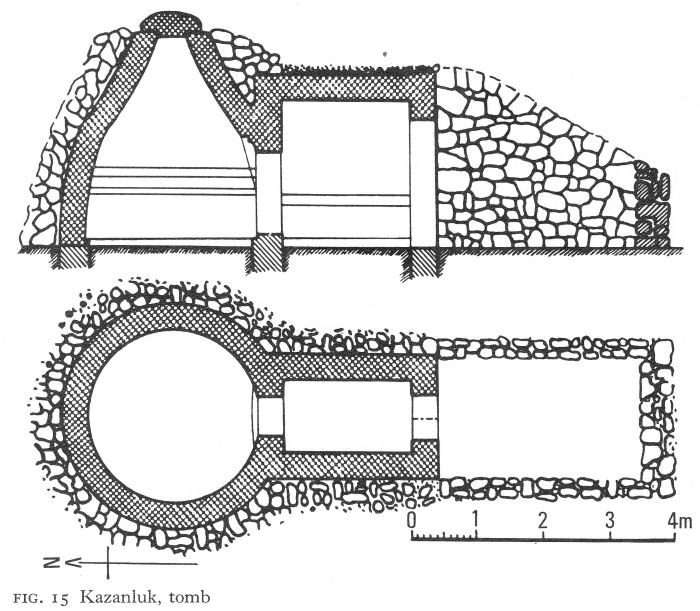
Fig. 15 Kazanluk, tomb
![]()
100
A hundred and forty tiny sequin-like gold appliqués, 1.2-1.6 millimetres across, must have come from some perished textile. Small gilded clay rosettes and vessels, almost all broken, of Thracian and Greek ware, among them a clay oinochoe and amphora, also a gilded silver jug, were found scattered about, some in the entrance chamber, by which were two sacrificial hearths.
The whole interior of the brick antechamber and tholos was painted inside and this has miraculously survived almost intact. Working with four colours, white, black, red, and yellow, the artists used tempera and encaustic, the latter given a mirror-like sheen by adding wax and marble dust. Even the entrance chamber had been plastered and coated with stucco to conceal its roughness. The floors of both inner rooms were Pompeian red. The walls imitate marble revetment, black orthostats enclosed by narrower bands of white in the antechamber, the reverse in the tholos. In both cases a wide red band covers the beginning of the curve of the vault. Above this, in the antechamber, a band with tendrils emerging schematically from a central stem runs along the walls, enclosed in narrower bands of architectural motifs. Finally, reaching to the top of the vault, a horizontal panel on each side depicts a battle scene. Although the order of battle is formal, two foot-soldiers meeting in single combat in the centre with cavalry and other foot-soldiers advancing behind them, the movements are lively and realistic, and in dress and accoutrements the four armies are individually characterised. V. Mikov has suggested that the forces at the southern end on both sides are Thracian. This is almost certainly so on the east wall, but less sure on the west.
The upper decoration of the circular chamber, consistent with the proportions of the tomb as a whole, starts at a higher level than that of the antechamber. First is a band of alternating bucrania, or garlanded ox-skulls (later ox-heads), and rosettes. Above this is the principal zone (Pl. 65). Opposite the doorway a man is seated on a multicoloured cushioned bench, before him a rectangular three-legged table bearing various foods. He wears a short-sleeved chiton, or tunic, and a brown mantle, and on his head is a laurel crown, painted yellowgold. His right hand holds a cup, his left reaches out to clasp the right forearm of a woman seated on a throne beside him while she rests her hand on his.
The man, the enthroned woman, and a woman offering him a bowl of fruit, including pomegranates, food of the dead, form the centrepiece of a scene which encircles the dome. Whereas he looks towards his seated partner, she gazes downwards and raises her left hand to support her chin. Her dark, carefully arranged hair is half covered by a long semi-transparent white veil, drawn back to disclose earrings and falling across her lap over the arm of the chair (Pl. 64). She wears a long white chiton, under a brown himation, a loose garment, with a lower edging of white. The throne is a splendid, ornate example of Early Hellenistic furniture. [8] The high back is intricately decorated, the legs carefully turned and painted, the arms supported by sphinxes or griffons.
The woman bearing the pomegranates is also nobly, but more simply, dressed. Her height, her head reaching the architectural zone above, designates her as a main participant in the rite. Like the enthroned woman, her expression is of dignified sorrow; with bowed head she is gazing at the face of the man.
The rest of the zone is taken up by an attendant retinue.
![]()
101
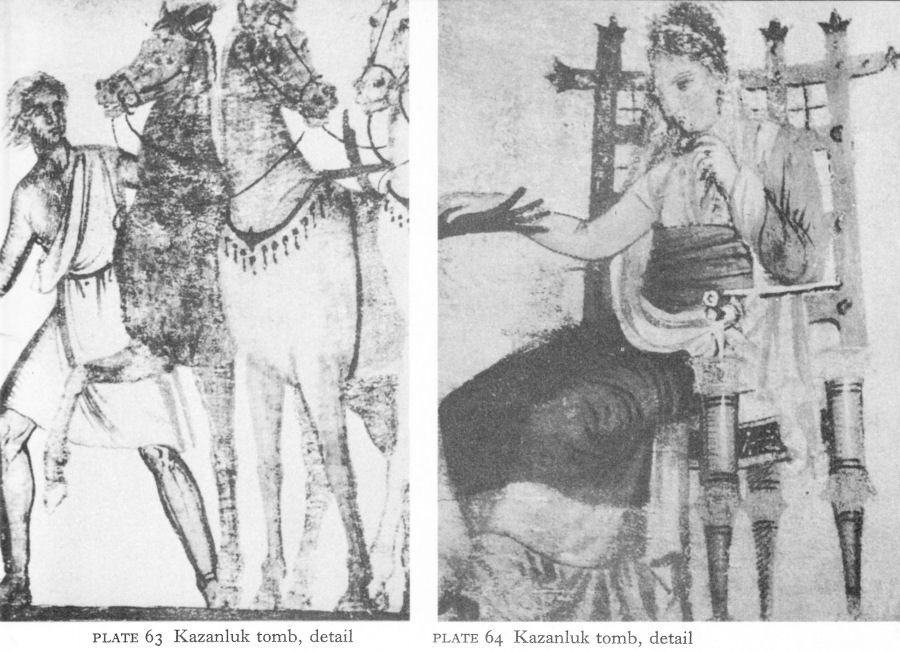
Plate 63 Kazanluk tomb, detail
Plate 64 Kazanluk tomb, detail
Behind the standing woman a male servant carries an oinochoe and a cup like that held by the man; two women follow, playing long pipes; behind, two saddle horses are accompanied by a groom and a warrior. On the left of the seated woman a female servant brings two boxes, the larger - a coffer - held shoulder high, the smaller by its handle. Behind, another woman carries a blue cloth, possibly a folded veil; then a groom (Pl. 63) leads four horses harnessed to a chariot. These horses back against the saddle horses to complete the circle. For all characters the convention is observed that men have dark and women fair skins.
In the top zone, separated from the main one by three bands of architectural motifs and one of animal heads and lotus flowers, three chariots, each drawn by two horses, are being driven at full gallop round the capstone. Their frenzy contrasts vividly with the calm of the scene below. A similar chariot motif occurs on the painted representation of a vase in the Muglish tomb.
Although the composition must have been the inspiration of a single artist, master craftsmen painted the most important parts, assistants did the rest. Even at best, the execution of the individual figures does not reach the highest standards of Early Hellenistic art. On the other hand, the ensemble ranks as a masterpiece of this or any period. Designed in perfect relationship to the peculiar beehive shape of the tomb, it achieves a three-dimensional quality whereby the people portrayed inhabit the burial chamber and participate in a sacred rite, one moment of which is brilliantly preserved. The dignity and serenity of a ritual once associated with the passing of the dead to another life still envelop and awe the spectator. No two-dimensional pictures can convey this, but unfortunately, despite all efforts, contact with the air is gradually causing the paintings to deteriorate, and lest they fade and crumble admission is stringently controlled.
![]()
102
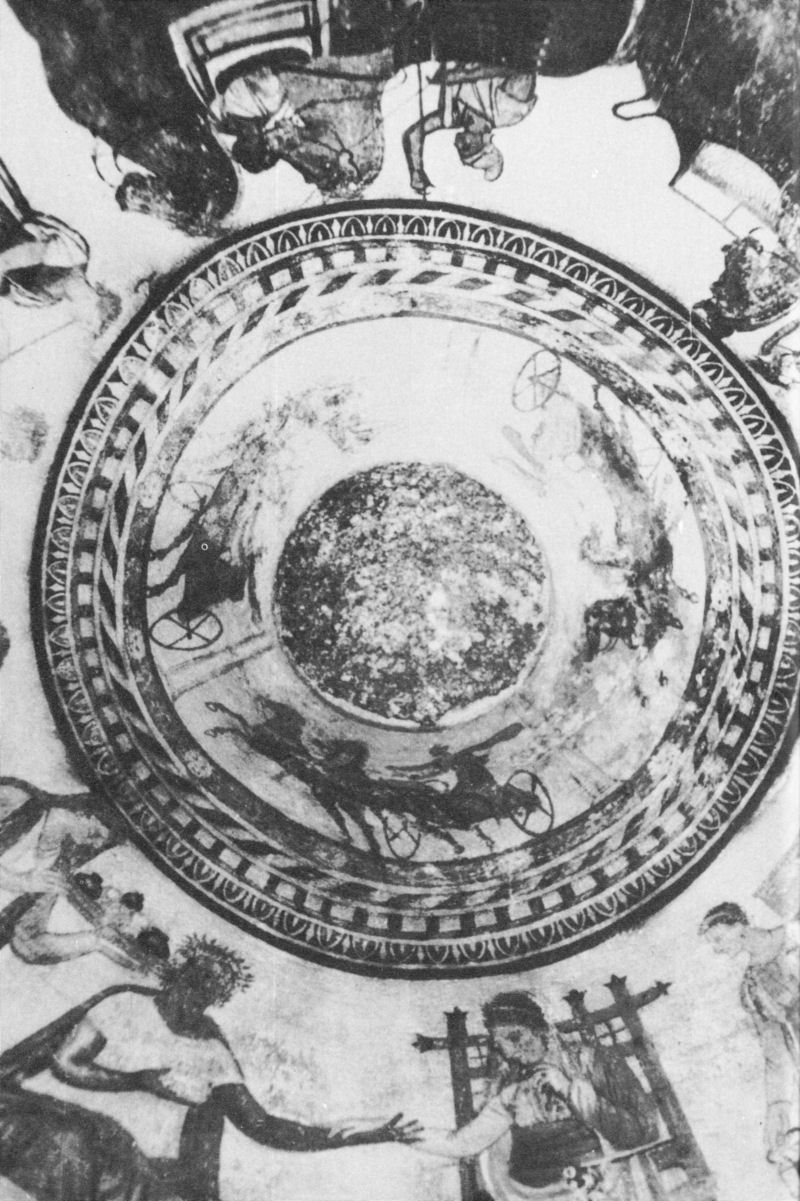
Plate 65 Kazanluk tomb, detail
![]()
103
The main scene is usually interpreted as indicating that this is the tomb of a princely husband and wife. The evidence of male and female burials in the tholos chamber supports this view, but it is wise to keep an open mind. The perfection of the composition within its unusual architectural frame leaves little doubt that the construction and decoration of the brick tombs were closely interconnected. Both architects and artists are with reason assumed to be of Greek origin from somewhere in the Hellenistic world. Thus the Kazanluk tomb presents a Thracian religious concept at least partially visualised in terms of Greek religious art - it is related to funerary feast stelai - but too little is known about the former to isolate its elements in this Thraco-Greek synthesis. Was the seated woman, as Herodotos describes and as happened at Vratsa, a favourite wife buried to accompany her husband? Or was she a royal priestess who in Douvanli, a century earlier, would have been given separate burial? Or was she, perhaps through east Greek influences, a Persephone-type goddess to whom the dead prince or king came after death - as in the early Thracian Horseman reliefs of Odessos? And to what extent did the scene reflect the prominent part played by women such as Berenike in the history of Seuthopolis? Another question without an answer from the limited evidence of a single tomb is how much the pervading atmosphere - restrained sorrow combined with serene dignity - represents a Thracian funerary concept or was the contribution of the foreign artists.
The Kazanluk tomb is generally dated, like those at Koprinka, to the late fourth or early third century, although on minor stylistic points D. P. Dimitrov has recently proposed the second quarter of the third century. [9] But the brick construction clearly links it with the Koprinka and Muglish tombs. Until there is a clue to the antecedents of this remarkable group and pending the full publication of Seuthopolis, the likelihood of a link between the tombs and the peak period of the only nearby city of which we know must remain a possibility; although further exploration of the area may bring to light another ‘city’, perhaps at Kazanluk itself, with greater claim to being the brickworkers’ centre.
VI. KABYLE
The site of Kabyle, mentioned in the Seuthopolis decree (p. 96), was identified almost a century ago by K. Jiriček and the Škorpil brothers as a terrace dominated by an acropolis-like hill near Yambol (Pl. 67). Some 100 kilometres east of Seuthopolis, it lies on an earlier course of the river Tundja, now a kilometre away, just about half-way between that city and the Black Sea coast.
Polemically referred to by Demosthenes as one of Philip II’s ‘miserable dens’, Kabyle was probably one of the Thracian centres where, like Philippopolis, Philip settled a Macedonian colony. Although long uninhabited, it has been left untouched until now, except for a salvage dig of one relatively undistinguished Late Hellenistic tumulus. The present excavations, begun in June 1972, must yield a rich reward. From unknown origins, Kabyle existed until its destruction by the Visigoths in a.d. 378, when the survivors may have moved to Diampolis (Yambol). Between the main centres of the Thracian plain and the south-western Black Sea cities, connected by river with the Aegean and over easy passes
![]()
104
of the Stara Planina with Odessos and the Greek cities farther north as well as the Danube, the site had exceptional economic and strategic advantages. That it profited by these is shown by the Seuthopolis inscription and by its issue of silver and bronze coins in the third or second century b.c. Kabyle may also have minted coins in the second half of the third century for the Celtic king Kavaros, perhaps as a form of tribute. [10] The city was occupied by the Roman expedition of 72 b.c. and was probably later renamed Diospolis.
VII. BEROE AND ITS VICINITY
Another centre with naturally advantageous communications, Beroe (Stara Zagora) could hardly fail to be important. Although the present city stands on a Roman foundation, officially entitled Augusta Trajana but more generally known as Beroe, it replaced an older settlement of this name in the neighbourhood, possibly on the river Bedechka, a kilometre from Stara Zagora. Here within a tiny area ‘as much imported black-glaze pottery as was found in the whole of Seuthopolis’ [11] was discovered by chance, almost all in small fragments. Although unpublished, pieces have been tentatively dated to the fifth to second centuries b.c. All that we have of Thracian Beroe therefore - the name suggests that in the fourth century it was another of Philip II's colonies - is a probable rubbish dump. While this is in itself valuable, a planned search of the immediate neighbourhood may uncover another major pre-Roman settlement.
The presence nearby of two rich tumulus burials, both cremations and dated by their contents to about the first century b.c. or a little later, suggests that Beroe survived the Celtic invasion without undue harm, and its Roman successor dates only from the second century a.d. The grave goods show that both burials were male. In one, a large bronze or copper cauldron contained objects of Thracian and imported origin, in this case not Greece but Italy. There was a silver vase of the ‘Boscoreale’ type and a silver sieve inscribed in Latin that it had been made for Rufius by Sextus Maetennius. In addition, besides fragments of Thracian scale armour, other armour, arms, and harness, there were four silver-gilt phalerae, or plaques, embossed in high relief, which can hardly be other than purely Thracian work.
At the time of writing, only one phalera has been published (Pl. 66); another has survived whole, but one or both of the others suffered severe damage in the crematory fire. The central figures of the published phalera - 17.8 centimetres across - may be Herakles and the Nemean lion. If so, while the execution is skilful, the myth, which was similarly represented on a fourth-century phalera found near Panagyurishte, had little significance for the craftsman, such is the tameness of the protagonists. The six beasts formally arranged round this scene show he was more at home with myths of another kind. Four are griffons, eagle-headed at the top, lion-headed at the bottom. Those between could be canine or feline. Their collars are perhaps a symbolic device or indicate their use for hunting. It is doubtful, in view of their evident ferocity, that they are domestic animals. The other undamaged phalera, only very slightly smaller, is probably a companion piece; it had no human figure and the fantastic beasts differ in kind and arrangement.
![]()
105
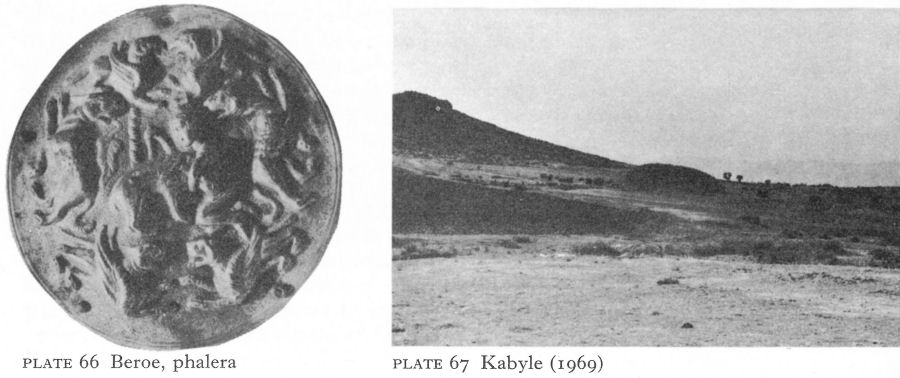
Plate 66 Beroe, phalera
Plate 67 Kabyle (1969)
While these are the first phalerae of their kind found in Bulgaria, examples very similar in decoration, workmanship, and size are known outside the country. Two, unfortunately of unknown origin, are in the Bibliothèque Nationale, Paris; another came from a peat bog in Helden, Holland, and 13 were found with other objects in an urn on the island of Sark early in the eighteenth century. Although the Sark hoard was later lost, excellent drawings recently came to light and have been fully discussed by D. F. Allen, the phalerae being related to the other examples, including those from Stara Zagora. [12] Allen concludes that all are likely to have originated in Thrace, those in the west having in the first place been used by Thracian auxiliaries of the Roman armies. Comparing them with earlier metalwork, it is not difficult to recognise the Thracian tradition of animal art.
These phalerae, so much larger than the harness appliqués from earlier Thracian graves, must have been differently used. One might have been attached to a horse’s chest harness, but they are more likely to have decorated the saddle cloth or the horse’s flanks. It is also possible that Thracian nobles wore them on coats of mail or ceremonial attire, a c. first-century b.c. form of pectoral.
The other tumulus burial was similarly a warrior’s grave. With the ashes was a gold ring, probably Greek in origin; a kneeling archer with a plumed helmet drawing his bow was carved on the red stone of the bezel. There were also remains of a bronze helmet, spearheads, and an iron double-edged sword with an ornate silver open-work scabbard which, according to its Greek inscription, was made by Seuthes of Paiagara. The site of Paiagara is unknown, but the scabbard is evidence of the skill of a Thracian silversmith who worked there and additional proof of Thracian craftsmanship in this unsettled period.
VIII. CHERTIGRAD
While cities and rulers adjusted with varying success to the Roman presence, in the conqueror’s eyes the peasantry were simply a source of military manpower. Tacitus [13] writes of the last struggle for independence of one group of ‘Thracian tribesmen, who, on their mountain peaks lived uncivilised and proportionately
![]()
106
bold’ and ‘refused to tolerate the military levies and to devote the whole of their ablebodied manhood to the Roman service’. Instead ‘they pointed to their strongholds perched upon the crags, and to the parents and wives placed in them for refuge, and threatened a war intricate, arduous, and bloody’.
Tacitus refers to events which took place in a.d. 26. Such a stronghold, one of many still to be found in the less accessible mountain regions, is Chertigrad, now being excavated. It stands on a peak about 1,300 metres above sea level on the northern slopes of the Stara Planina, in the region of the upper Vit, about two hours on foot from the nearest village and only accessible from the southwest. This approach was defended by a dry-stone wall, about 2.20 metres wide, faced on both sides with well-laid local stone with a filling of small stones, a substantial barrier. As no material had been taken away for re-use, the original height could be estimated - 3 to 3 1/2 metres. There were two building phases, both using the same method. A rectangular platform, 2.40 by 1.40 metres, built into the inside of the wall, defended a narrow entrance between its south end and the cliff edge. Approached by a natural ramp below the wall, this entrance was apparently closed when necessary by improvised means.
About 15 single-roomed buildings stood in small groups inside the walls, one near the entrance probably serving a defensive purpose. The largest, 5.80 by 8.60 metres, with three sides of well-laid dry stone walling and a fourth of rough stone and mud construction, was perhaps some kind of public building. On the east cliff, an artificially cut niche was found, oriented to receive the sun’s first rays and almost certainly created for a religious purpose.
Finds which could help to date the fortress have so far been meagre. Pending completion of the excavations, it seems that it was in existence in the Hellenistic period, continued under the Roman, with a place in the later imperial defence strategy, and was finally abandoned in the second half of the sixth century a.d.
V. Velkov rightly points out that the fortress is typical of the background against which Tacitus describes a last stand against the Romans and the ending of the old order - or disorder - and the beginning of the new.
In a.d. 26, Poppaeus Sabinus, with a Roman legion from Moesia and Thracian auxiliaries in the service of a client-king, moved against some Thracian tribesmen
. . . concentrated in the wooded gorges. A few, more daring, showed themselves on the open hills, but were driven from them without difficulty, when the Roman commander advanced in battle-order, though cover was so near that little barbarian blood was spilt. Then, after fortifying a camp on the spot, Sabinus . . . made himself master of a narrow mountain-ridge running without a break to the nearest tribal fortress, which was held by a considerable force of armed men and irregulars. Simultaneously, he sent a picked body of archers to deal with the bolder spirits who, true to the national custom, were gambolling with songs and war-dances in front of the rampart. The bowmen, so long as they operated at long range, inflicted many wounds with impunity; on advancing closer, they were thrown into disorder by an unlooked-for sally . . .
. . . The camp was then moved a stage nearer the adversary; and the Thracians . . . [Roman auxiliaries] were left in charge of the earlier lines. They had licence to ravage, burn, and plunder, so long as . . . the night [was] spent
![]()
107
safely and wakefully behind entrenchments. At first, the rule was kept: then . . . they began to leave their posts for some wild orgy, or lay tumbled in drunken slumber. The enemy, therefore, who had information of their laxity, arranged two columns, by one of which the raiders were to be attacked, while another band demonstrated against the Roman encampment; not with any hope of capture, but in order that, amid the shouting and the missiles, every man engrossed by his own danger might be deaf to the echoes of the other conflict. Darkness, moreover, was chosen for the blow, so as to intensify the panic. The attempt on the earthworks of the legions was, however, easily repelled: the Thracian auxiliaries, a few of whom were lying along their lines, while the majority were straggling outside, lost their nerve . . . and were cut down all the more ruthlessly because they were branded as renegades and traitors , . .
On the following day, Sabinus paraded his army in the plain, in the hope that the barbarians, elated by the night’s success might venture battle. As they showed no signs of descending from their stronghold ... he began their investment, with the help of the fortified posts . . . ; then drew a continuous fosse and breastwork, with a circumference of four miles; and lastly, step by step, contracted and tightened his lines of circumvallation, so as to cut off the supplies of water and forage; while an embankment began to rise, from which stones, spears, and firebrands could be showered on the no longer distant enemy. But nothing told on the defence so much as thirst, since the one spring remaining had to serve the whole great multitude of combatants and non-combatants. At the same time, horses and cattle . . . were dying for lack of fodder; side by side with them lay the bodies of men, victims of wounds or thirst, and the whole place was an abomination of rotting blood, stench, and infection.
To the confusion was added the last calamity, discord; some proposing surrender, some to fall on each other and die; while there were those, again, who commended, not unavenged destruction, but a last sortie . . . The younger fighting men were divided between Tarsa and Turesis . . . Tarsa, crying out for a quick despatch, a quietus to hope and fear alike, gave the example by plunging his weapon into his breast . . . Turesis and his followers waited for the night: a fact of which the Roman commander was not ignorant . . . Night was falling, with a storm of rain; and the wild shouting on the enemy’s side, alternating as it did with deathly stillnesses, had begun to perplex the besiegers, when Sabinus made a tour of his lines and urged the men [not] to be misled . . . every man should attend to his duties without budging from his post or expending javelins on an illusory mark.
Meanwhile, the barbarians, speeding down in their bands, now battered the palisades with hand-flung stones, stakes pointed in the fire, and oak-boughs hewn from the tree; now filled the moats with brushwood, hurdles, and lifeless bodies; while a few, with bridges and ladders . . . advanced against the turrets, clutching them, tearing them down, and struggling hand to hand with the defenders. The troops, in return, struck them down with spears, dashed them back with their shield-bosses, hurled on them siege-javelins and piles of massive stone. On each side were incentives enough to courage: on ours, the hope that victory was won, and the more flagrant ignominy which
![]()
108
would attend a defeat; on theirs, the fact that they were striking the last blow for deliverance - many with their wives and mothers close at hand and their lamentations sounding in their ears. Night, screening the audacity of some, the panic of others; blows dealt at random, wounds unforeseen; the impossibility of distinguishing friend from foe; cries echoed back from the mountain ravines, and so coming apparently from the rear - all this had produced such general confusion that the Romans abandoned some of their positions as forced. Yet actually none but a handful of the enemy made their way through; while the remainder, with their bravest either dead or disabled, were at the approach of daylight pushed back to their stronghold on the height, where surrender at last became compulsory. [14]
Further operations were soon suspended by the ‘premature and stern winter of the Haemus range’. Poppaeus Sabinus received a triumph, and 20 years later Thracia was formally constituted a Roman province.
NOTES
1. Dumont, A., Mélanges d'archeologie et d’epigraphies Paris, 1892, 196.
2. Botousharova, L., Arh VII/3, 1965, 3.
3. Botousharova, L. and Kolarova, V., God. Plovdiv VII, 1971, 75 ff.
4. Botousharova, L., God. Plovdiv V, 1963, 77 ff.
5. Diodorus Siculus, XXI, 12.
6. Gerasimov, T., IBAI XIX, 1955, 123 ff.
7. IGB III/2, 1731.
8. Richter, G. M. A., The Furniture of the Greeks, Etruscans and Romans, London, 1966, 22, Fig. 79.
9. Dimitrov, D, P., Arh VIII/2, 1966, 1 ff.
10. Gerasimov, T., IBAI XXII, 1959, 111 f.
11. Nikolov, D., Arh IX/4, 1967, 33.
12. Allen, D. F., Archaeologia CIII, 1971, 1 ff.
13. Tacitus, Annals, Bk. IV, xlvi, trans. Jackson, J., London, 1963, 83, 84.
14. Ibid., Bk. IV, xlvii-li, 85-93.